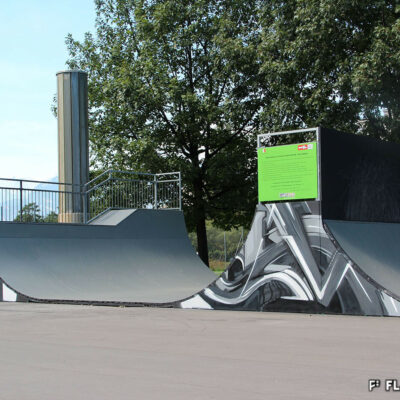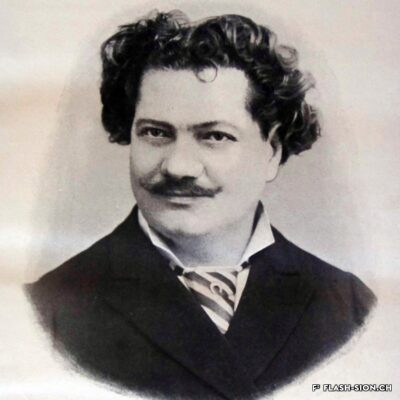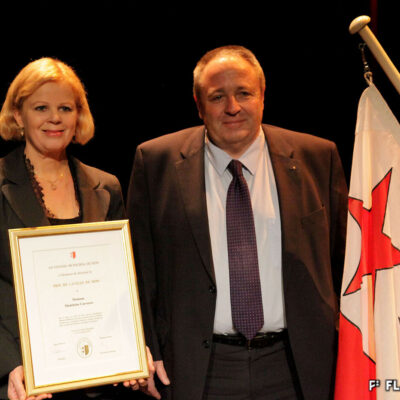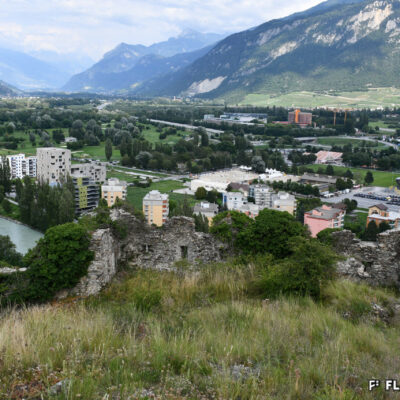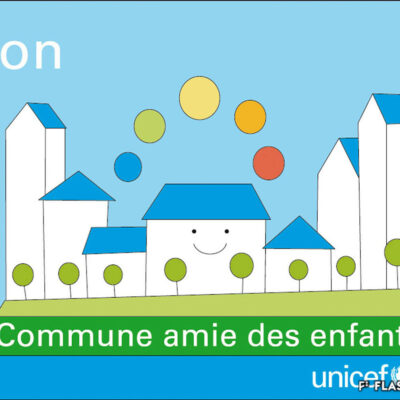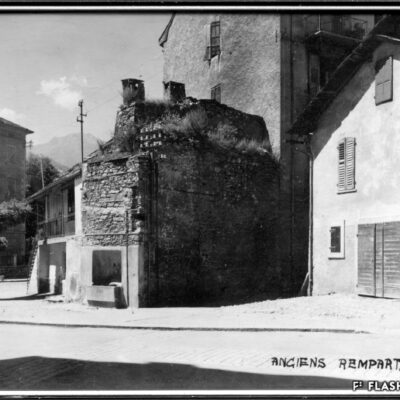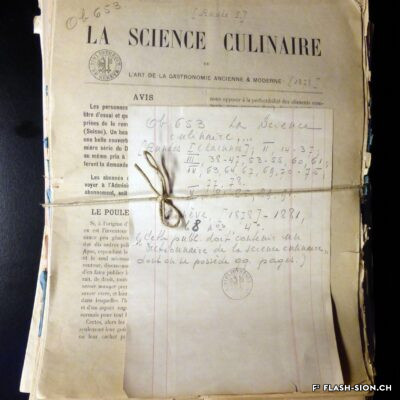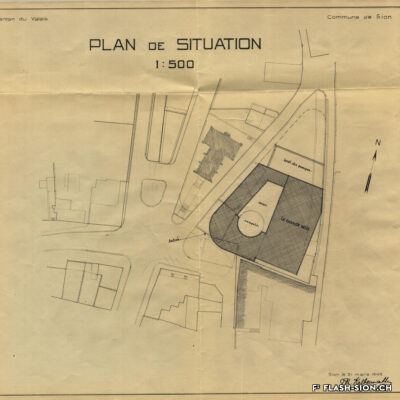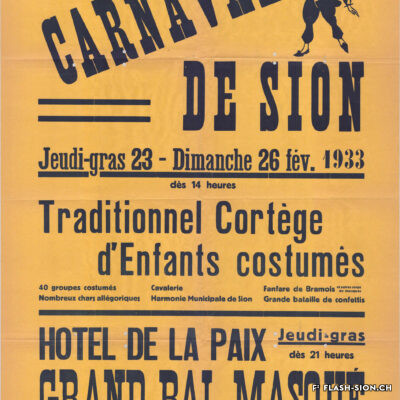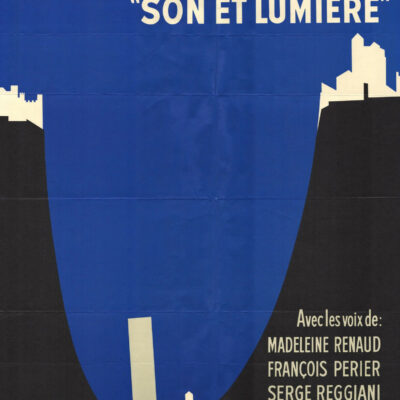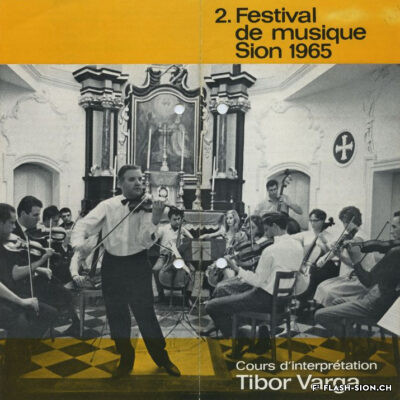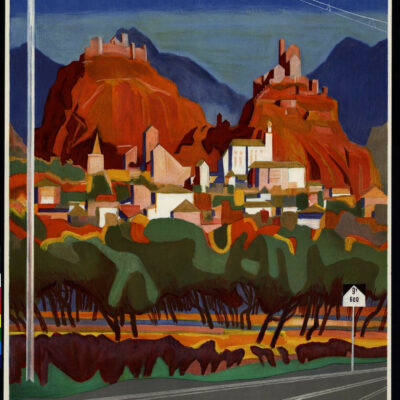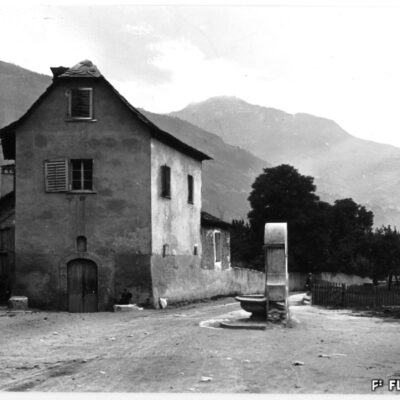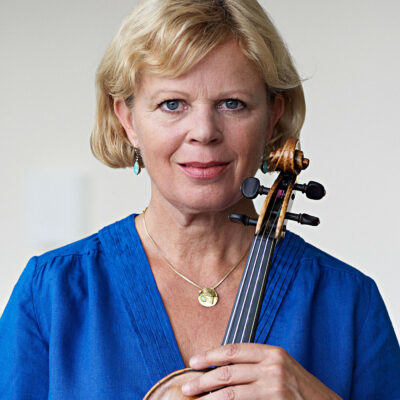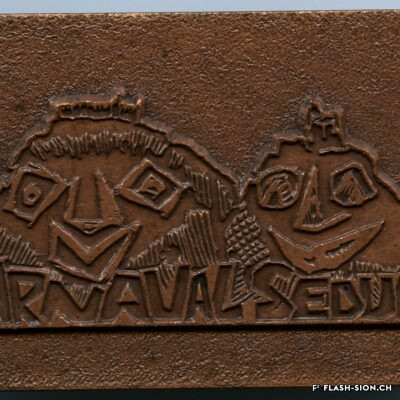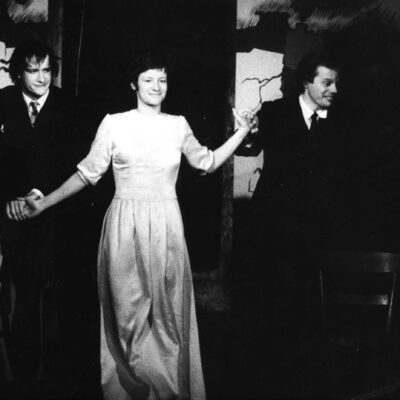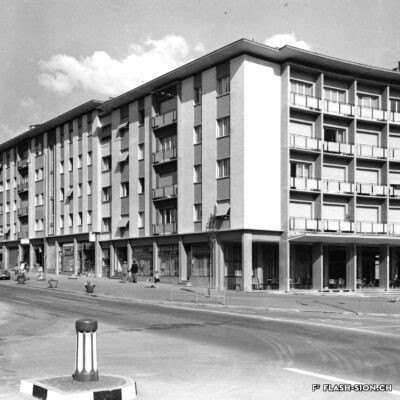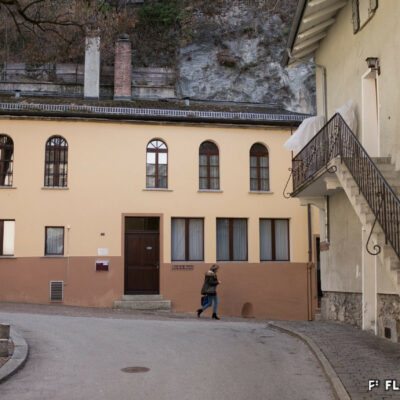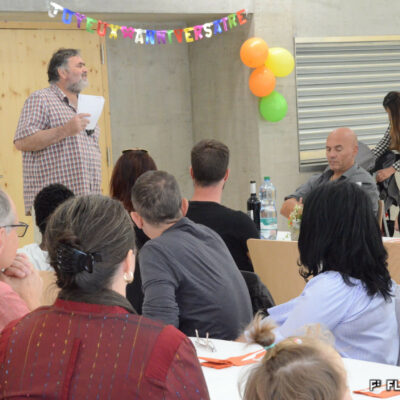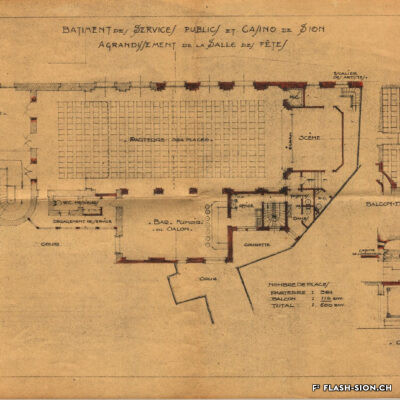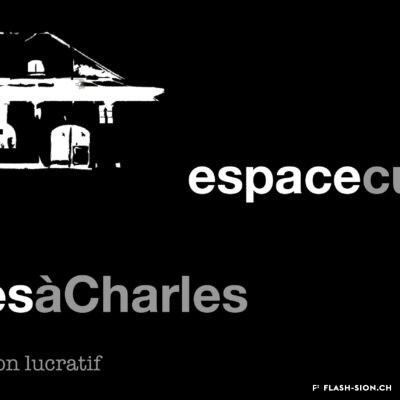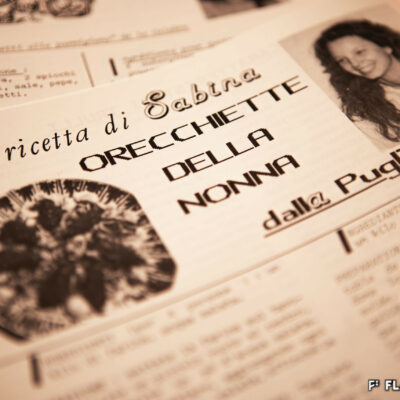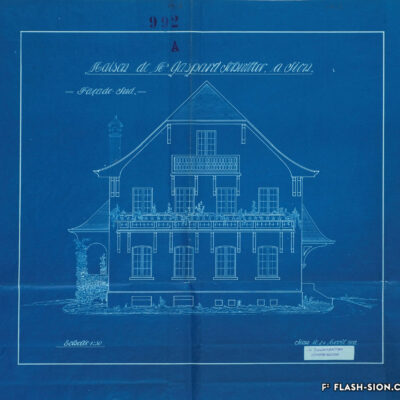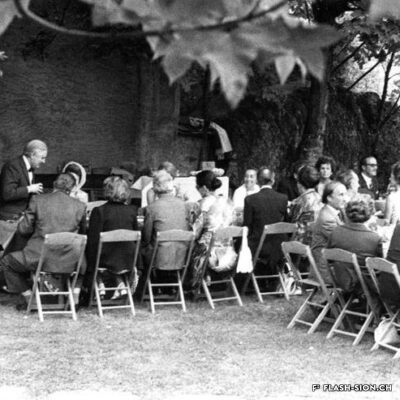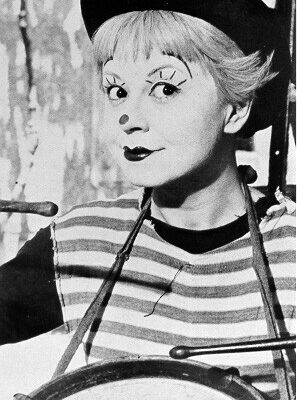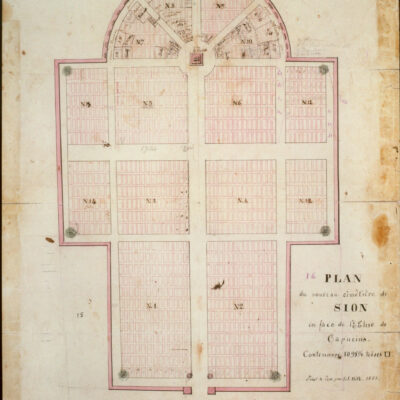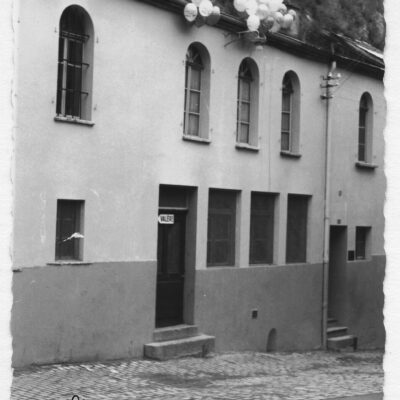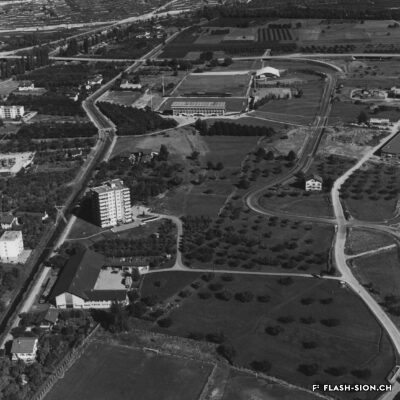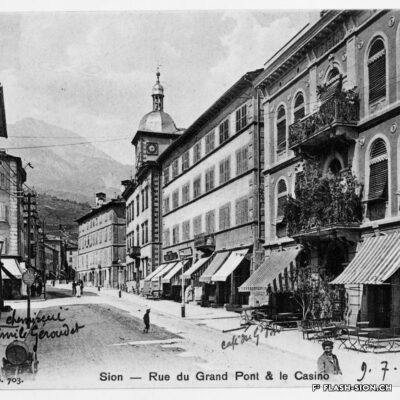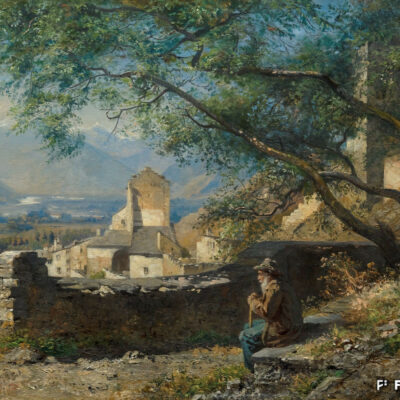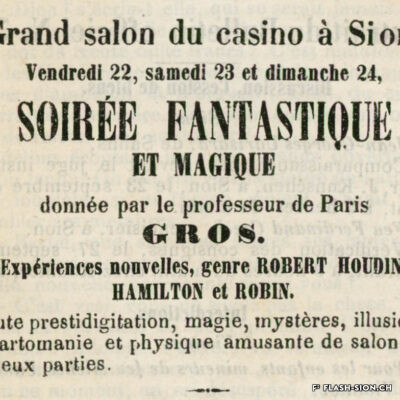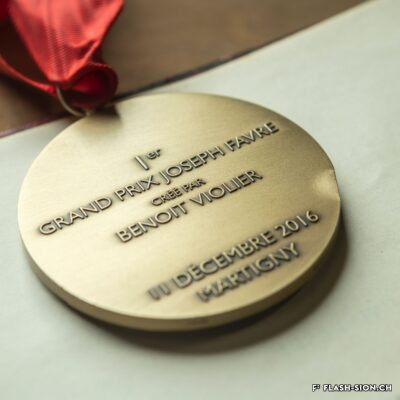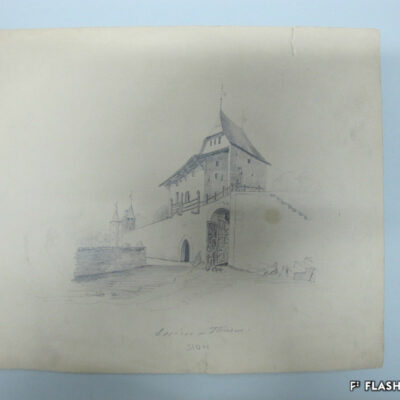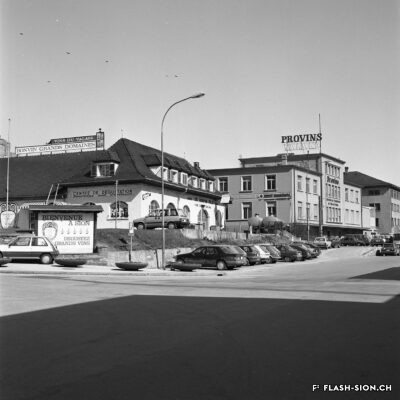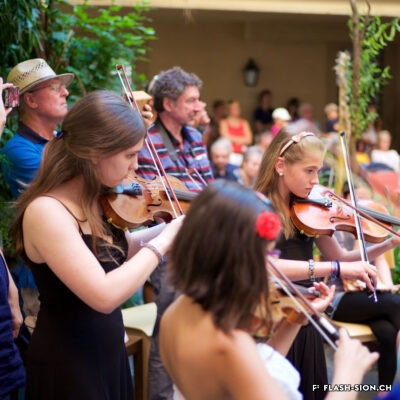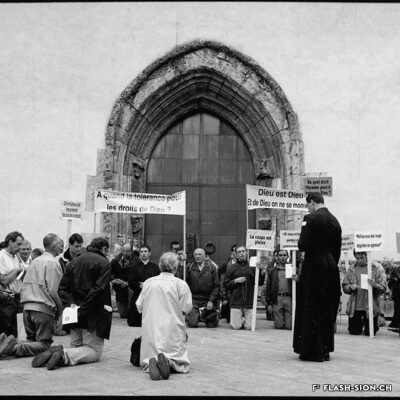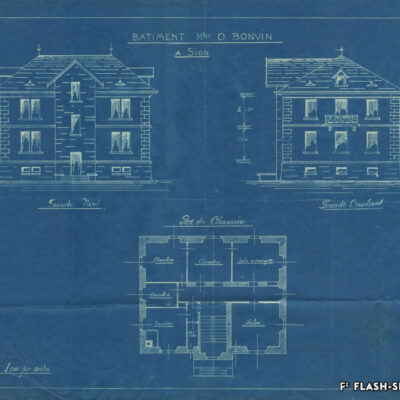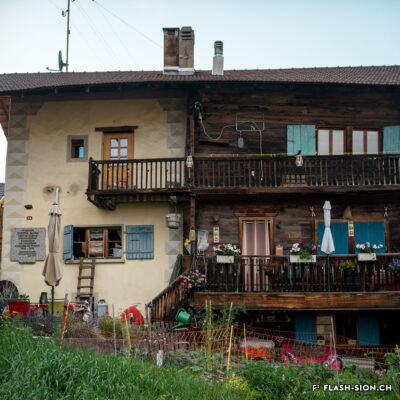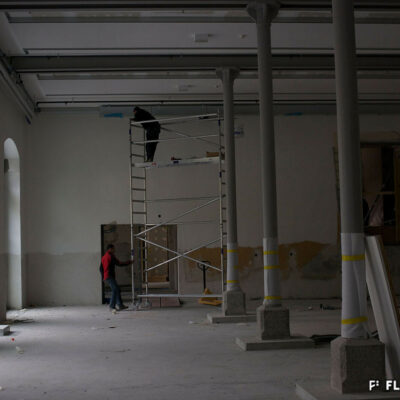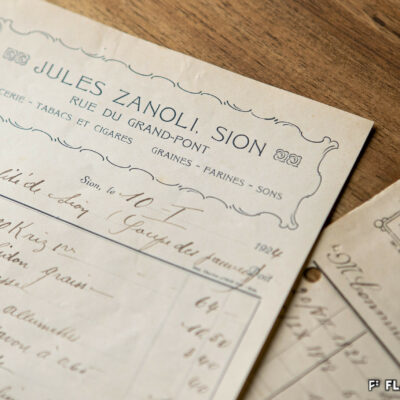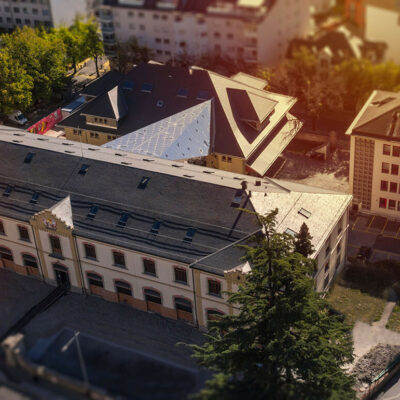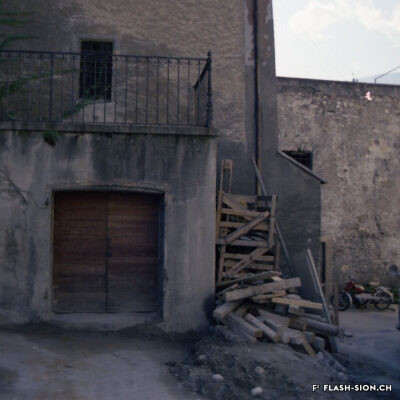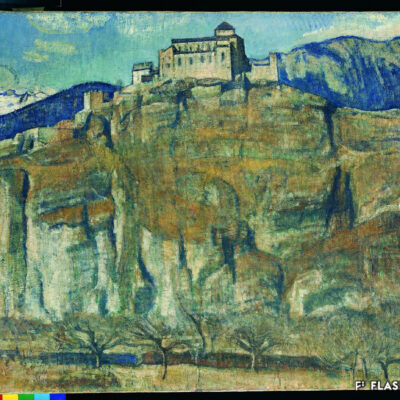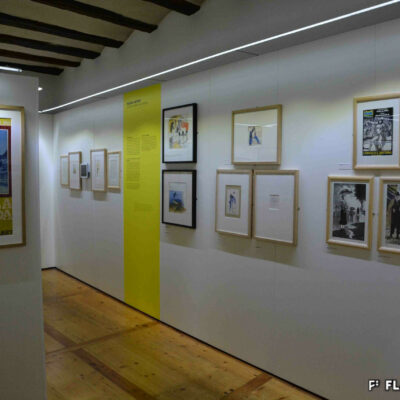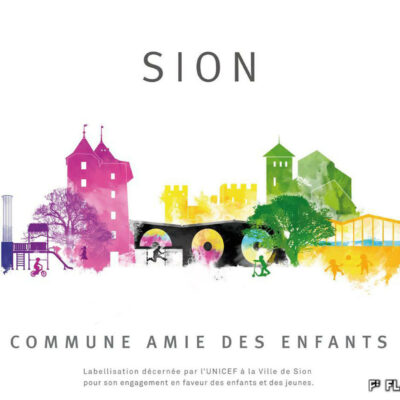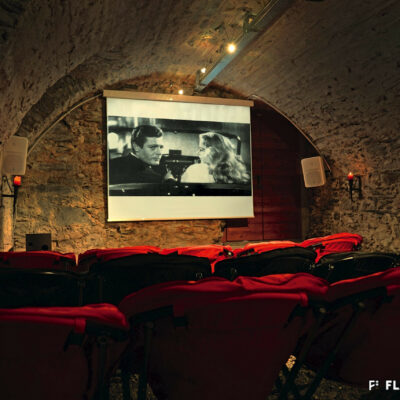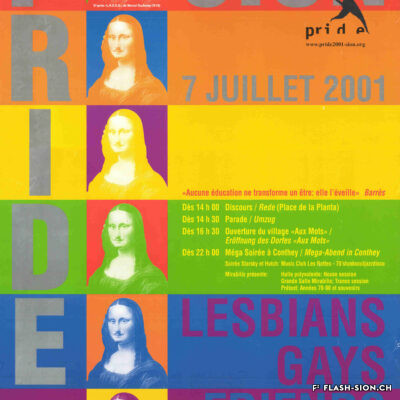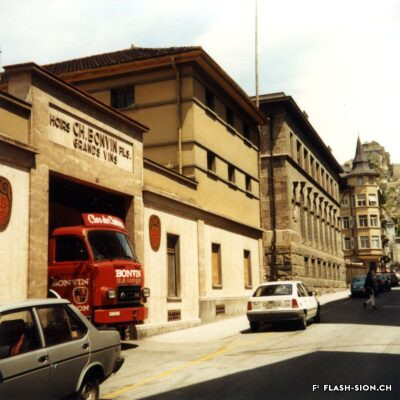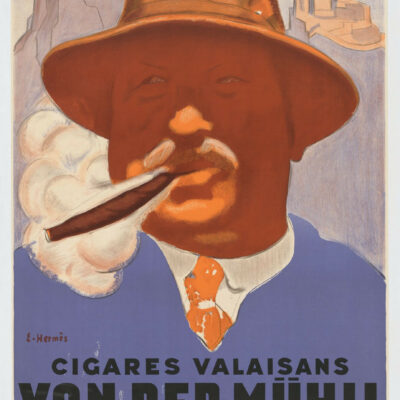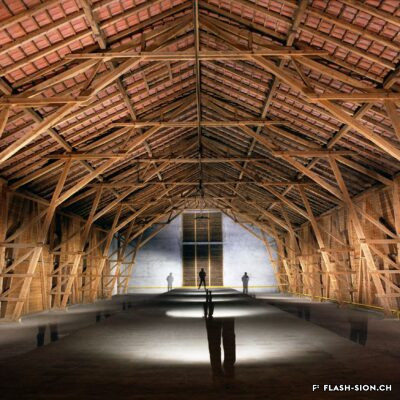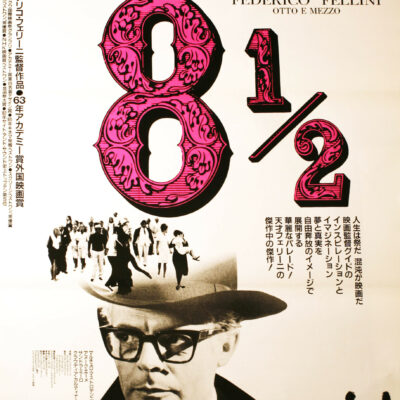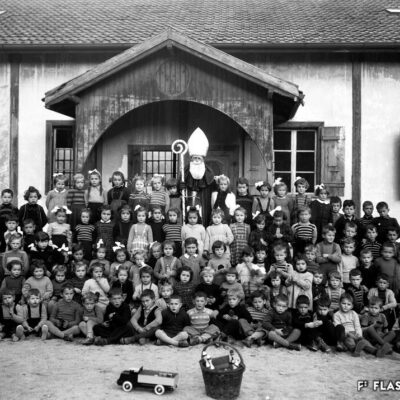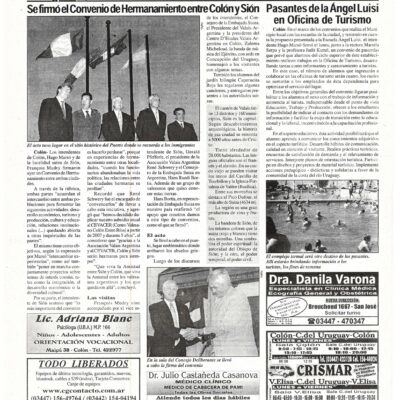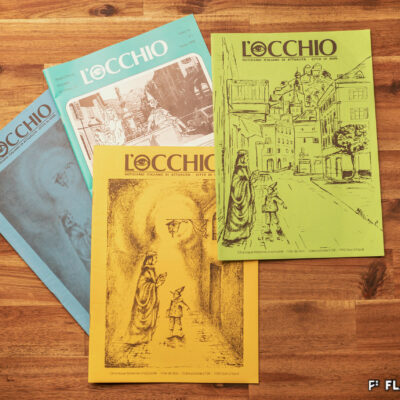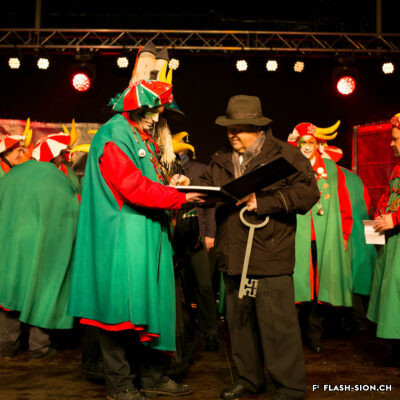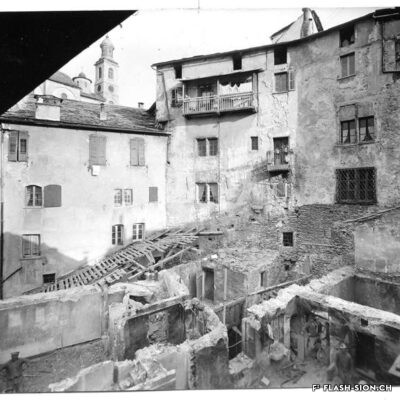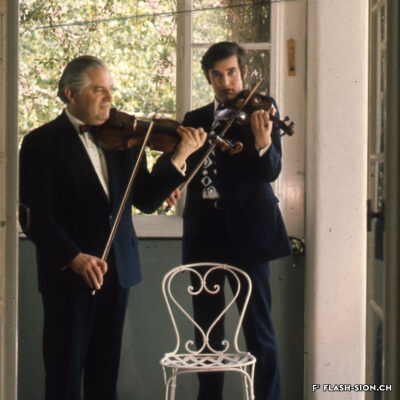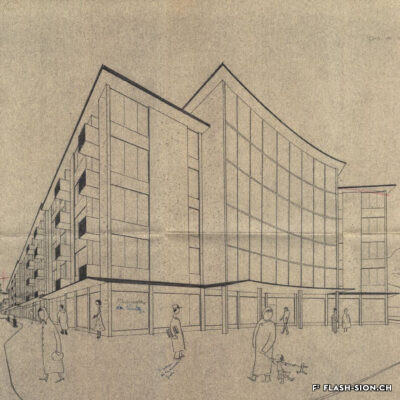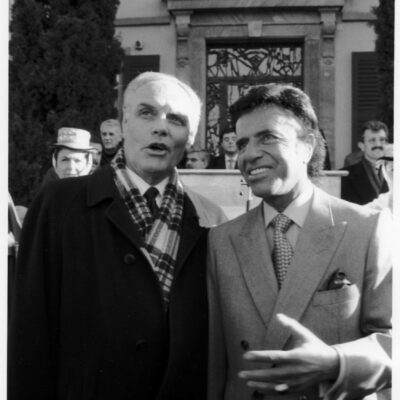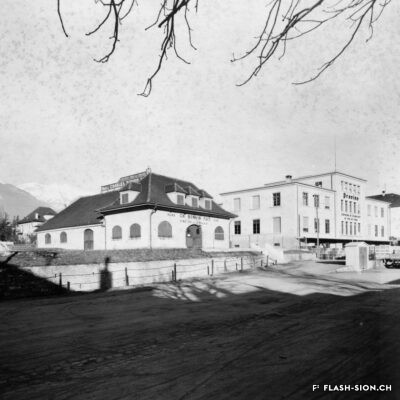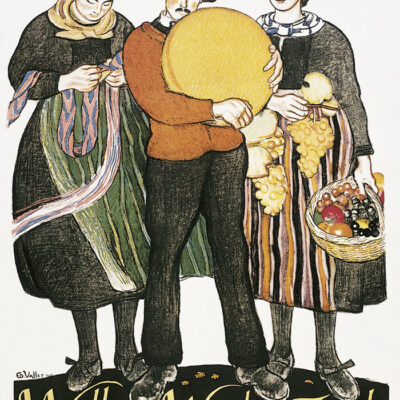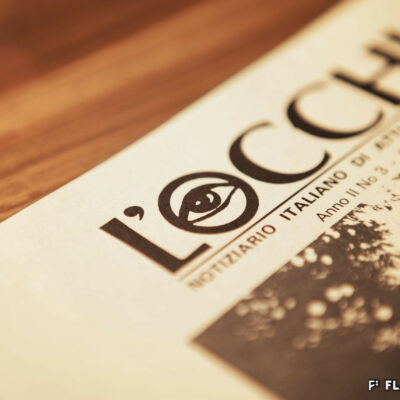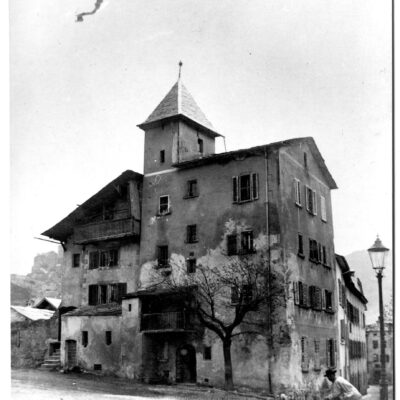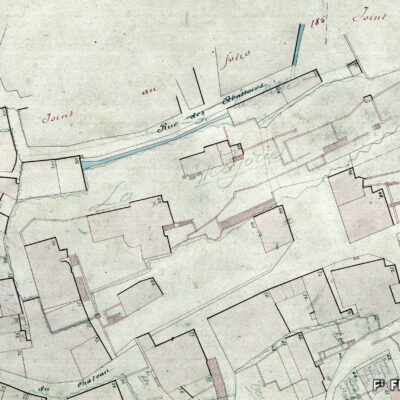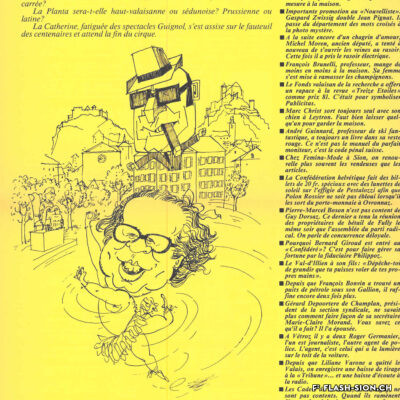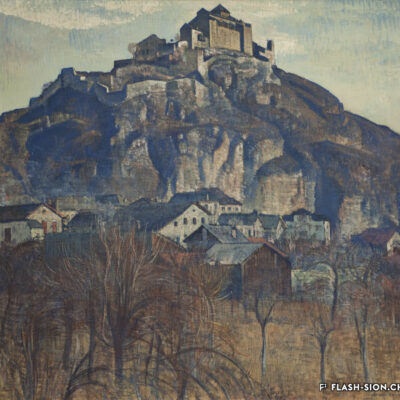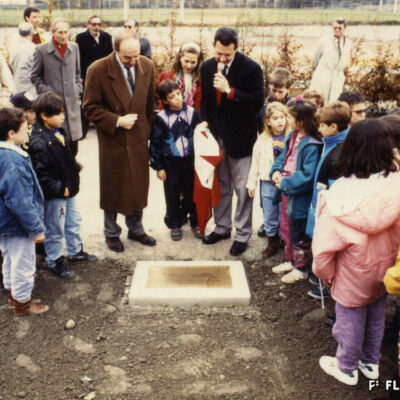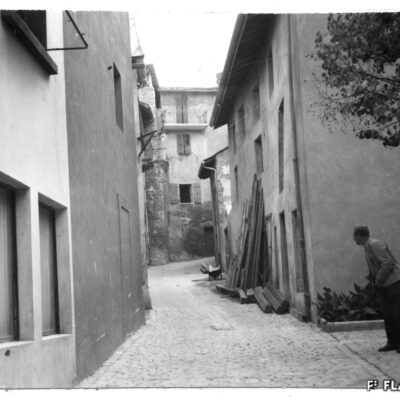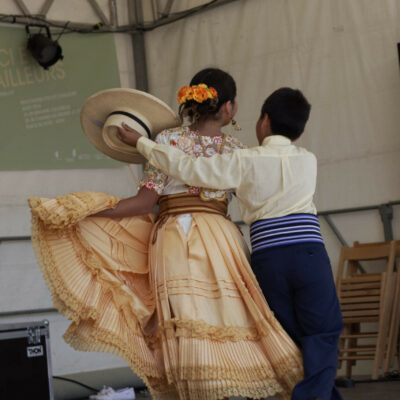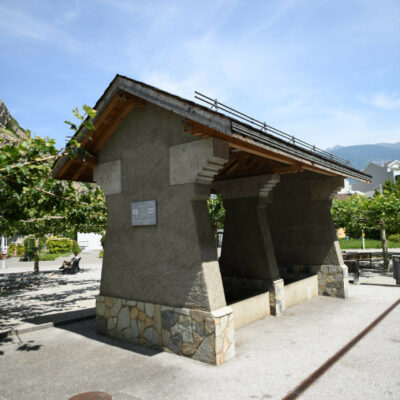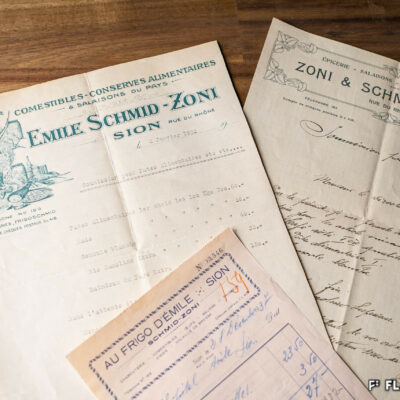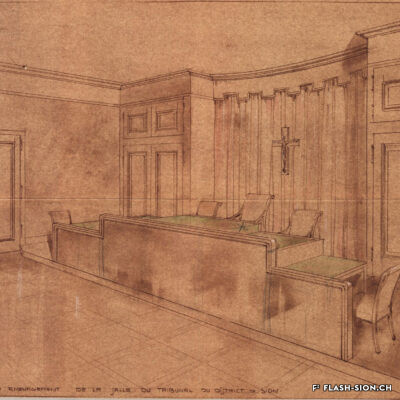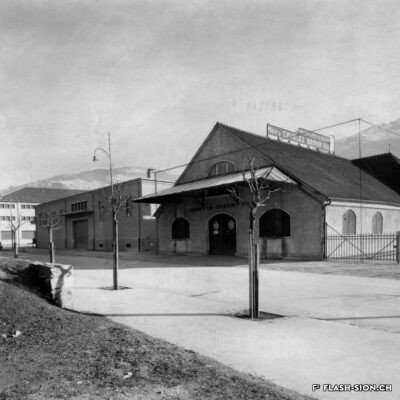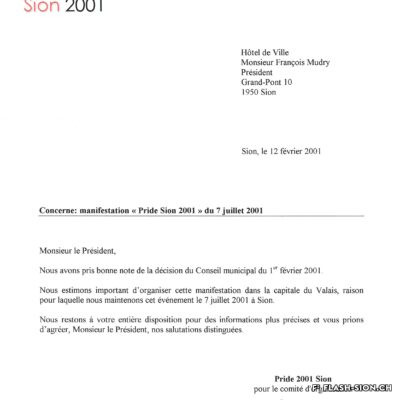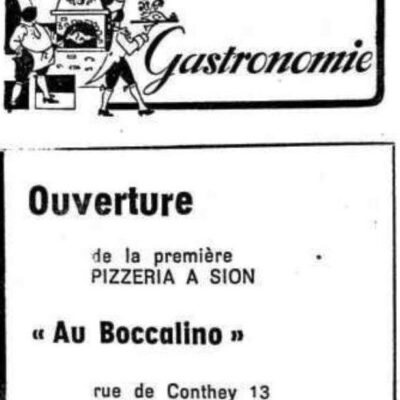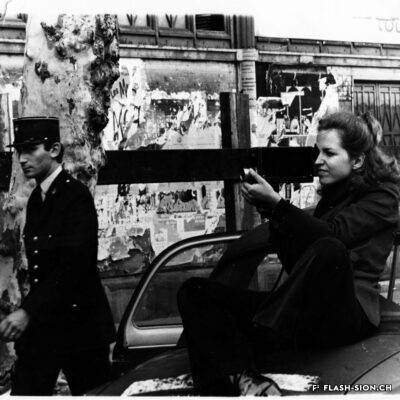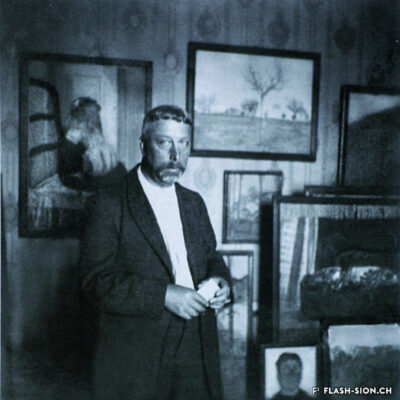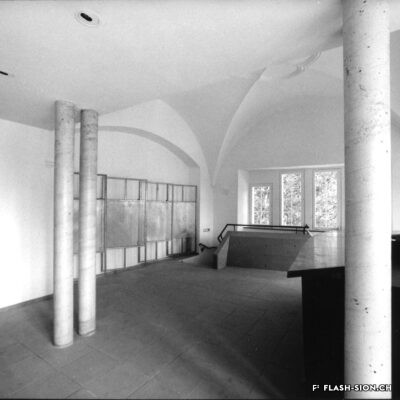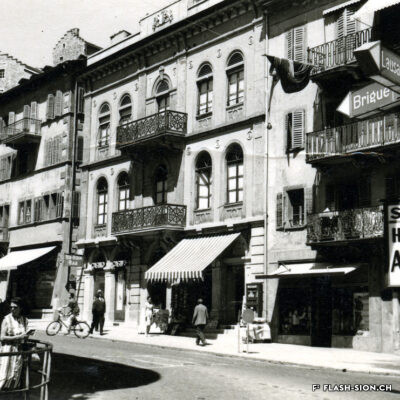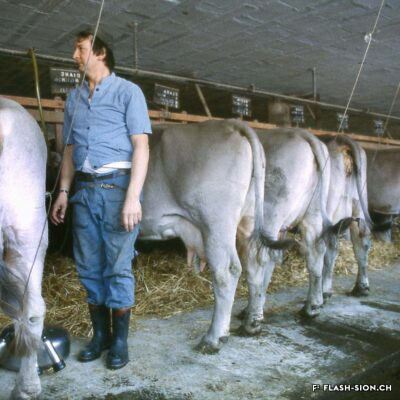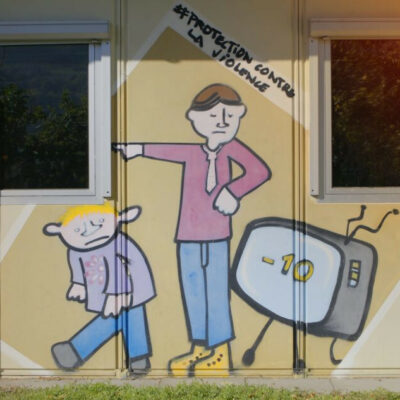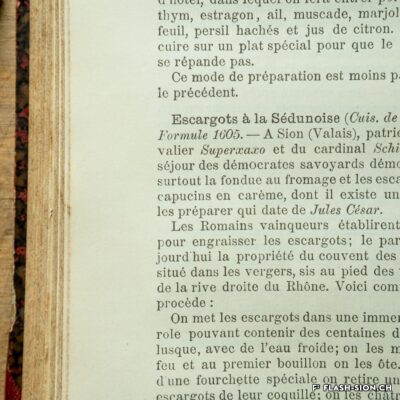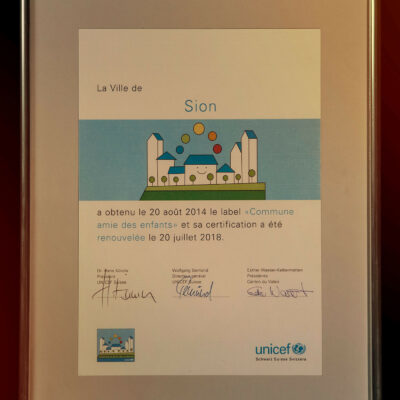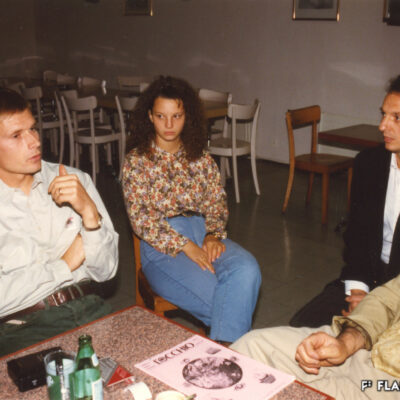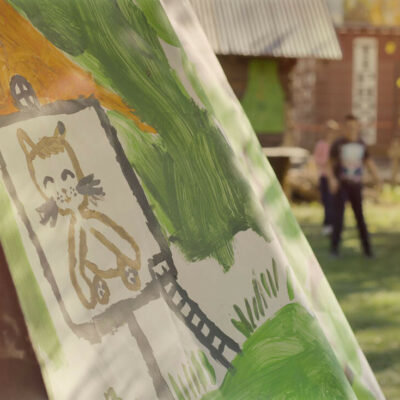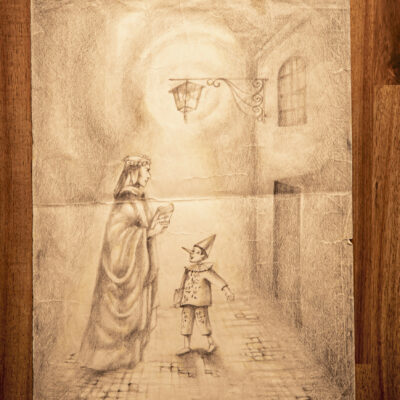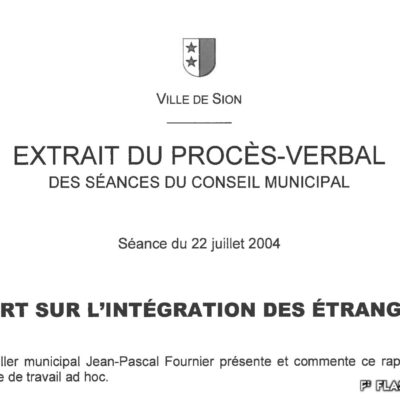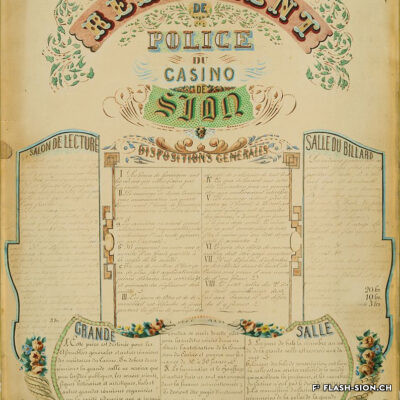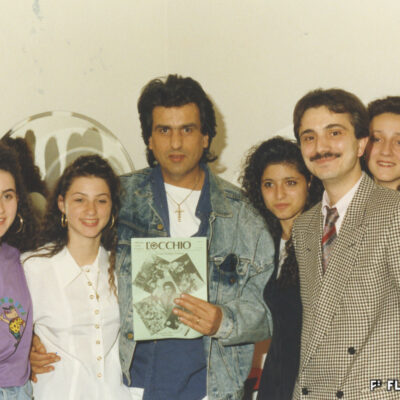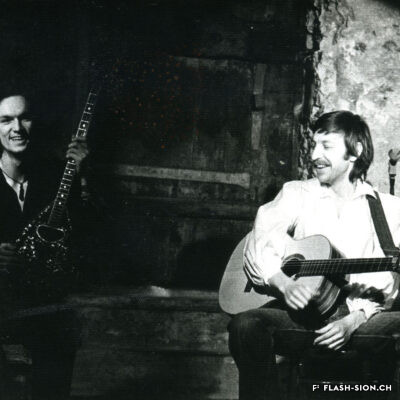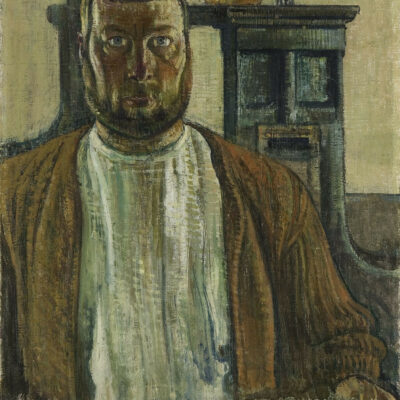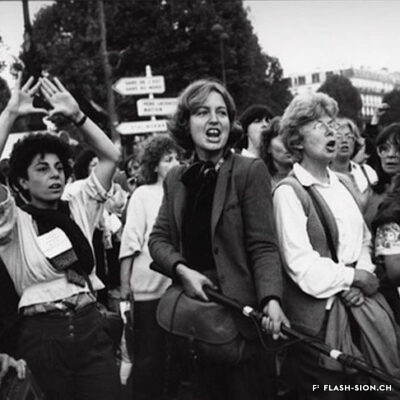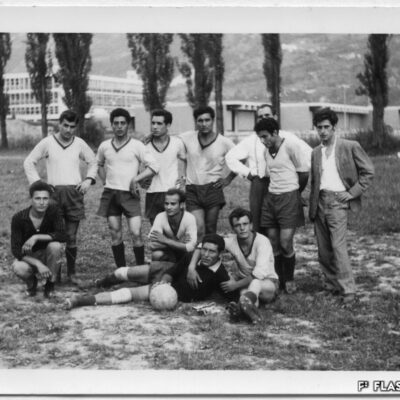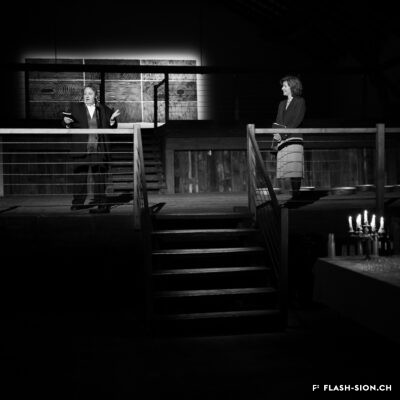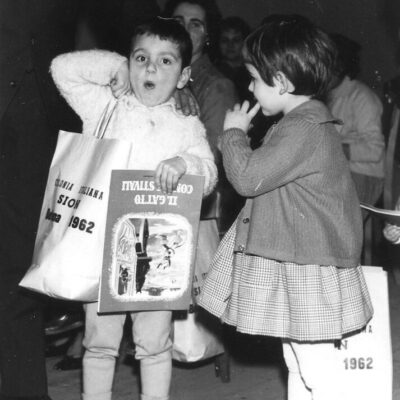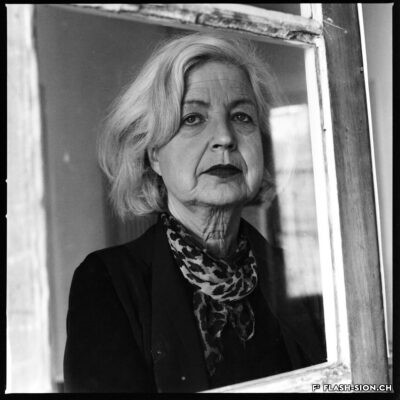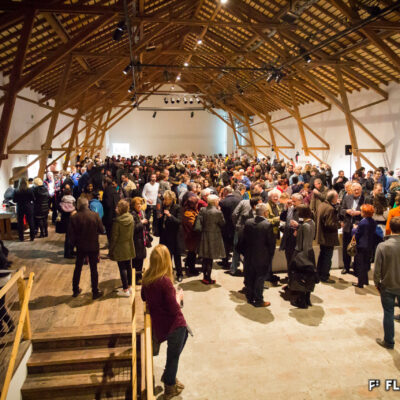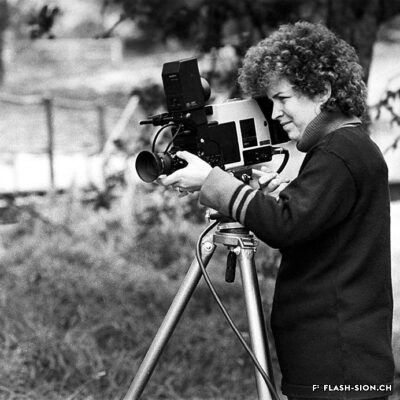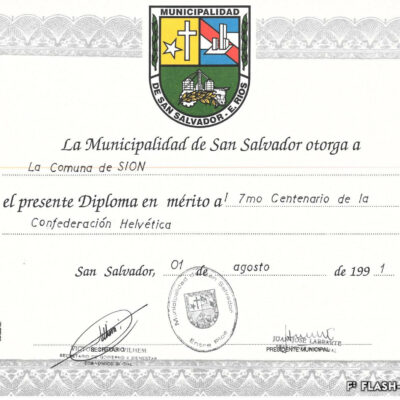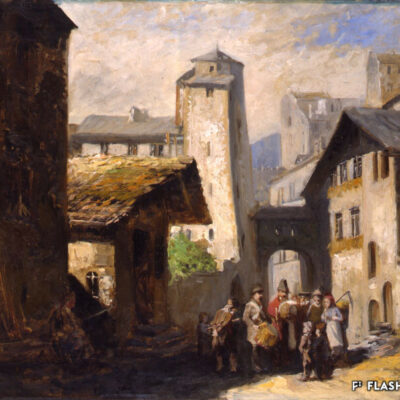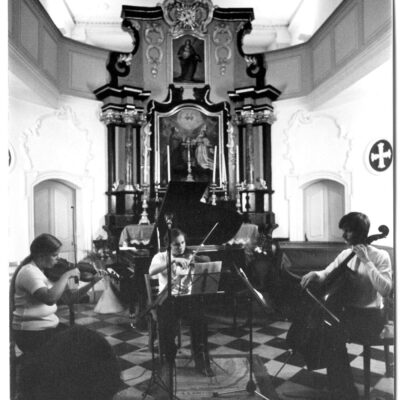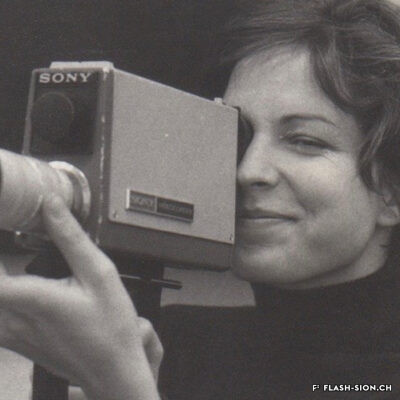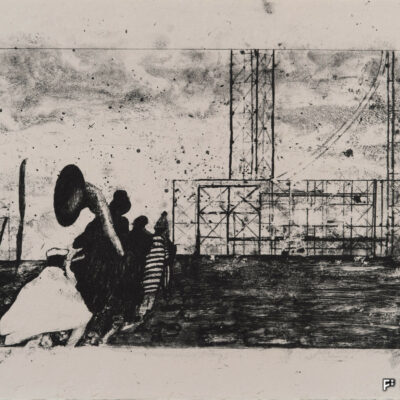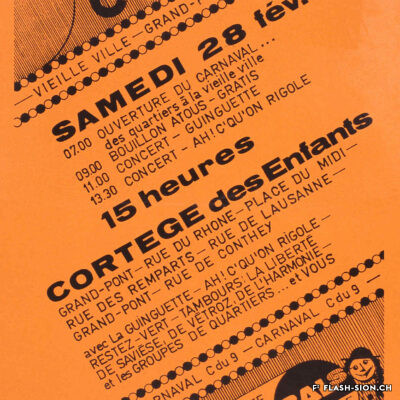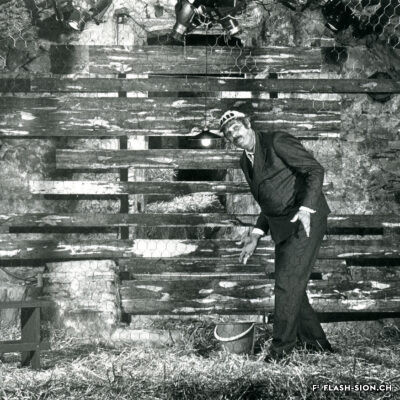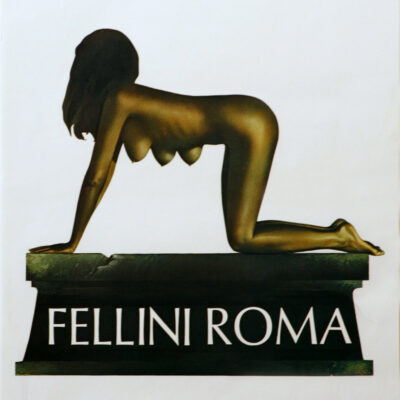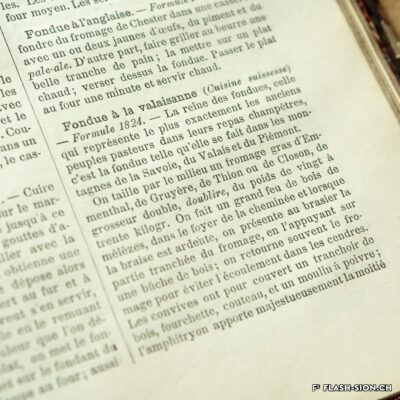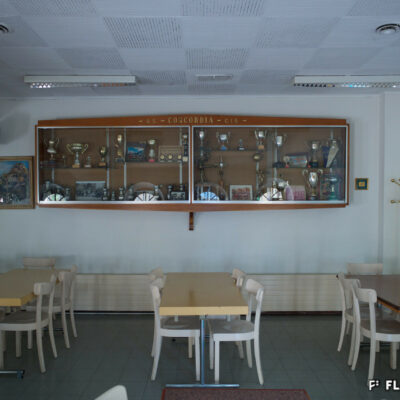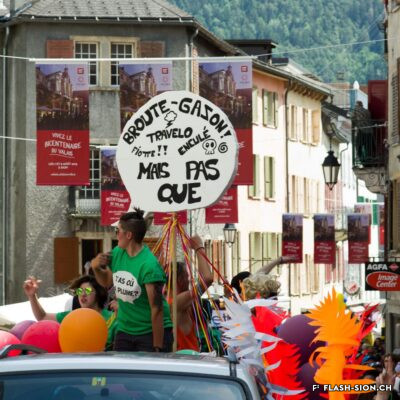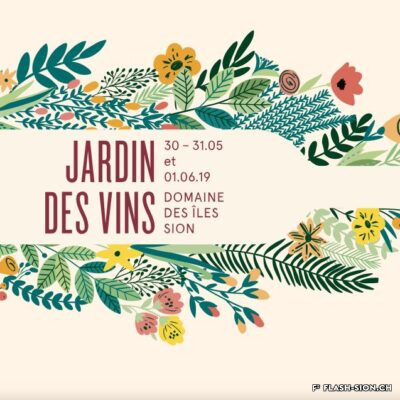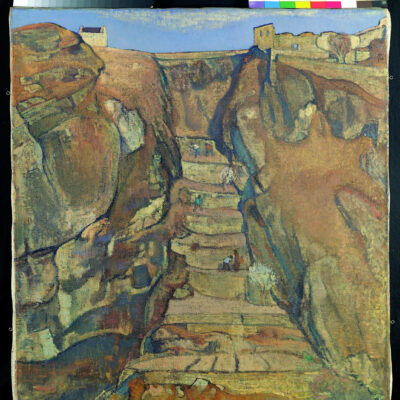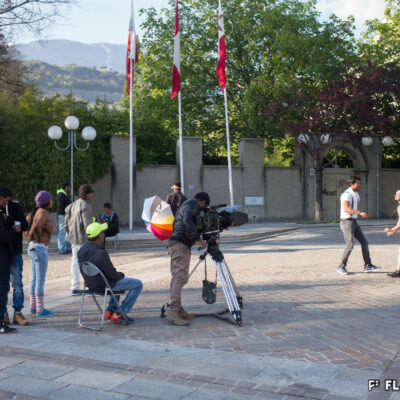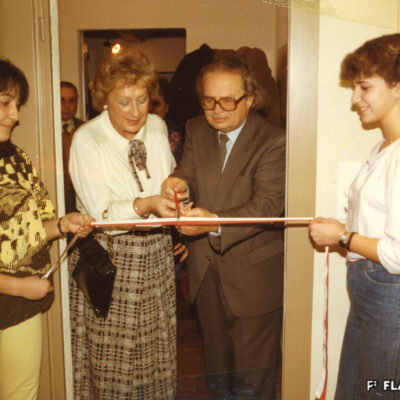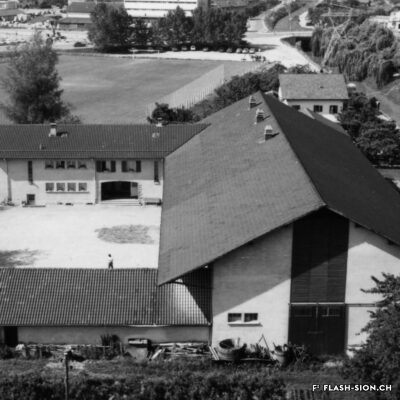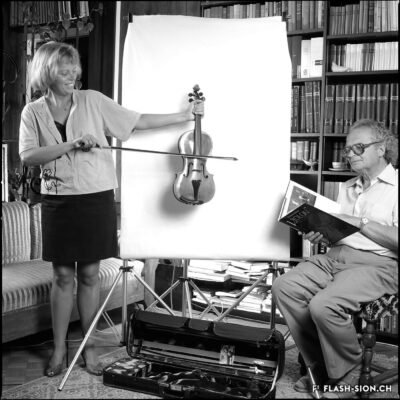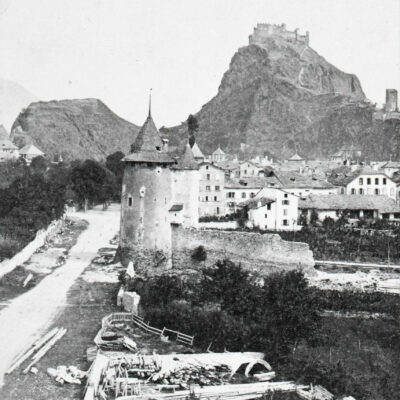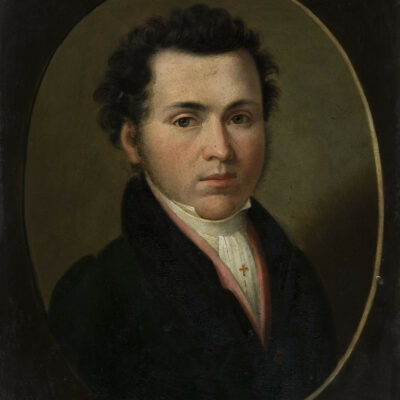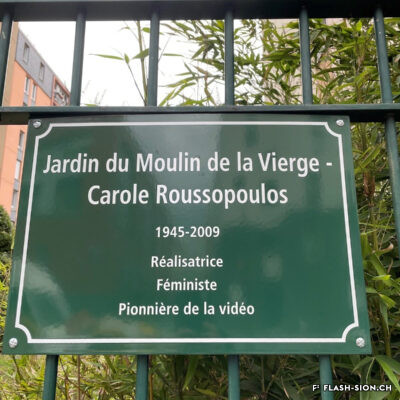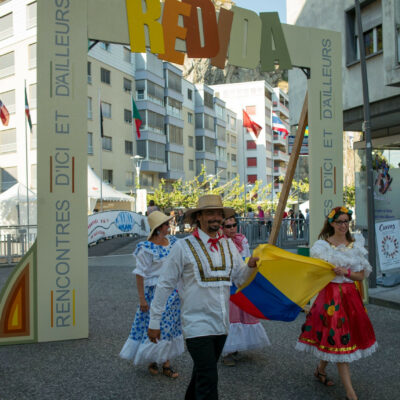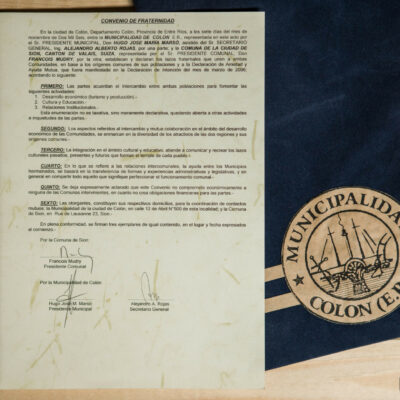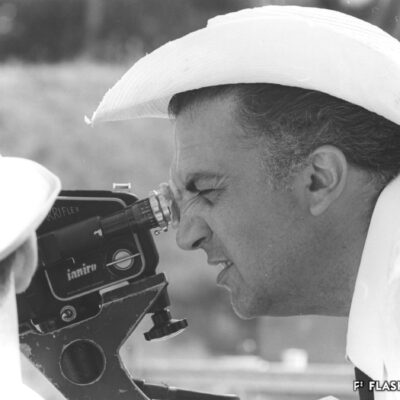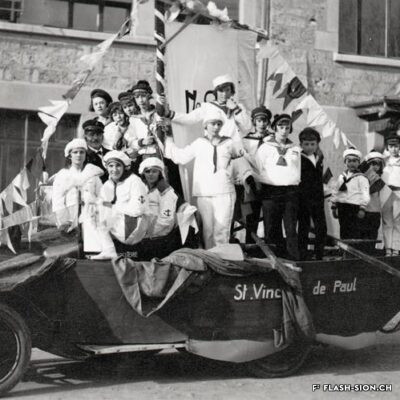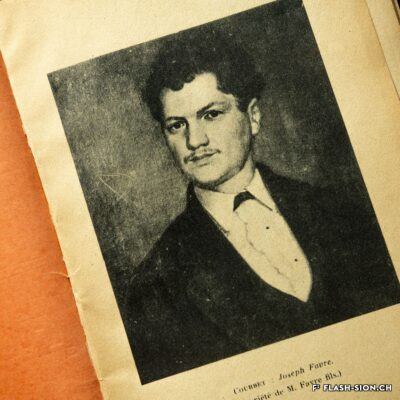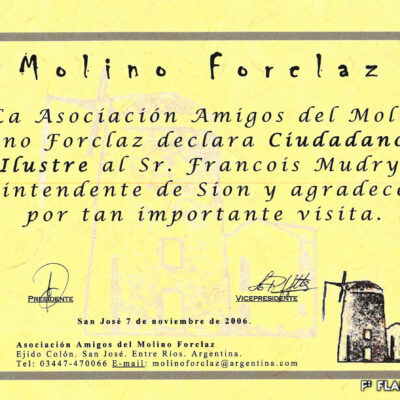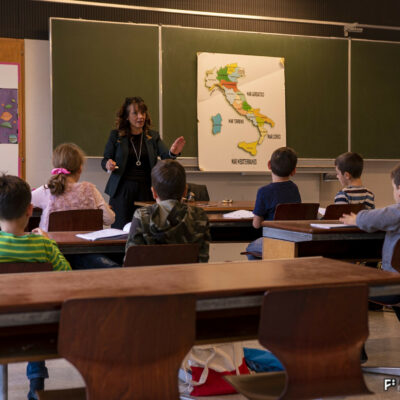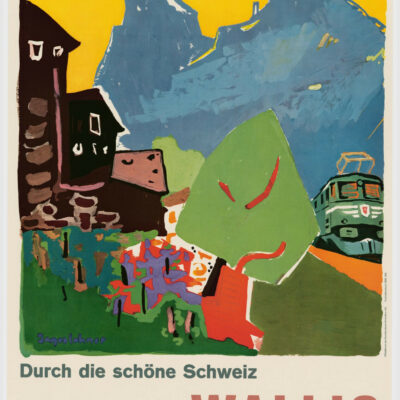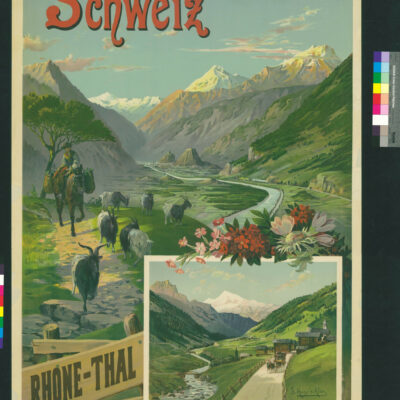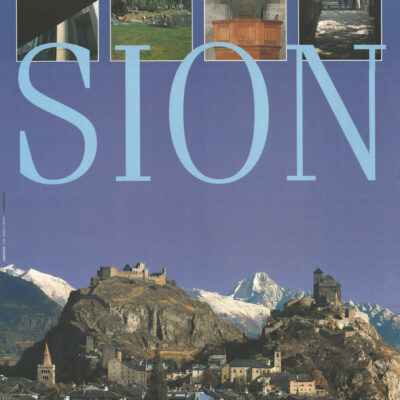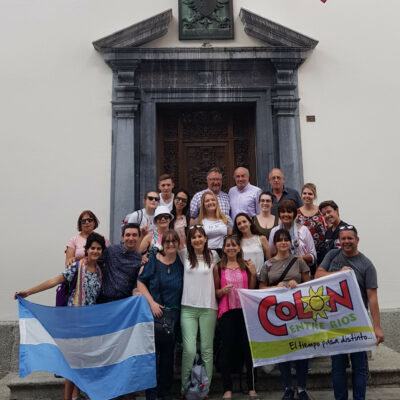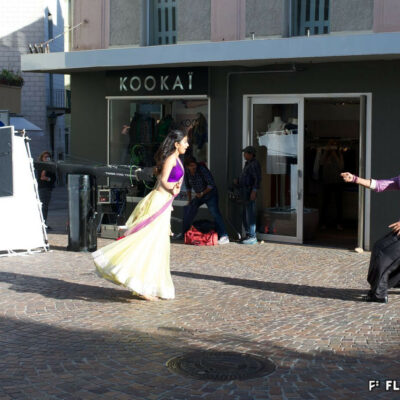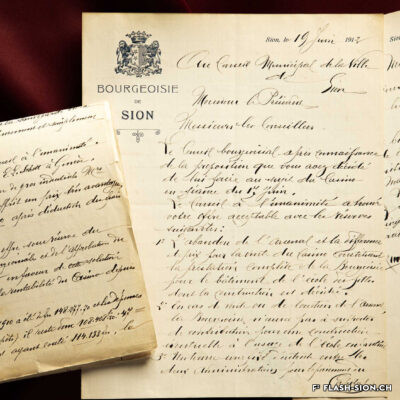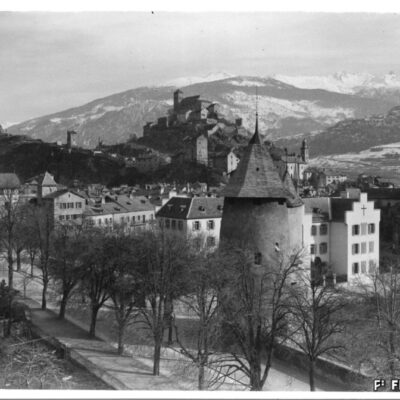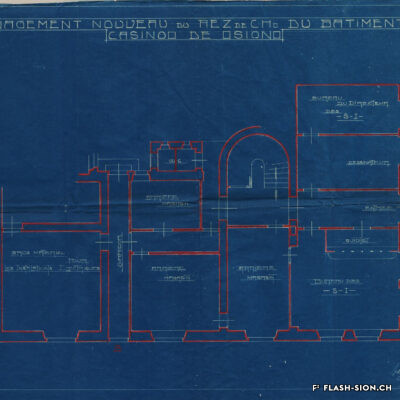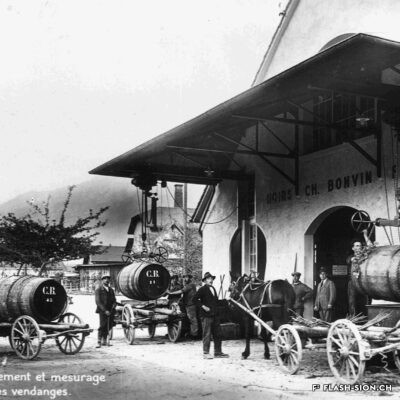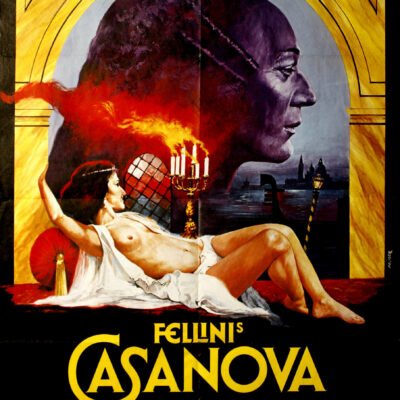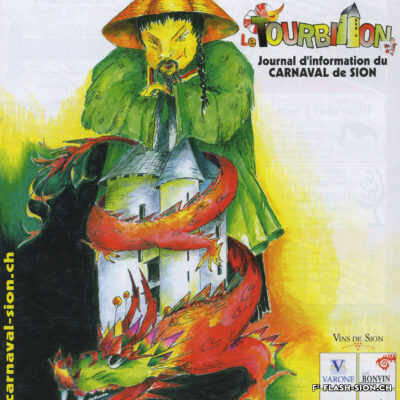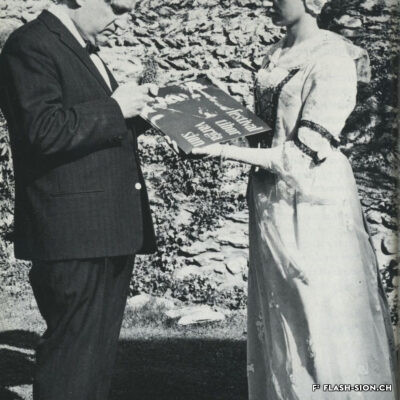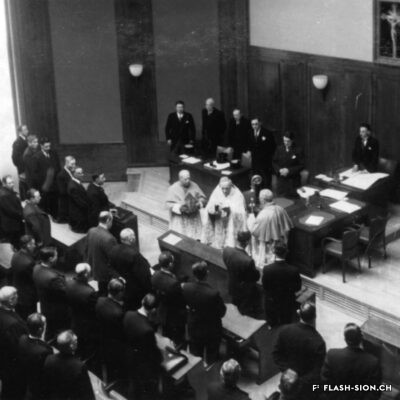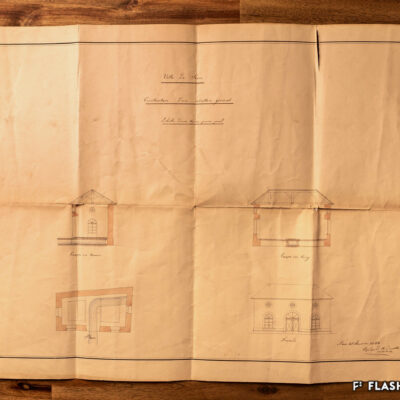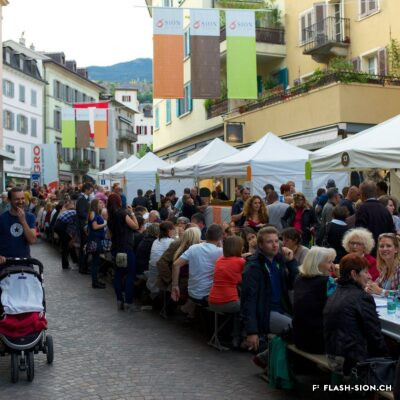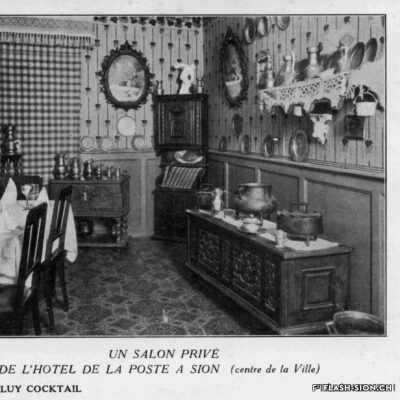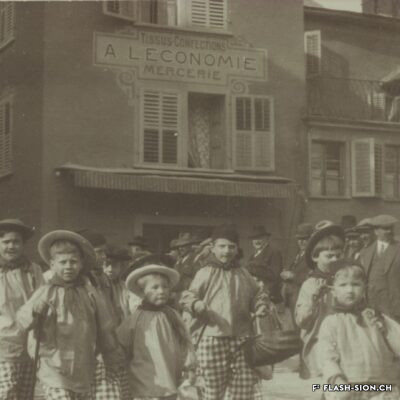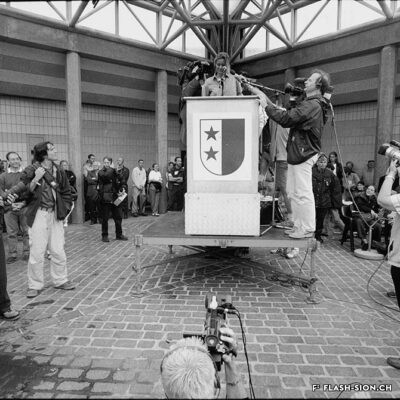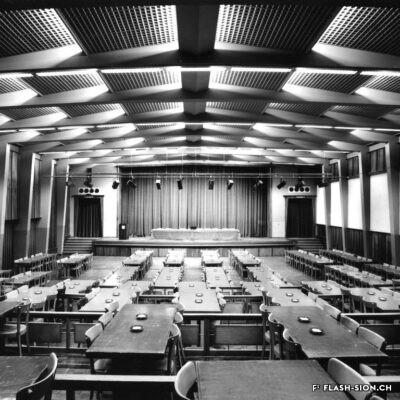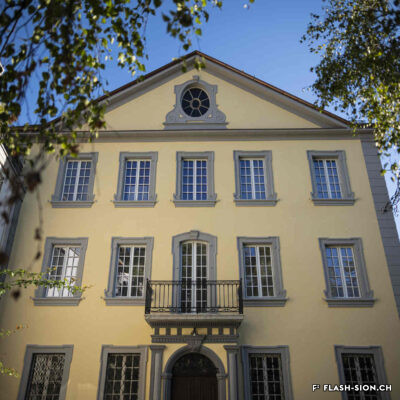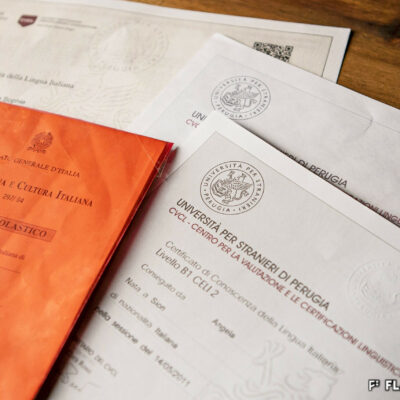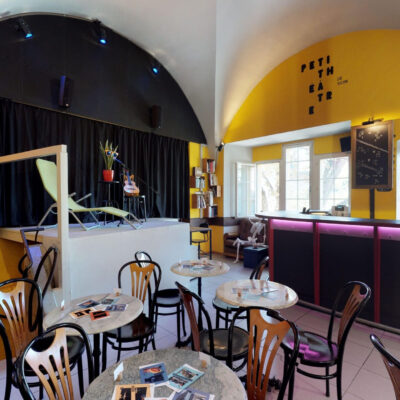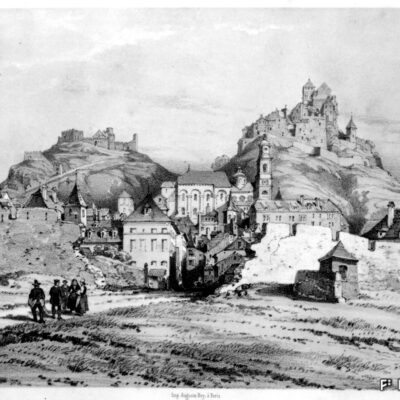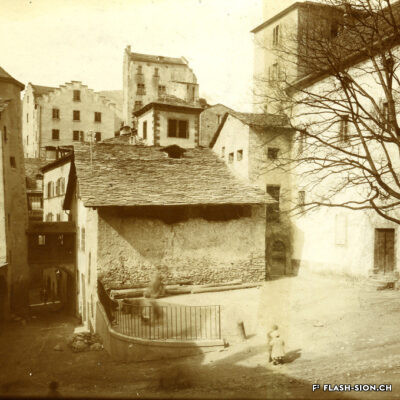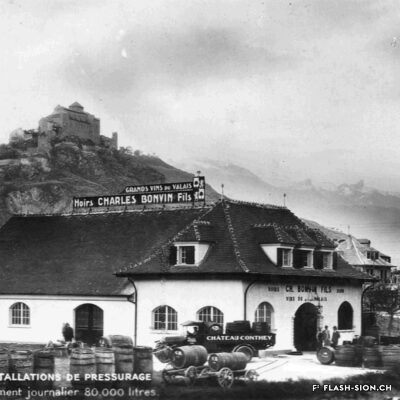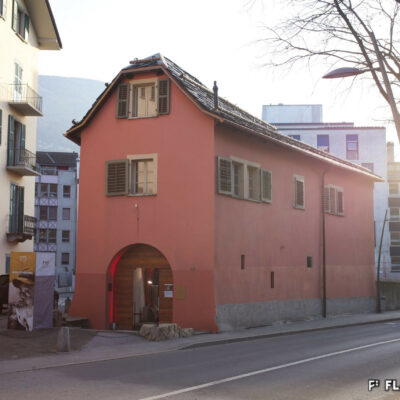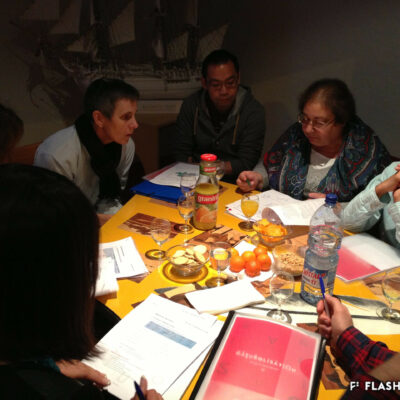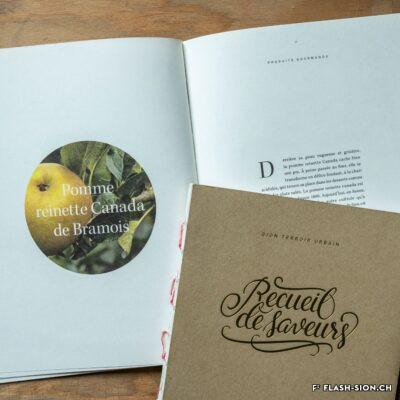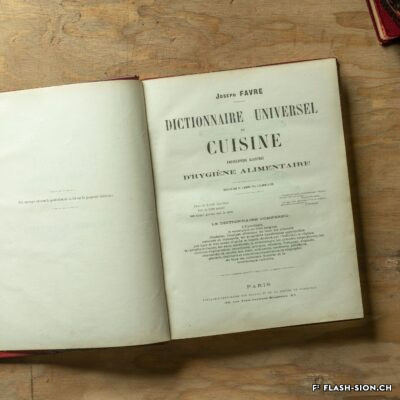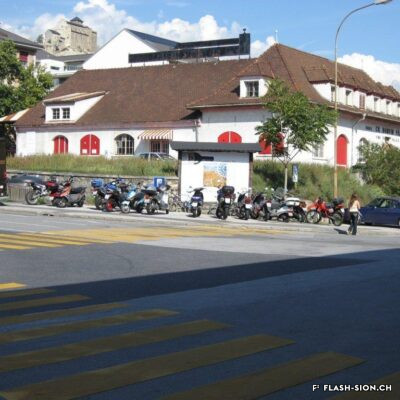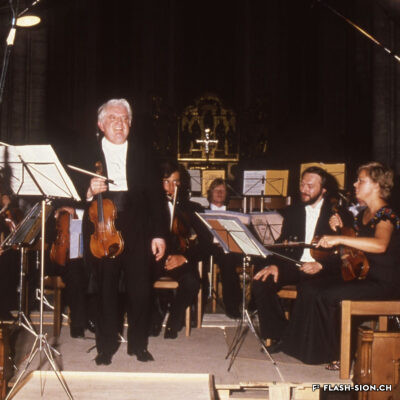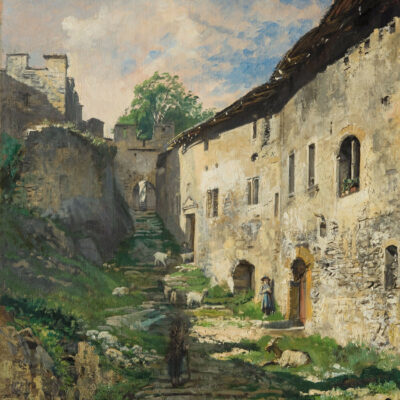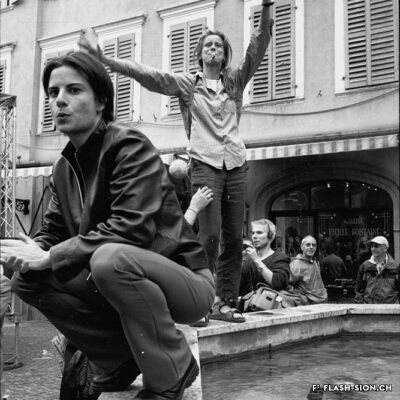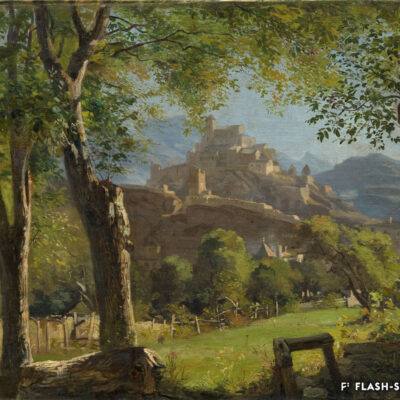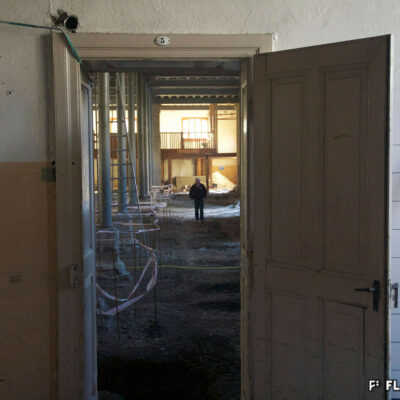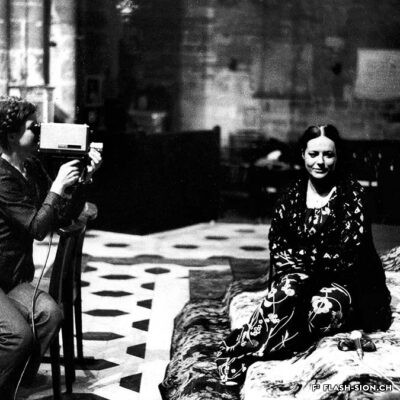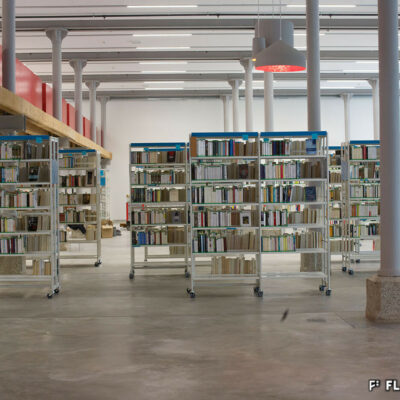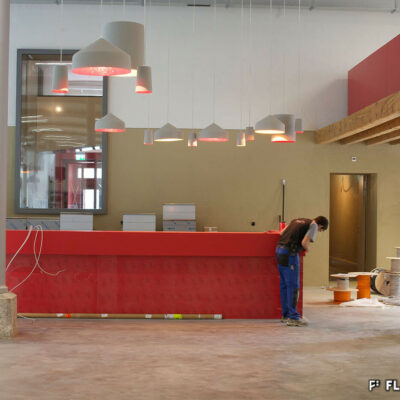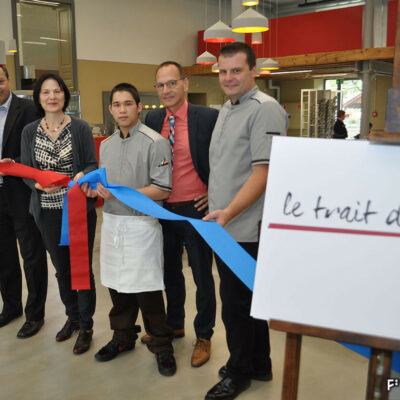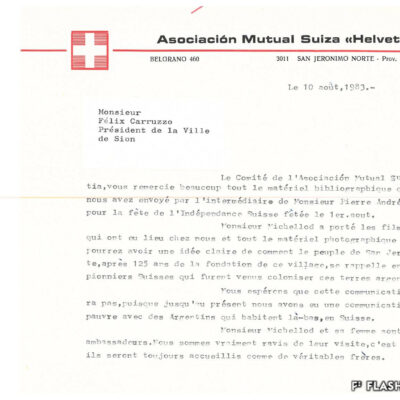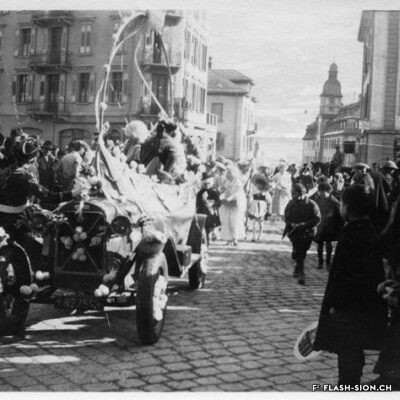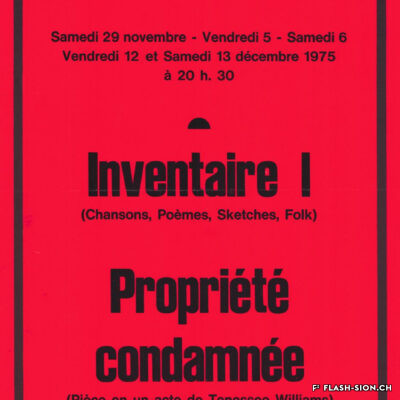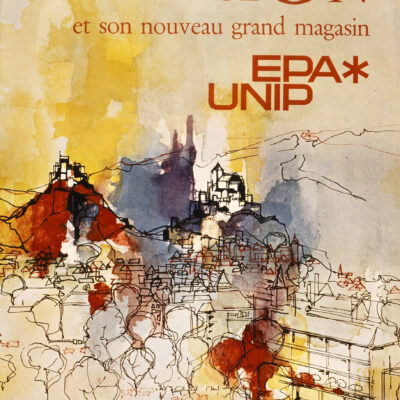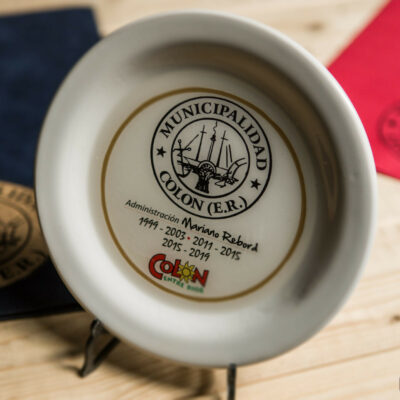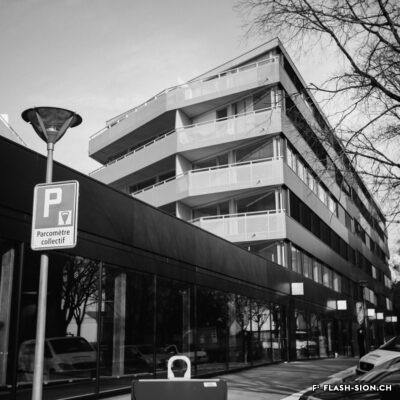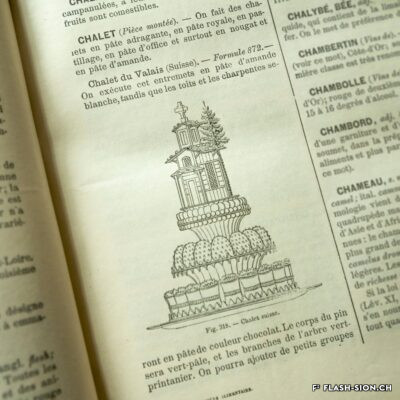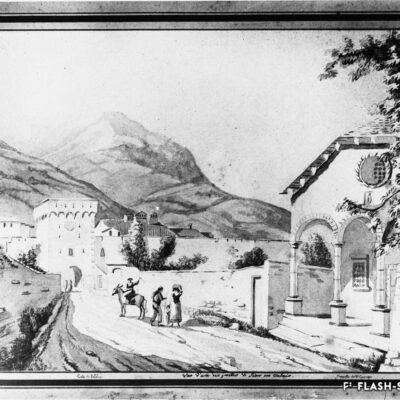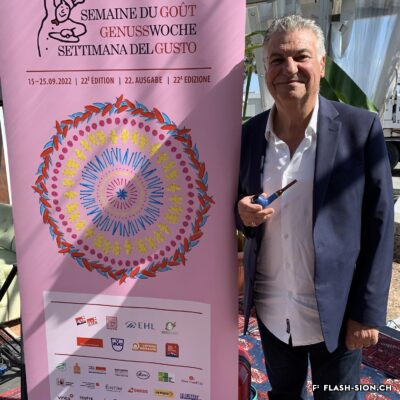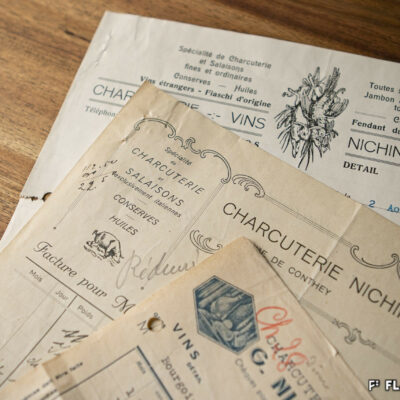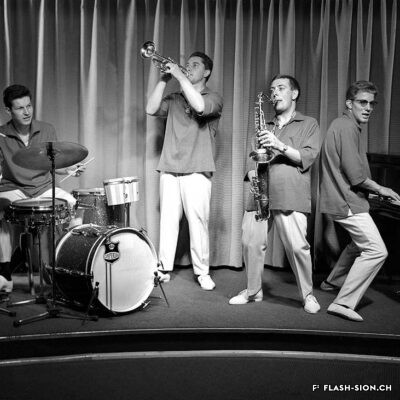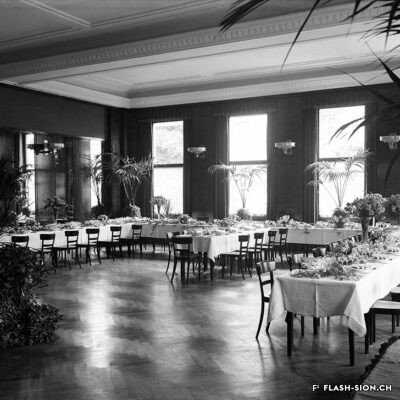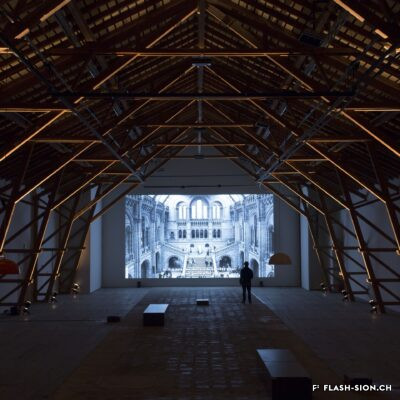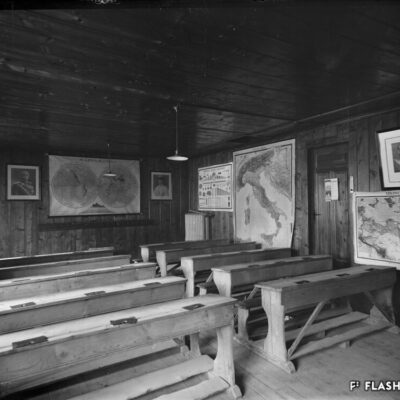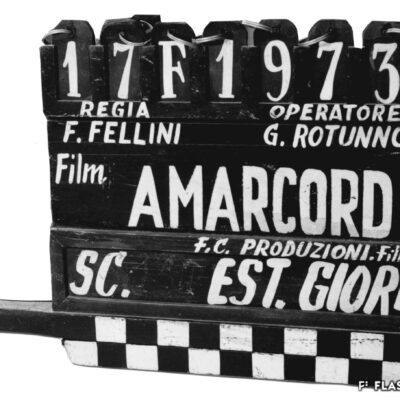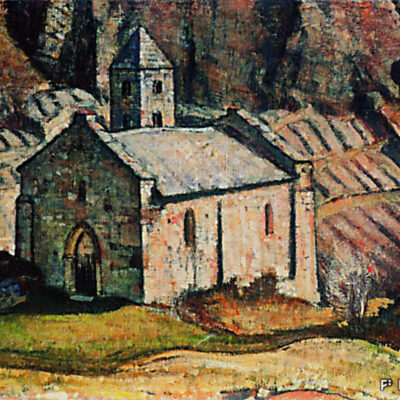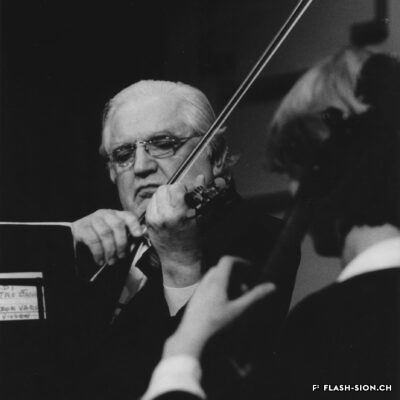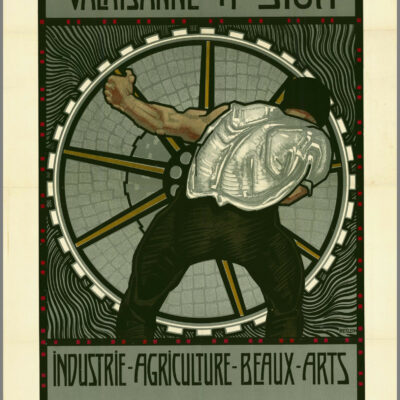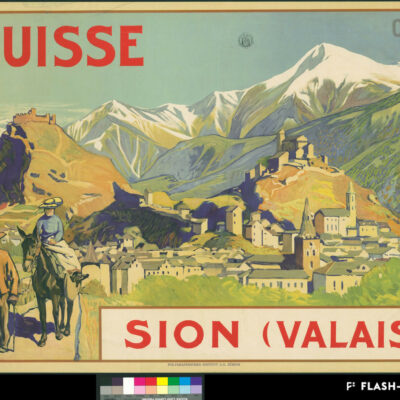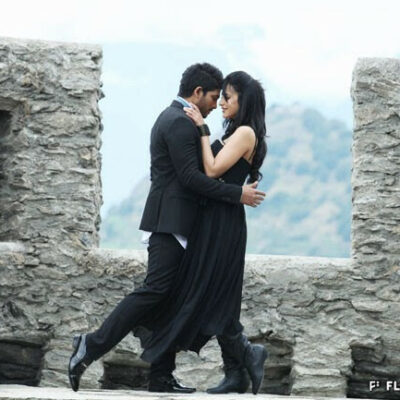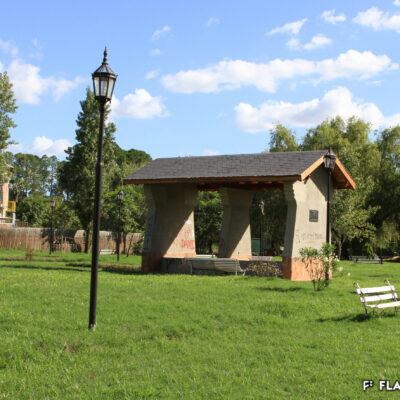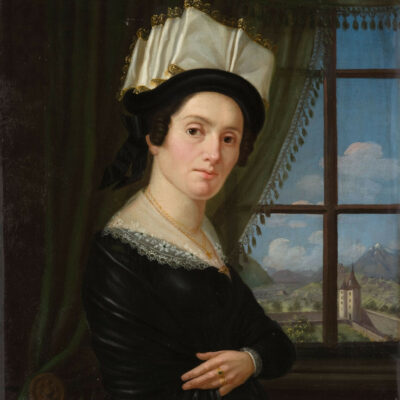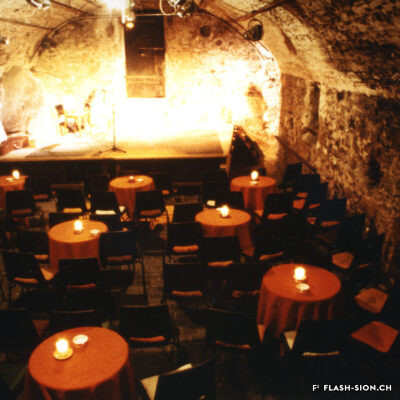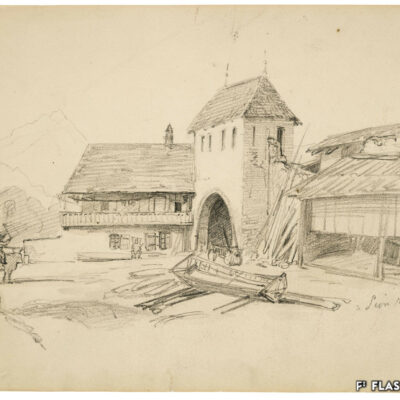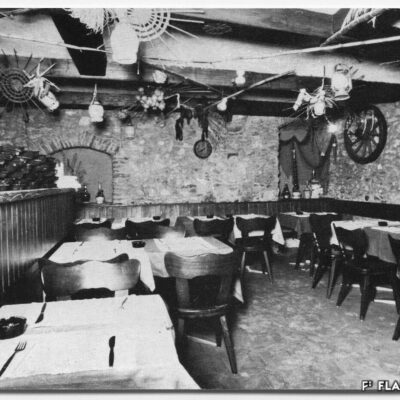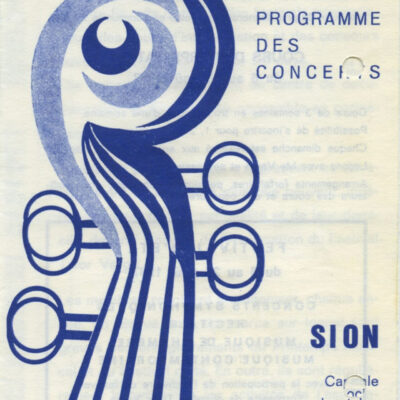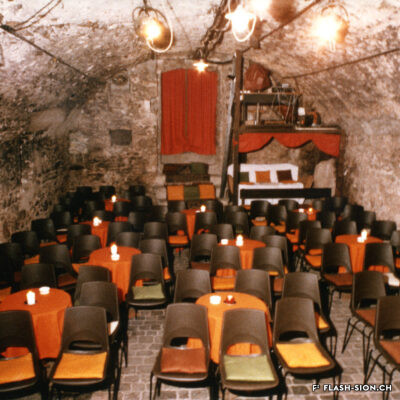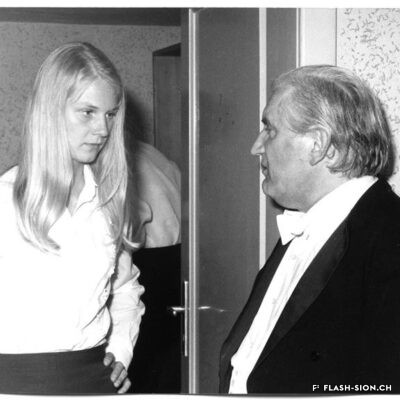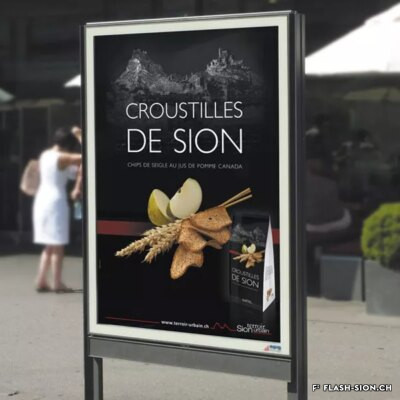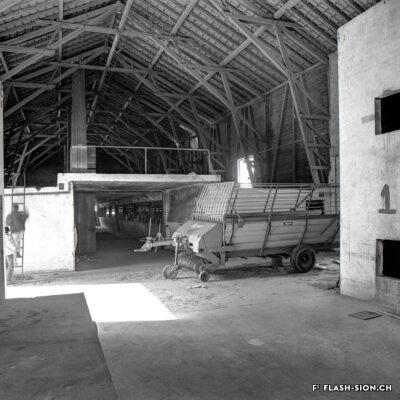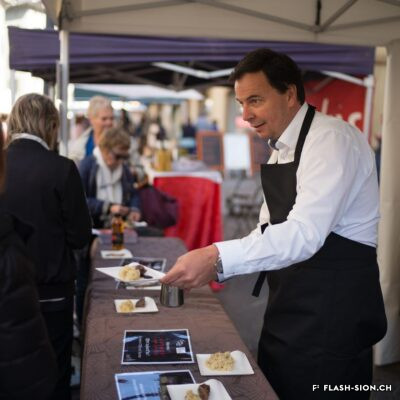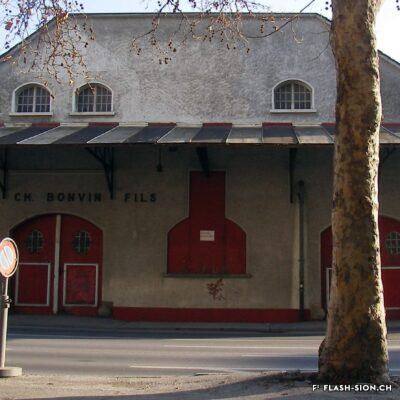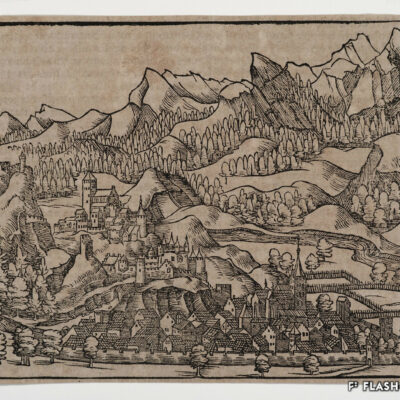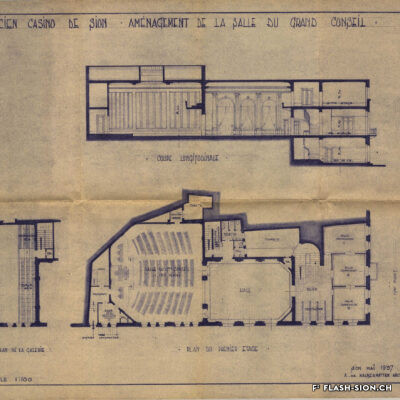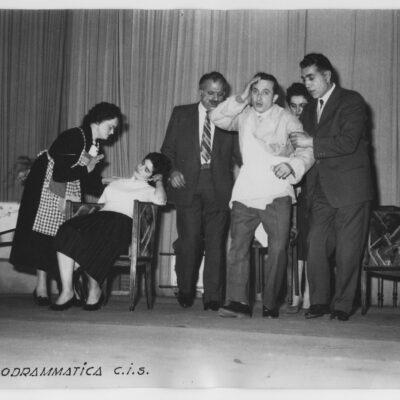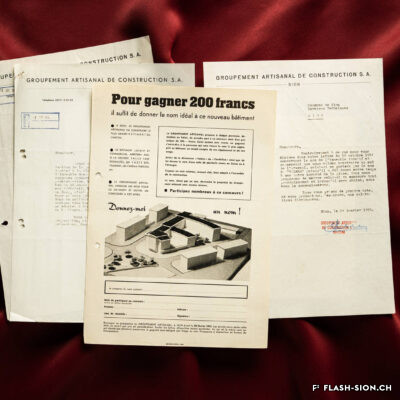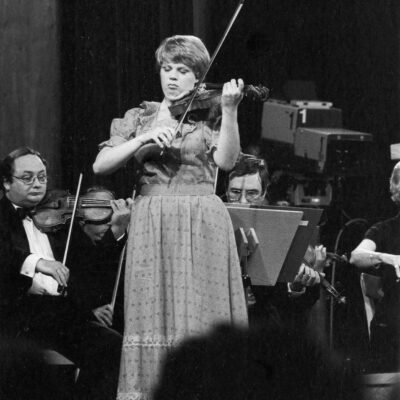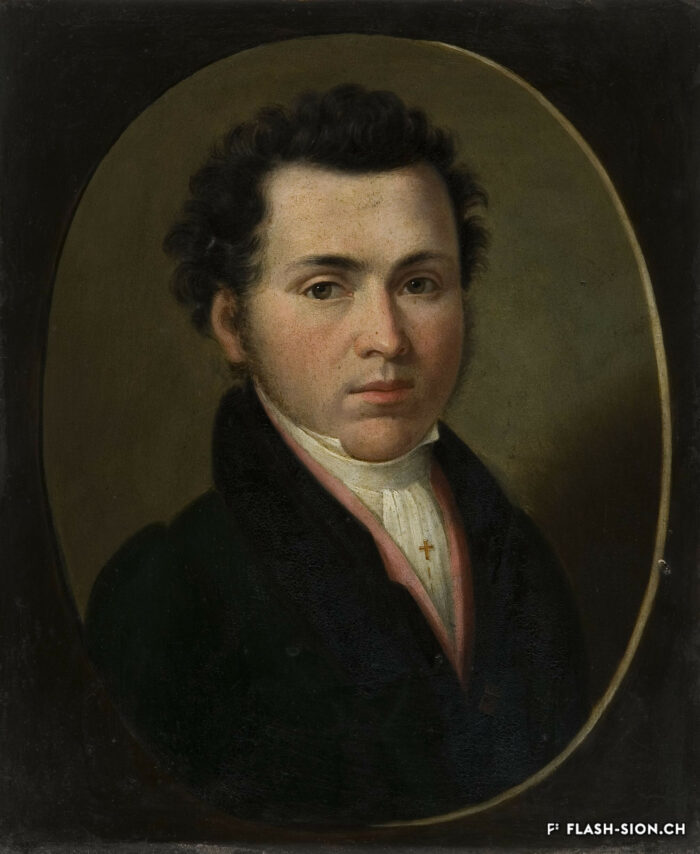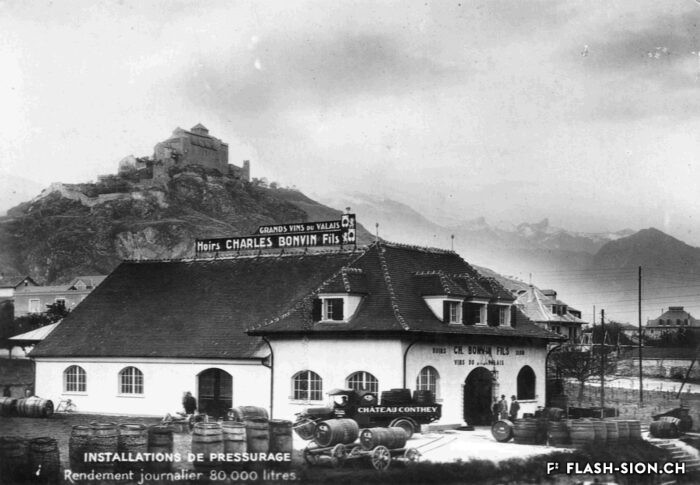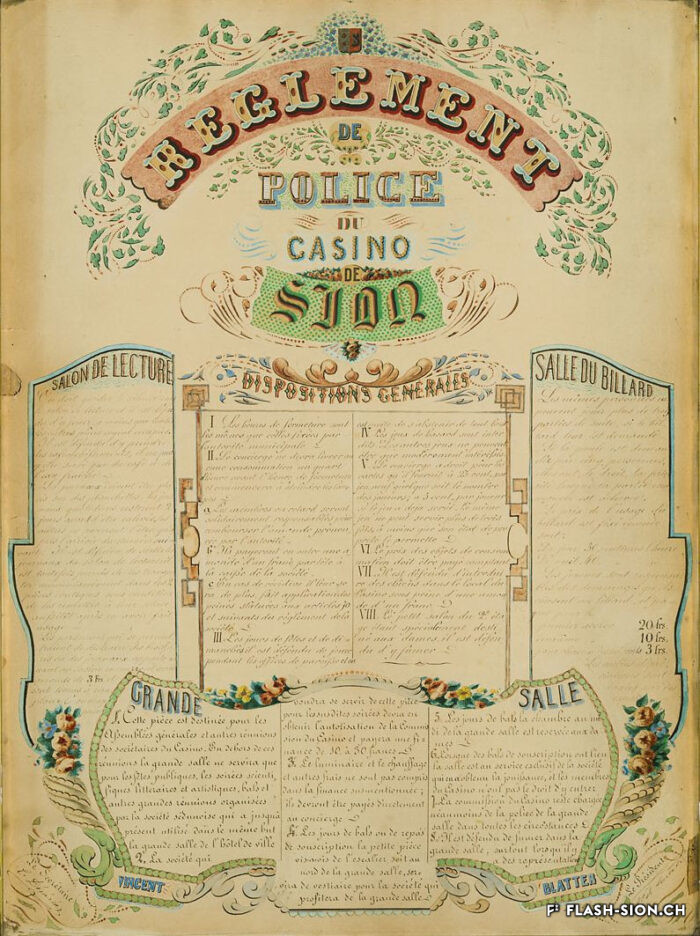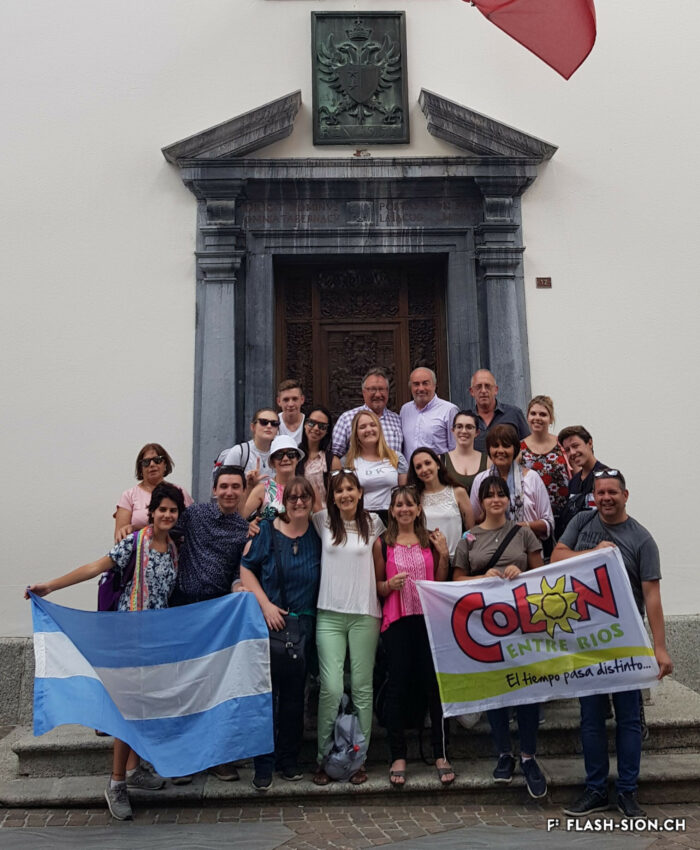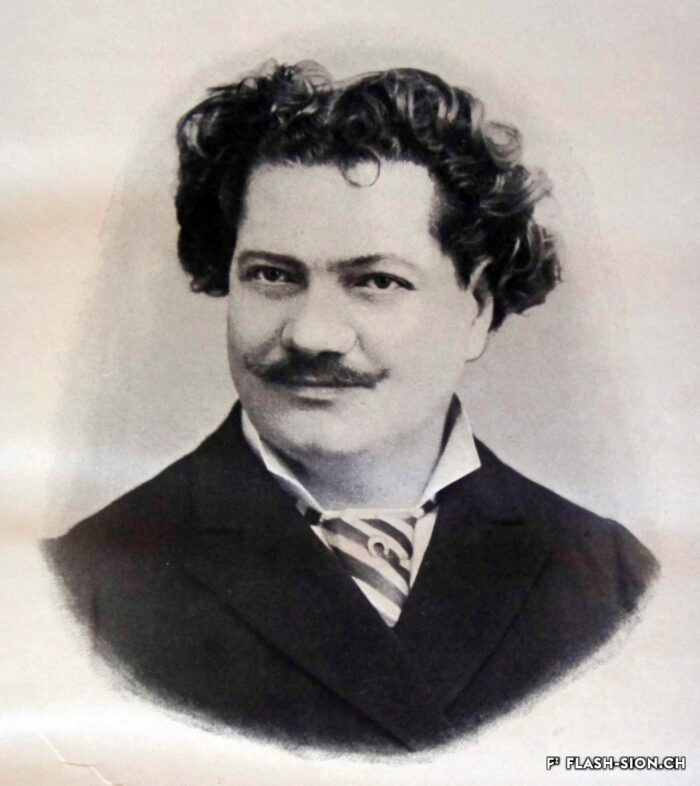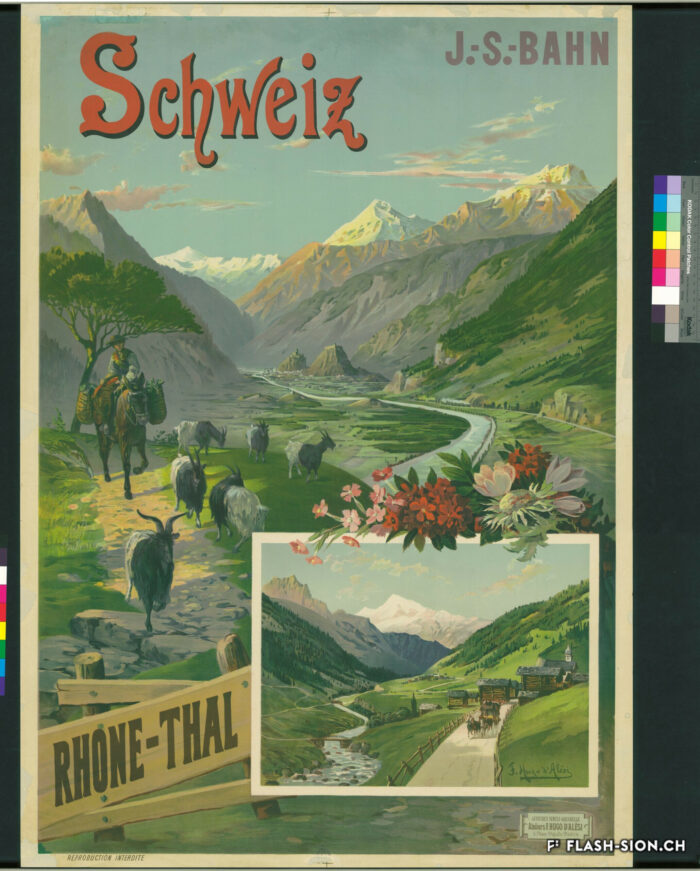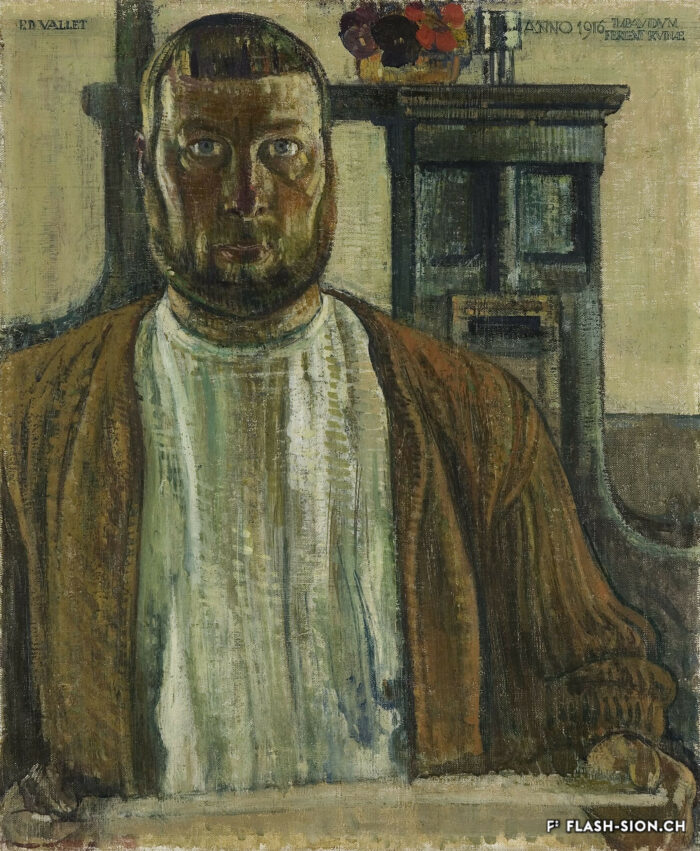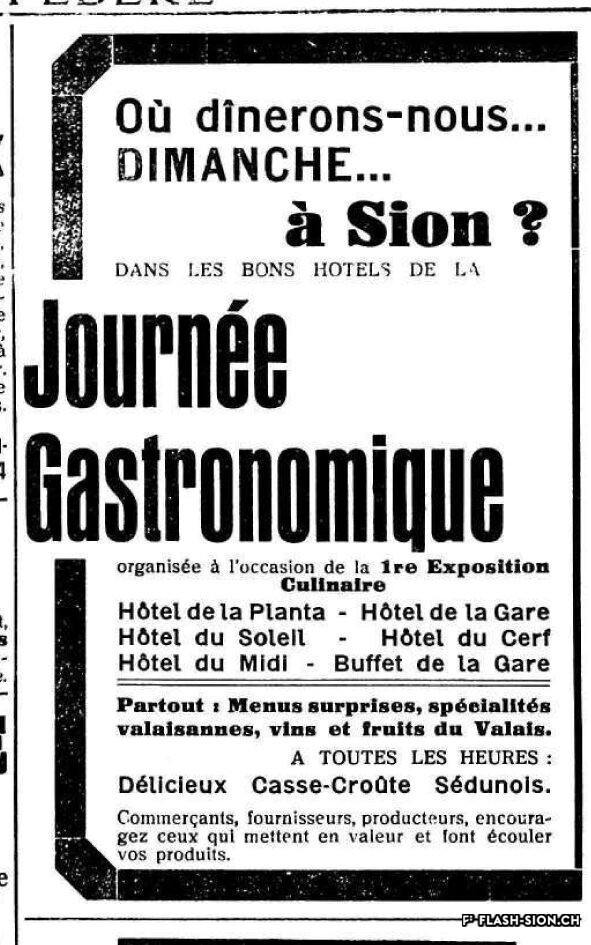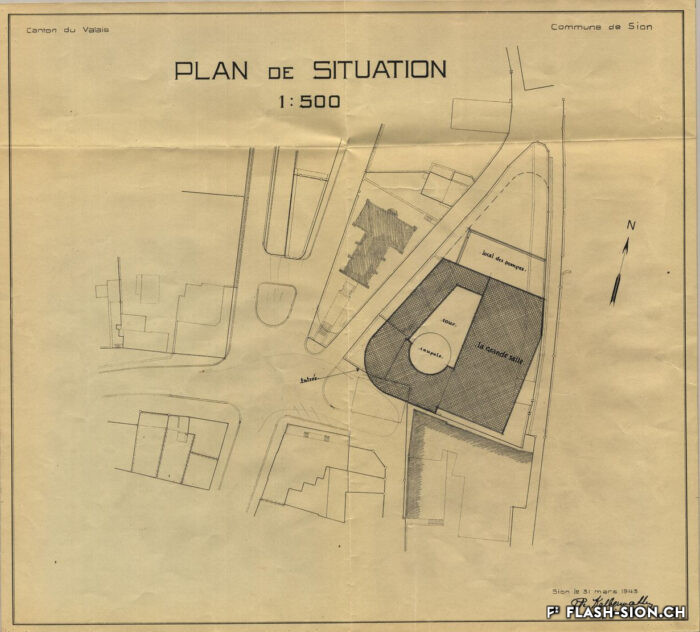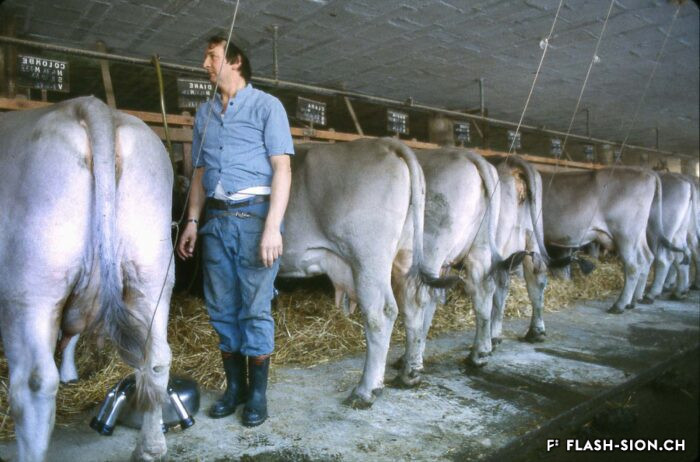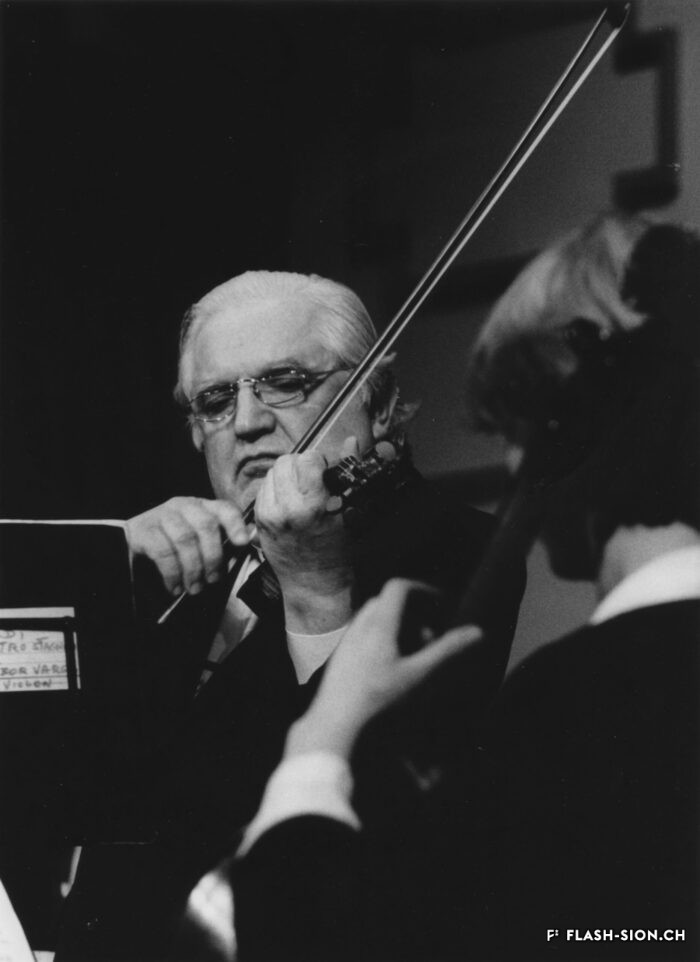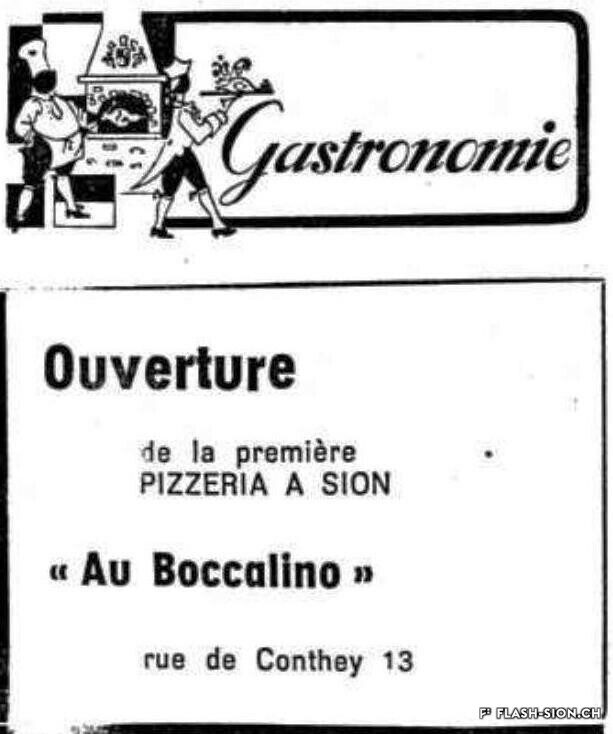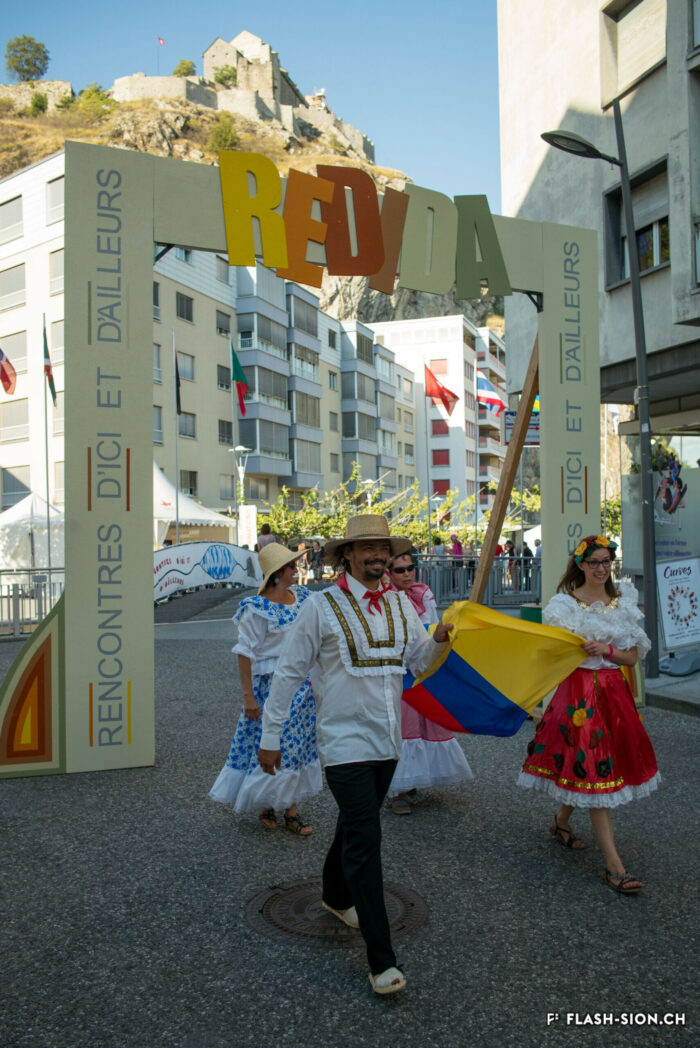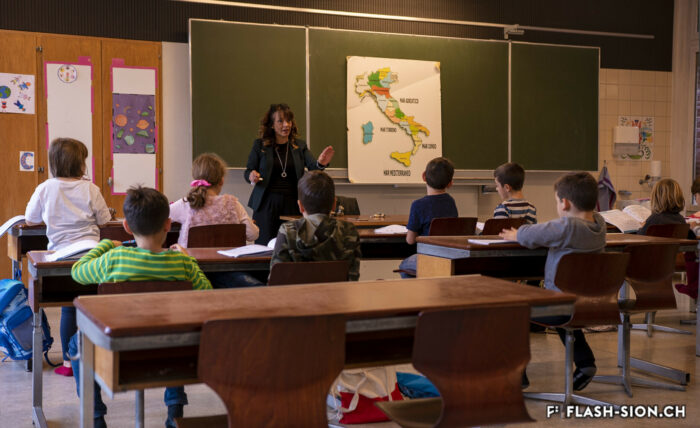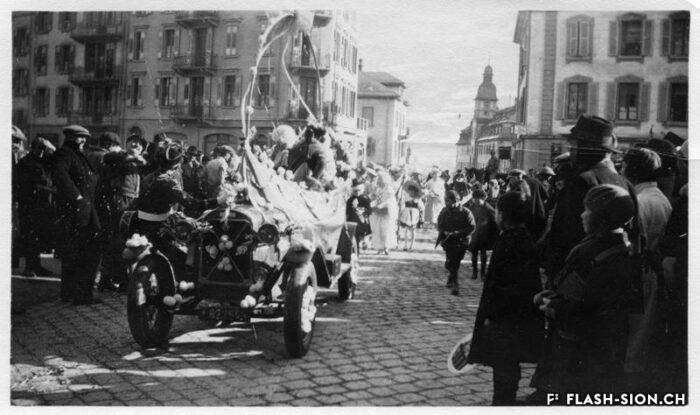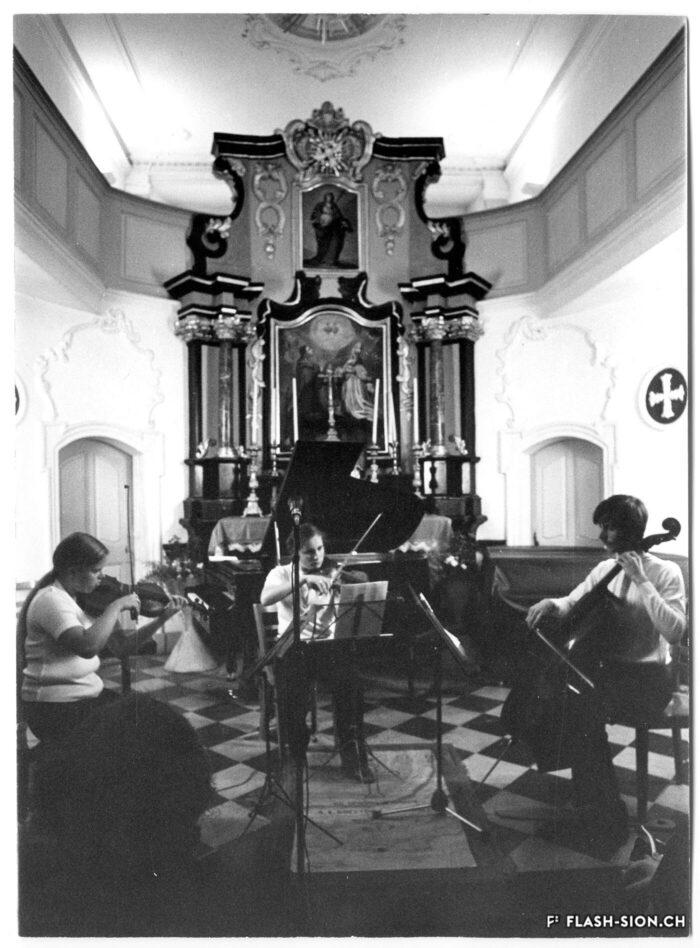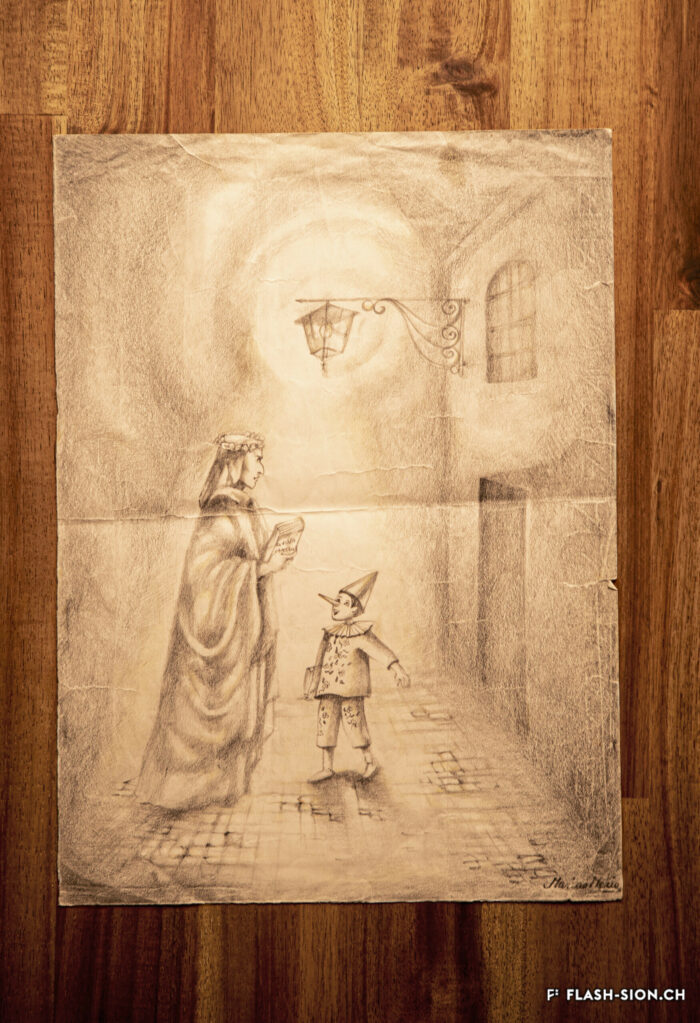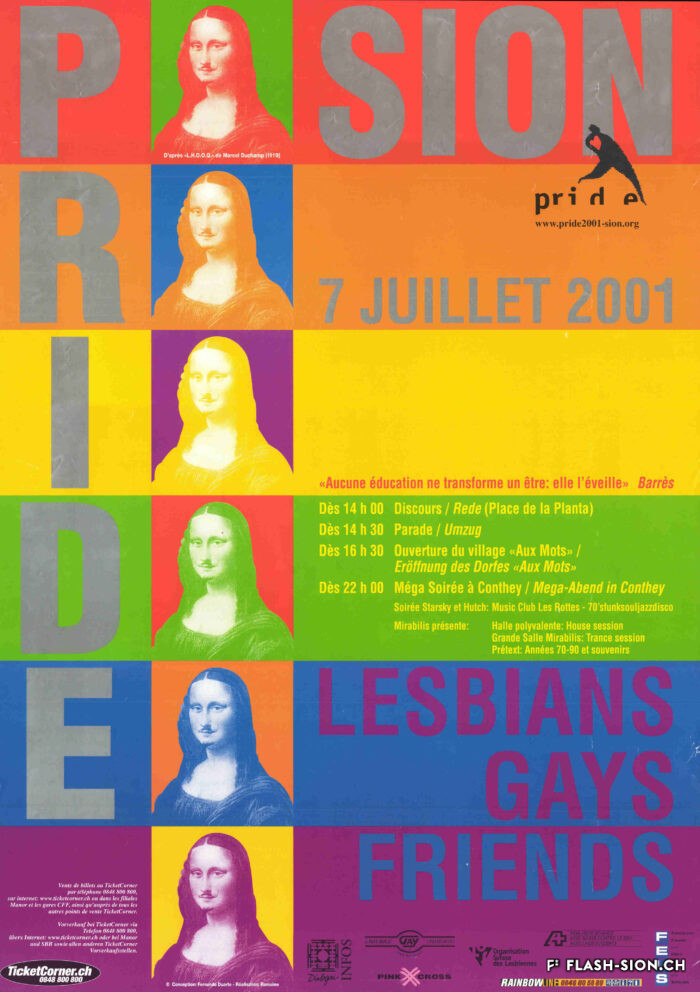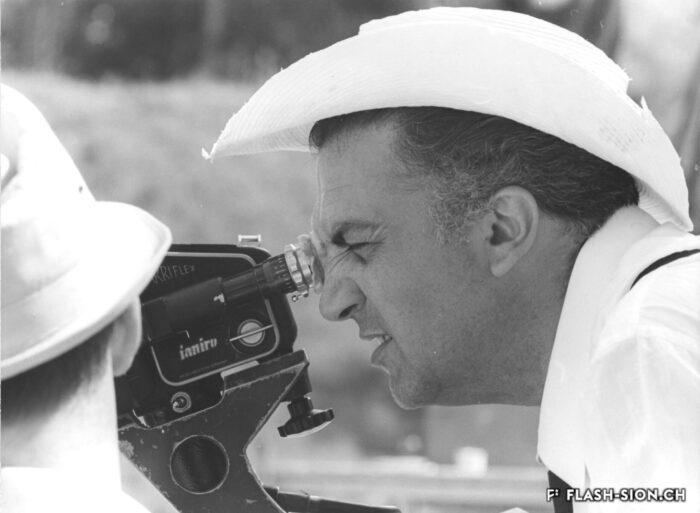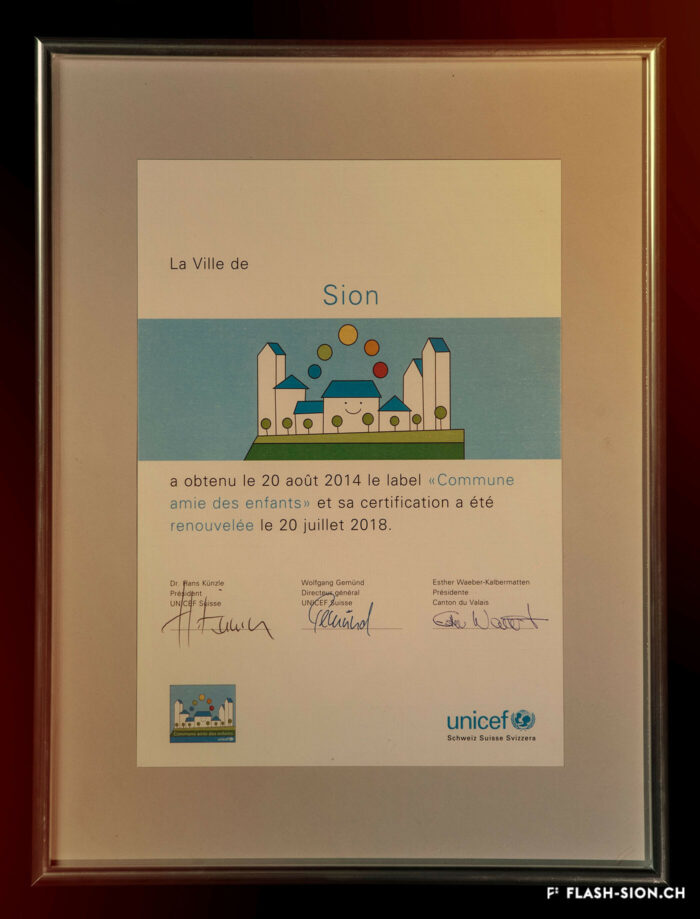Aux portes de Sion
Dès le Haut Moyen Age, la présence d’enceintes fortifiées est attestée pour la cité sédunoise. Elles retracent le développement de la ville jusqu’au tournant du 15e siècle. La dernière et plus grande enceinte, démantelée dans la première moitié du 19e siècle, comportait 7 portes. Ces passages obligés et bien gardés symbolisent autant l’échappée et l’ouverture sur le monde que la fermeture et le repli en cas de guerre avec la canalisation et le contrôle des gens et des marchandises et la perception de taxes et de péages. Les vestiges de la porte de Covent, située entre les collines de Valère et Tourbillon, constituent un dernier témoin d’un accès à la cité médiévale.
Vor den Toren von Sitten
Vom Frühmittelalter bis ins 15. Jahrhundert lässt sich die Entwicklung der Stadt Sitten anhand des Verlaufs der Befestigungsmauern ablesen. Die letzte und grösste Ringmauer, deren Schleifung in der ersten Hälfte des 19. Jahrhunderts stattfindet, zählte 7 befestigte Tore. Diese streng bewachten Zugänge versinnbildlichen sowohl die Öffnung zur Aussenwelt als auch den Rückzug und die Abriegelung im Kriegsfalle mit Regulierung und Kontrolle der Stadtbesucher und des Warenaustausches sowie der Erhebung von Zöllen und Abgaben. Die Reste des Covent-Tors zwischen den Burghügeln von Valeria und Tourbillon sind ein letzter Zeuge eines Zugangs zur mittelalterlichen Stadt.
At the gates of Sion
Records of the presence of fortification walls have been documented in the City of Sion since the Early Middle Ages. These walls reflected the city’s development till the turn of the 15th century. The last and largest fortification wall, dismantled during the first half of the 19th century, included 7 fortified gateways. These obligatory and well-guarded passages were symbols of both escape and openness to the world as well as closure and withdrawal in the event of war. The flow of people and goods was channelled and controlled through them, while taxes and tolls were collected. The remains of the Covent Gate, situated between the hills of Valère and Tourbillon, are the last witness of an access to the medieval city.
Alle porte di Sion
A partire dall’alto Medioevo è attestata la presenza di una cinta fortificata attorno alla città di Sion. Queste mura tracciano lo sviluppo della città fino alla fine del 15esimo secolo. La più grande e ultima cinta muraria smantellata nella prima metà del 19esimo secolo aveva 7 porte. Questi passaggi obbligati e ben sorvegliati simbolizzano sia la fuga e l’apertura al mondo che la chiusura e il ritiro in caso di guerra, permettendo di convogliare e controllare le persone e le merci, e di riscuotere tasse e pedaggi. Le vestigia della Porte de Covent, situata fra le colline di Valère et Tourbillon, costituiscono un’ultima testimonianza di un accesso alla città medievale.
Les Ritz, peintres de père en fils
Lorenz Justin Ritz (1796-1870), originaire de Niederwald dans la vallée de Conches, s’installe à Sion en 1839. Peintre religieux et portraitiste incontournable de l’époque, il est l’auteur d’environ 650 portraits. En 1842, il épouse en secondes noces une Sédunoise, Marguerite de Torrenté. Conseiller municipal de Sion de 1848 à 1860, il s’implique au sein de la commune nouvellement créée. Lorenz Justin Ritz est également le père de Raphaël Ritz (1829-1894), peintre de renom. Suivant l’enseignement paternel, Raphaël va devenir l’un des artistes valaisans les plus importants du 19e siècle. L’ancienne avenue du Nord porte aujourd’hui leur nom et leur rend hommage.
Vater und Sohn die Maler Lorenz Justin und Raphael Ritz
Der aus Niederwald im Goms stammende Lorenz Justin Ritz (1796-1870) lässt sich 1839 in Sitten nieder. Als wichtiger Porträt- und Kirchenmaler seiner Zeit hat er an die 650 Porträts geschaffen. 1842 heiratet er in zweiter Ehe Marguerite de Torrenté aus Sitten. Zwischen 1848 und 1860 engagiert er sich als Gemeinderat für die neugegründete politische Gemeinde. Eines seiner Kinder ist der ebenfalls renommierte Genremaler Raphael Ritz (1829-1894). Der väterlichen Lehre folgend wird dieser zu einem der bedeutendsten Walliser Maler des 19. Jahrhunderts. Die frühere Avenue du Nord trägt heute den Namen der Maler und würdigt Vater und Sohn gleichermassen.
The Ritz, family of painters from father to son
Lorenz Justin Ritz (1796-1870), a native of Niederwald in the Goms Valley, settled In Sion in 1839. A major religious and portrait painter of his time, he was an author of about 650 portraits. In 1842, he married his second wife, Marguerite de Torrenté of Sion. He was a municipal councillor of Sion between 1848 and 1860 and played an active role in the newly created municipality. Lorenz Justin Ritz was also the father of Raphaël Ritz (1829-1894), a renowned painter. Following his father’s education, Raphaël became one of the most important artists of the 19th century of Valais. The former North Avenue was renamed after the artists as a tribute to both of them.
I Ritz, pittori di padre in figlio
Lorenz Justin Ritz (1796-1870), originario di Niederwald nella valle di Conches s’installò a Sion nel 1839. Pittore religioso e ritrattista dell’epoca è stato l’autore di circa 650 ritratti. Nel 1842 sposò in seconde nozze Marguerite de Torrenté, originaria di Sion. Venne eletto consigliere municipale di Sion dal 1848 al 1860 e s’impegna politicamente nel comune creato da poco. Lorenz Justin Ritz è stato anche padre di Raphaël Ritz (1829-1894), rinomato pittore. Seguendo l’insegnamento del padre, Raphaël diventerà uno degli artisti vallesani più importanti del 19esimo secolo. Oggi la vecchia strada a Nord porta il loro nome rendendogli omaggio.
Charles et les caves festives
Fondée en 1858, la maison sédunoise des Hoirs Charles Bonvin Fils fait figure de pionnière en matière de commerce vinicole en Valais. Charles-Marie Bonvin, son fondateur, donne l’impulsion au domaine et fait connaître les vins valaisans hors du canton et de la Suisse. Son fils Charles (1858-1922) prend la relève et à sa suite, ses deux fils, Charles (1888-1937) puis Félix. Aux caves et bureaux de la rue des Vergers et de la rue des Remparts s’ajoutent en 1932, les pressoirs de l’avenue de Tourbillon, face à la gare. Ces derniers deviennent alors un centre moderne de pressurage et d’encavage, jusqu’au début des années 1990. Désaffectés pendant de nombreuses années, ces pressoirs à l’abandon attirent l’attention d’un collectif qui y voit un potentiel culturel et souhaite leur redonner vie de façon éphémère. En 2008 et durant une année, l’association « Les Caves à Charles » fait vibrer ce lieu industriel chargé d’histoire, pour lui rendre un dernier hommage avant sa démolition.
Charles und die festliche Kellerei
Die 1858 in Sitten gegründete Weinkellerei der Erben von Charles Bonvin und Söhne gilt als Pionierin des Weinhandels im Wallis. Charles-Marie Bonvin, Begründer des Hauses, verstand es, den Walliser Wein ausserhalb des Kantons und der Schweiz bekannt zu machen. Der Betrieb wird in der Folge von seinem Sohn Charles (1858-1922) übernommen bevor dessen Söhne Charles (1888-1937) und später Félix die Nachfolge antreten. Zum Weinkeller und den Büroräumlichkeiten in der Rue des Vergers und der Rue des Remparts gesellt sich 1932 das Gebäude mit Weinpresse an der Avenue de Tourbillon, direkt gegenüber dem Bahnhof. Dieses entwickelt sich bis anfangs der 1990er Jahre zu einer modernen Kelterei mit Weinkeller. Danach bleibt das Gebäude während einiger Jahre ungenutzt. 2008 interessiert sich ein Kollektiv für die Kelterei und sieht deren Potenzial für eine kurzfristige kulturelle Nutzung. Während einem Jahr bringt der Verein «Les Caves à Charles» den geschichtsträchtigen Ort nochmals zum Schwingen und erweist ihm, bevor er abgebrochen wird, die letzte Ehre.
Charles and the festive wine cellars
Founded in 1858, the Sion-based company of Hoirs Charles Bonvin Fils is a pioneer in the wine trade in Valais. Charles-Marie Bonvin, its founder, provided the impetus to the estate and made Valais wines known outside the canton and Switzerland. His son Charles (1858-1922) took over and was followed by his two sons, Charles (1888-1937) and Félix. In 1932, the cellars and offices in the ‘Rue des Vergers’ and the ‘Rue des Remparts’ were completed by the addition of wine presses in the ‘Avenue de Tourbillon’, opposite the railway station. They became a modern pressing and cellaring centre until the early 1990s. Disused for many years, these abandoned wine presses attracted the attention of a group who saw a cultural potential in them and wanted to bring them back to life in a temporary way. In 2008 and for one year, the Charles Cellars Association (Les Caves à Charles) filled this industrial site, full of history, with life and paid it a last tribute before its demolition.
Charles e le cantine in festa
Fondata nel 1858, l’azienda sedunese Hoirs Charles Bonvin Fils, è una pioniera del commercio di vino nel Vallese. Charles-Marie Bonvin, il suo fondatore, diede impulso alla tenuta e fece conoscere i vini del Vallese al di fuori del cantone e della Svizzera. Il figlio Charles (1858-1922) prese il testimone e fu seguito dai suoi due figli, Charles (1888-1937) e Félix. Nel 1932, alle cantine e agli uffici nella Rue des Vergers e nella Rue des Remparts si aggiunsero i torchi di Avenue de Tourbillon, di fronte alla stazione. In seguito, fino all’inizio degli anni Novanta, si sono trasformati in un moderno centro di pressatura e cantina. In disuso da molti anni, questi torchi abbandonati hanno attirato l’attenzione di un gruppo che ha visto in essi un potenziale culturale e ha voluto riportarli in vita in modo temporaneo. Nel 2008 e per un anno, l’associazione “Les Caves à Charles” (Le cantine di Charles) ha riportato in vita questo luogo industriale ricco di storia, per rendergli un ultimo omaggio prima della sua demolizione.
Des jeux de société aux jeux politiques
Contrairement à ce que son nom pourrait suggérer, le Casino de Sion n’a jamais hébergé de jeux de hasard sous son toit. Destiné à resserrer les liens de la société sédunoise, l’établissement, représentatif de l’architecte Emile Vuilloud, est construit en 1861 sur décision de la Bourgeoisie de Sion. L’édifice, avec sa grande salle de fête et les différents salons de lecture et de jeux de société, est inauguré en 1865. Parallèlement, la Société du Casino est constituée et un règlement de police strict est adopté. Après presque 40 ans d’existence, la société rencontre de plus en plus de difficultés à rassembler des membres. Elle est dissoute en 1904 et le bâtiment est racheté en 1912 par la Municipalité. En 1924, pour éviter de devoir mettre à disposition, à ses frais, des locaux plus spacieux pour les séances du Parlement valaisan, le conseil communal autorise le Grand Conseil à siéger, à bien plaire, dans la salle du Casino. Rénové et agrandi de 1938 à 1939, le Casino devient le siège permanent du Grand Conseil, excluant définitivement son utilisation parallèle comme salle de fête.
Von Gesellschaftsspielen zu politischen Spielchen
Entgegen seinem Namen sind im Casino von Sitten nie Glücksspiele angeboten worden. Der repräsentative Bau des Architekten Emile Vuilloud ist vielmehr dazu bestimmt, den gesellschaftlichen Zusammenhalt unter den Sittener Bürgern zu festigen und zu pflegen. 1861 beschliesst die Burgergemeinde von Sitten die Errichtung des Gebäudes. Die Einweihung des Casinos mit seinem großen Festsaal und den verschiedenen Salons zum Lesen und für Gesellschaftsspiele findet 1865 statt. Gleichzeitig erfolgt die Gründung der Société du Casino, welche ein strenges Polizeireglement für das Casino verabschiedet. Knapp 40 Jahre nach der Gründung verzeichnet die Gesellschaft jedoch zunehmend Schwierigkeiten, Mitglieder zu werben. Sie wird 1904 aufgelöst und das Gebäude 1912 von der Gemeinde aufgekauft. Um nicht auf eigene Kosten größere Räumlichkeiten für das Walliser Parlament zur Verfügung stellen zu müssen, kommt der Gemeinderat 1924 schliesslich dem Großen Rat entgegen und gestattet ihm, vorübergehend im Saal des Casinos zu tagen. Nach den Renovierungs- und Ausbauarbeiten zwischen 1938 und 1939 wird das Casino schliesslich zum ständigen Sitz des Großen Rates – eine parallele Nutzung als Festsaal wird damit endgültig ausgeschlossen.
From society games to political games
Contrary to what one might think of when considering its name, the Casino of Sion never hosted any gambling activities. The building was erected in 1861 upon approval of the Bourgeoisie of Sion. Well represeting the works of Emile Vuilloud, it aimed at reinforcing the bounds within the community members of Sion. The building was inaugurated in 1865 and consists of a huge hall for celebrations and several salons for reading and playing board games.
The ‘‘Société du Casino’’ was established concurrently and strict police regulations were enforced. Nearly 40 years later it was becoming harder and harder for the society to attract members, so it was dissolved in 1904 and the Municipality bought the building in 1912. In 1924, the town council -to avoid the costs that would have been encured by renting rooms more spacious for the meetings of the Parlement of Valais- gave the Grand Conseil the permission to sit ‘‘à bien plaire’’ (temporarily, so long as the Conseil approves of it) in the hall oft he Casino. It was renovated and extended between 1938 and 1939 and became the permanent seat of the Great Conseil, thus definitely excluding the possibilities to concurrently use it as a banquet hall.
Dai giochi di società ai giochi politici
Contrariamente a quanto potrebbe suggerire il nome, il Casinò di Sion non ha mai ospitato i giochi d’azzardo sotto il suo tetto. Destinato a rafforzare i legami della società di Sion, l’edificio rappresentativo dell’epoca, fu progettato dall’architetto Emile Vuilloud nel 1861 per decisione della borghesia di Sion. L’edificio con il grande salone delle feste e le varie sale di lettura e di giochi da tavolo, venne inaugurato nel 1865. Allo stesso tempo venne costituita la “Società del Casinò” e furono adottati severi regolamenti di polizia. Dopo quasi 40 anni di esistenza, la società trova sempre più difficoltà a riunire i membri. Fu sciolta nel 1904 e l’edificio fu acquistato nel 1912 dal Comune. Nel 1924, per evitare di dover fornire, a proprie spese, locali più spaziosi per le sedute del Parlamento vallesano, il Consiglio comunale autorizzò il Gran Consiglio a riunirsi, a suo piacimento, nella sala del Casinò. Ristrutturato e ampliato dal 1938 al 1939, il Casinò divenne la sede permanente del Gran Consiglio, escludendo definitivamente il suo utilizzo parallelo come salone delle feste.
Départ pour le Nouveau Monde
Hospitalité, bonheur et fortune, voilà ce que les Valaisans qui émigrent en Argentine au milieu du 19e siècle espèrent trouver. De nombreux Valaisans, pour la plupart des paysans, partent pour l’Amérique du Sud car ils arrivent à peine à survivre chez eux. Cette importante émigration entraîne la création de plusieurs colonies dont la ville de Colón, fondée en 1862. Le départ pour le Nouveau Monde est une réussite pour certains Valaisans qui invitent leurs proches à les rejoindre. Les liens entre les Valaisans d’Argentine et ceux restés au pays perdurent, entre autres, grâce à l’association Valais-Argentine et au jumelage entre Sion et Colón.
Aufbruch in die neue Welt
Gastfreundschaft, Glück und Reichtum erhofften sich die Walliser, welche Mitte des 19. Jahrhunderts nach Argentinien auswanderten. Unzählige Walliser, insbesondere Bauern, reisten nach Südamerika aus. Sie hatten in ihrer Heimat zu wenig zum Überleben. Diese massiven Auswanderungsströme führten zur Gründung verschiedener Kolonien, unter anderem der Stadt Colón im Jahre 1862. Der Aufbruch in die Neue Welt bescherte einigen Wallisern Erfolg. Diese regten wiederum Verwandte an, sich ihnen anzuschliessen. Die Beziehung zwischen den Wallisern in Argentinien und den Zurückgebliebenen werden dank der Vereinigung «Valais-Argentine» und der Städtepartnerschaft von Sion und Colón weiter gepflegt.
Departure for the New World
Hospitality, happiness, and wealth – this is what people emigrating from Valais to Argentina in the middle of the 19th century were hoping to find. Many people of Valais, mostly farmers, left for South America because they could barely survive in their homeland. As a result of this important wave of emigration, several colonies were founded, for instance the town of Colón, which was established in 1862. Some people of Valais, having made a successful start in the New World, invited their relatives to join them. The relationship between people of Valais established in Argentina and those who stayed in the country has been maintained, among other things, thanks to the Valais-Argentina Association and twinning projects between Sion and Colón.
Partenza per il nuovo mondo
Ospitalità, felicità e fortuna erano ciò che sperano di trovare i vallesani emigrando in Argentina a metà del 19esimo secolo. Numerosi vallesani, la maggioranza contadini, partirono per l’America del Sud poiché a casa loro sopravvivevano a malapena. Questa importante emigrazione, portò alla creazione di diverse colonie, tra cui la città di Colón, fondata nel 1862. La partenza per il Nuovo Mondo fu un successo per alcuni vallesani che invitarono i loro famigliari a raggiungerli. I legami tra i vallesani in Argentina e quelli che rimasti in patria continuano ad esistere, e questo grazie anche all’associazione Vallese-Argentina e al gemellaggio tra Sion e Colón.
Un cuisinier avant-gardiste
En matière de gastronomie, l’histoire a longtemps oublié un enfant du pays. Originaire de Vex, un certain Joseph Favre (1844-1903) s’illustre en tant que pionnier de la « science et de l’hygiène culinaire ». Après un apprentissage de trois ans, vraisemblablement à l’Hôtel de la Poste, à l’époque l’un des plus prestigieux hôtels de Sion, il sillonne la Suisse et l’Europe pour parfaire son art. Anarchiste à ses heures, Joseph Favre se fait surtout connaître par son acharnement à rendre à la cuisine ses lettres de noblesse. Il publie notamment dès 1877 le premier journal de cuisine écrit par des cuisiniers et participe aux premiers concours et expositions culinaires. Dès 1883, ce théoricien progressiste consacre sa vie à la rédaction de son monumental « Dictionnaire universel de cuisine pratique et d’hygiène alimentaire ». Il est également à l’origine de la fondation de l’Académie culinaire de France en 1883.
Ein fortschrittlicher Koch
Im Bereich der Gastronomie blieb der Walliser Joseph Favre (1844-1903) der breiten Öffentlichkeit lange unbekannt. Der aus Vex stammende Koch hat sich als Pionier der Kulinarik und wissenschaftlichen Küchenhygiene bekannt gemacht. Nach einer dreijährigen Lehre, vermutlich im damals renommierten Hotel Post in Sitten, bereist er die Schweiz und Europa und erweitert seine Kochkunst. Kurze Zeit einer anarchistischen Bewegung verschrieben, zeichnet sich Favre insbesondere durch sein hartnäckiges Engagement für eine moderne Ess- und Kochkultur aus. Ab 1877 veröffentlicht er die erste, von einem Koch verfasste Kochzeitschrift und nimmt an ersten Kochwettbewerben und kulinarischen Ausstellungen teil. Ab 1883 widmet sich der fortschrittliche Theoretiker ganz dem Verfassen seines bedeutendsten Werkes, dem «Universallexikon des Kochens und der Lebensmittelhygiene». Er ist ebenfalls Begründer der 1883 entstandenen «Académie culinaire de France».
An avant-garde cook
When it comes to gastronomy, history has long forgotten a local youngster. Originally from Vex, a certain Joseph Favre (1844-1903) distinguished himself as a pioneer of “culinary science and hygiene”. After a three-year apprenticeship, probably at the Hôtel de la Poste, which was one of the most prestigious hotels in Sion at the time, he travelled throughout Switzerland and Europe to perfect his art. An anarchist at times, Joseph Favre is best known for his determination to give nobility back to cuisine. In 1877, he published the first cooking journal written by cooks and he took part in the first culinary competitions and exhibitions. From 1883, this progressive theorist devoted his life to writing his monumental “Universal Dictionary of Practical Cooking and Food Hygiene”. He was also a founder of the French Culinary Academy in 1883.
Un cuoco d’avanguardia
Quando si parla di gastronomia, la storia ha dimenticato da tempo un ragazzo del posto. Originario di Vex, un certo Joseph Favre (1844-1903) si distinse come pioniere della “scienza e dell’igiene culinaria”. Dopo un apprendistato di tre anni, probabilmente presso l’Hôtel de la Poste, all’epoca uno degli alberghi più prestigiosi di Sion, viaggiò in tutta la Svizzera e in Europa per perfezionare la sua arte. A volte anarchico, Joseph Favre è noto soprattutto per la sua determinazione a dare alla cucina le sue lettere di nobiltà. Nel 1877 pubblicò il primo giornale di cucina scritto da cuochi e partecipò ai primi concorsi e mostre culinarie. A partire dal 1883, questo teorico progressista si dedicò alla stesura del suo monumentale “Dictionnaire universel de cuisine pratique et d’hygiène alimentaire”. A lui si deve anche la fondazione dell’Accademia culinaria francese nel 1883.
Destinations à l’affiche
Principal vecteur de communication et de promotion à la fin du 19e et au 20e siècle, l’affiche se fait témoin du tourisme naissant. Elle contribue sensiblement à façonner une image du Valais ponctuée de symboles identitaires forts. L’arrivée du chemin de fer rend accessible de nouvelles destinations, qu’il s’agit de faire connaître. Vantant les atouts de ses villes et stations, l’affiche touristique valaisanne met en avant les beautés naturelles de la montagne, les activités sportives et récréatives. En parallèle, l’affiche commerciale contribue également à la promotion du canton, comme par exemple les producteurs de vin.
Reiseziel Plakat
Im aufblühenden Tourismus Ende des 19. Jahrhunderts und im 20. Jahrhundert spielt das Plakat als wichtigstes Kommunikationsmittel eine entscheidende Rolle. Es prägt ein verklärtes Bild des Wallis, welches sich meist identitätsstiftender Symbolbilder bedient. Mit dem Bau der Eisenbahn werden neue Destinationen erschlossen, die es zu bewerben gilt. Um die Vorzüge der Walliser Städte und Ferienorte hervorzuheben, stellt das Walliser Tourismusplakat das Naturschauspiel der Bergwelt sowie die Sport- und Freizeitaktivitäten in den Vordergrund. Gleichzeitig trägt das Werbeplakat auch zur wirtschaftlichen Förderung des Kantons bei, wie dies beispielsweise bei den Weinproduzenten zu sehen ist.
Travel Destinations Posters
At the end of the 19th and during the 20th century, travel posters were the main means of communication and promotion, bearing witness of the emerging tourism. They contributed significantly to creating the image of Valais, marked by powerful identity symbols. The arrival of the railway made new destinations accessible and ready to be discovered. Travel posters of Valais were highlighting the advantages of cities and resorts as well as emphasizing the natural beauty of the mountains, leisure and sport activities. At the same time, commercial posters were also contributing to the promotion of the canton, for instance of wine producers.
Destinazioni in risalto
Il manifesto è stato il principale mezzo di comunicazione e di promozione alla fine del XIX e XX secolo, ed è stato un testimone della nascita del turismo. Ha contribuito significativamente a dar forma a un’immagine del Vallese caratterizzata da forti simboli identitari. L’arrivo della ferrovia ha reso accessibili nuove destinazioni che si intendeva far conoscere e promuovere. Il manifesto turistico del Vallese mette in risalto i punti di forza delle sue città e località, le bellezze naturali della montagna, le attività sportive e ricreative. Allo stesso tempo, il manifesto commerciale contribuisce anche alla promozione economica del cantone, come ad esempio i produttori di vino.
Edouard Vallet, un Genevois en Valais
Edouard Vallet (1876-1929) est un artiste intimement lié au Valais. Après Hérémence, Savièse et Vercorin, ce peintre, graveur et dessinateur genevois s’intéresse de près à Sion et finit par s’y installer de 1920 à 1925. Profondément touché par le décès de sa première femme et affaibli par la grippe espagnole, il se consacre avec plus de détermination que jamais à son art. Sa venue à Sion marque un tournant dans son travail, cette période étant particulièrement prolifique pour l’artiste. Inspiré par la vallée du Rhône et notamment par les châteaux de Valère et Tourbillon, Edouard Vallet crée depuis Sion d’importantes séries de paysages.
Edouard Vallet, ein Genfer im Wallis
Edouard Vallet (1876-1929) ist ein Künstler, der eng mit dem Wallis verbunden ist. Nach Hérémence, Savièse und Vercorin interessiert sich der Genfer Maler, Graveur und Zeichner ganz speziell für Sitten, wo er sich von 1920 bis 1925 niederlässt. Tief betroffen vom Tode seiner ersten Frau und geschwächt durch die Spanische Grippe widmet er sich mehr denn je seiner Kunst. Seine Zeit in Sitten markiert einen Wendepunkt in seinem Schaffen und gehört zu der produktivsten Phase des Künstlers. Inspiriert vom Rhonetal und mehr noch von den Schlössern Valeria und Tourbillon schuf Edouard Vallet bedeutende Landschaftsserien von Sitten.
Edouard Vallet, a native of Geneva in Valais
Edouard Vallet (1876-1929) was an artist closely linked to Valais. After Hérémence, Savièse and Vercorin, the Geneva’s painter, engraver and draftsman took a close interest in Sion, where he finally settled between 1920 and 1925. Deeply affected by the death of his first wife and weakened by the Spanish flu, he dedicated himself with great determination to his art. The period following the artist’s settling in Sion was particularly creative and represented a turning point in his work. Edouard Vallet, inspired by the Rhone Valley and particularly by the Valère et Tourbillon castles, created important landscape series while in Sion.
Edouard Vallet, un ginevrino in Vallese
Edouard Vallet (1876-1929) fu un artista intimamente legato al Vallese. Dopo Hérémence, Savièse e Vercorin, questo pittore, incisore e disegnatore ginevrino s’interessò da vicino a Sion e finì per stabilirsi dal 1920 al 1925. Profondamente toccato dalla morte della sua prima moglie e indebolito dall’influenza spagnola, si consacrò alla sua arte con più determinazione che mai. Il suo arrivo a Sion segnò una svolta nel suo lavoro, questo periodo fu particolarmente prolifico. Ispirato dalla valle del Rodano e soprattutto dai castelli di Valère e di Tourbillon, Edouard Vallet creò una serie importante di paesaggi di Sion.
Sion, la gourmande
Le 17 novembre 1935, les salons de l’Hôtel de la Planta accueillent la première exposition et concours d’art culinaire du Valais. Si la mise en valeur des produits du pays et l’art culinaire sont représentés lors de fêtes des vignerons, il faudra cependant attendre 1973 pour voir s’organiser, à Sierre, un autre concours culinaire. A cette occasion, un membre du jury souligne déjà à quel point l’art du bien manger est en train de se perdre. L’avènement du fast-food et l’industrialisation de la filière alimentaire renforcent encore ce constat qui conduit à l’organisation de la première semaine romande du goût en 2001. Sion participe à la manifestation annuelle dès 2003 et est d’emblée élue ville du goût. Forte de cette expérience et pouvant compter sur des acteurs locaux enthousiastes, la nouvelle politique touristique adoptée dès 2007 positionne Sion comme ville du goût. Depuis, la ville étoffe son offre touristique autour du label « Sion terroir urbain ».
Sitten, die Genüssliche
Am 17. November 1935 findet in den Sälen des Hotels de la Planta die erste kulinarische Ausstellung des Wallis mit Kochwettbewerb statt. Obwohl Winzerfeste darauf die regionalen Produkte und die Kochkunst des Wallis würdigen, kommt es erst 1973 in Sierre zu einem weiteren Kochwettbewerb. Bei dieser Gelegenheit spricht ein Jurymitglied bereits seine Besorgnis über den zunehmenden Verlust des guten Essens aus. In der Folge verstärken das Aufkommen von Fastfood und die Industrialisierung der Lebensmittelkette zusätzlich die Junkfood-Welle, die 2001 massgeblich zur Organisation der ersten Westschweizer Genusswoche führt. Sitten nimmt ab 2003 an dieser jährlichen Veranstaltung teil und wird auf Anhieb zur Genussstadt des Jahres gewählt. Diese positive Erfahrung und die Begeisterung der lokalen Akteure ermutigen die Behörden, über ihre neue Tourismuspolitik Sitten als Genussstadt zu positionieren. Seither baut die Stadt ihr touristisches Angebot rund um die Marke «Sion, terroir urbain» kontinuierlich aus.
Sion, city of food lovers
On November 17, 1935, the lounges of the Hôtel de la Planta hosted the first exhibition and competition of culinary art in the canton of Valais. Even though the promotion of the country’s products and the culinary art were present at the time of wine festivals, it was necessary to wait until 1973 to see another culinary contest being organised in Sierre. Already on that occasion, a jury member emphasized the degree to which the art of eating well was being lost. This observation was further reinforced by the arrival of fast food and the industrialisation of the food sector, resulting in the organisation of the first Week of Taste in French-Speaking Switzerland in 2001. Sion first took part in the annual event in 2003 and was immediately elected City of Taste. Benefiting from this experience and being able to count on enthusiastic local players, the new tourism policy, adopted in 2007, positioned Sion as a City of Taste. Since then, the city has been developing its tourism offer around the label “Sion urban terroir”.
Sion, la buongustaia
Il 17 novembre 1935, i saloni dell’Hôtel della Planta ospitarono la prima mostra e concorso di arte culinaria del Vallese. Sebbene la promozione dei prodotti locali e l’arte culinaria fossero presenti nelle feste del vino, solo nel 1973 è stato organizzato un altro concorso culinario a Sierre. In questa occasione, uno dei membri della giuria ha sottolineato quanto si stia perdendo l’arte di mangiar bene. L’avvento dei fast food e l’industrializzazione dell’industria alimentare hanno rafforzato ulteriormente questa osservazione, che ha portato all’organizzazione della prima Settimana del Gusto francofona nel 2001. Sion ha partecipato all’evento annuale dal 2003 ed è stata subito eletta città del gusto. Forte di questa esperienza e potendo contare su attori locali entusiasti, la nuova politica turistica adottata nel 2007 ha posizionato Sion come città del gusto. Da allora, la città ha sviluppato la sua offerta turistica attorno al marchio “Sion terroir urbain”.
Danses interdites à la Matze
Au milieu des années 1950, le complexe de la Matze introduit une nouvelle échelle et manière de penser la ville dans un quartier encore marqué par des vergers. C’est le Groupement Artisanal, fondé par les frères Raymond, Marcel et Pierre Kamerzin et Armand Varone, qui porte et finance le projet dessiné par l’architecte Robert Tronchet. Avec ses 13 commerces de première nécessité, un hôtel, un restaurant-bar et 87 appartements à loyer modéré, il constitue jusqu’à sa démolition en 2014 une véritable petite cité à lui seul. La légendaire Salle de la Matze, avec ses 800 places assises, reste longtemps la plus grande salle de spectacle du canton. Elle ouvre en 1959, après d’âpres négociations qui ont conduit les promoteurs à accepter l’inscription d’une servitude en faveur de la Municipalité. Quant au premier dancing de plaine, perçu comme un lieu de « débauche dangereux » et refusé par la Ville, il reçoit finalement l’approbation de l’évêque… sous conditions de fermetures temporaires obligatoires durant les périodes de l’Avent et du Carême.
Verbotene Tänze in der Matze
Mitte der 1950er Jahre setzt die Grossüberbauung der Matze in einem von Obstgärten geprägten Quartier einen neuen Maßstab und Ansatz der Stadtplanung. Das Projekt des Architekten Robert Tronchet wird vom Groupement Artisanal der Gebrüder Raymond, Marcel und Pierre Kamerzin sowie Armand Varone getragen und finanziert. Mit seinen 13 Geschäften für den täglichen Bedarf, einem Hotel, einem Restaurant-Bar und 87 Wohnungen mit erschwinglichen Mieten bildet der Komplex bis zu seinem Abriss im Jahr 2014 eine kleine Stadt in sich. Der legendäre Saal der Matze mit seinen 800 Sitzplätzen bleibt lange Zeit der größte Veranstaltungssaal des Kantons. Er wird nach zähen Verhandlungen, in deren Verlauf die Bauherren zur Eintragung einer Grunddienstbarkeit zugunsten der Gemeinde verpflichtet werden, 1959 eröffnet. Das erste Tanzlokal in der Talebene hingegen wird als Ort “gefährlicher Ausschweifungen” wahrgenommen und von der Stadt vorerst abgelehnt. Schliesslich erhält das Lokal die Genehmigung des Bischofs … unter der Bedingung, dass das Dancing während der Advents- und Fastenzeit geschlossen bleibt.
Forbidden dancing at la Matze
By the mid-50’s, the building complex of la Matze was a pionneer reference in terms of scale and way of conceiving the town in an area still imprinted by orchards. The Raymond brothers together with Marcel and Pierre Kamerzin and Armand Varone founded the Groupement Artisanal (craftsmen union), which was supporting and funding the project drafted by the architect Robert Tronchet: 13 basic goods shops, a hotel, a bar-restaurant and 87 moderate rental price flats. Until 2014 -when it was pulled down- it stood as a shear little town per se. The legendary hall la Matze -with a capacity of 800 seats- remained the biggest hall of the canton for quite a while. Its was opened in 1959 following up fierce negociations, among which promoters came to agree upon a right of way in favour of the Municipality. As to the first dancing ever existing in the plain it was looked upon as a ‘‘dangerous’’ place of ‘‘debauchery’’. First turned down by the Town, it was finally approved by the bishop… under the conditions of temporarily and compulsorily closing down during the Advent and Lent.
Danze proibite alla Matze
A metà degli anni Cinquanta, il complesso della Matze introdusse una nuova scala e un modo di pensare la città in un quartiere ancora dominato dai frutteti. Fu il raggruppamento artigianale “Groupement Artisanal”, fondato dai fratelli Raymond, Marcel e Pierre Kamerzin e da Armand Varone, che sviluppa e finanzia il progetto dell’architetto Robert Tronchet. Con 13 commerci essenziali, un hotel, un ristorante-bar e 87 appartamenti a basso costo, costituiva una vera e propria piccola città a sé stante, fino alla sua demolizione nel 2014. La leggendaria Salle della Matze, con i suoi 800 posti a sedere, è rimasta a lungo la più grande sala da spettacolo del Cantone. Fu inaugurata nel 1959, dopo dure trattative che portarono i promotori ad accettare l’iscrizione di una servitù a favore del Comune. Quanto alla prima sala da ballo della pianura, percepita come luogo di “pericolosa dissolutezza” e rifiutata dalla città, riceve finalmente l’approvazione del vescovo… con l’obbligo di chiusura temporanea durante i periodi di Avvento e Quaresima.
De la ferme au centre culturel
La Ferme-Asile n’a pas toujours été le centre polyvalent dédié à l’art contemporain qu’il est aujourd’hui. Autrefois ferme de l’Hôpital-Asile, l’exploitation approvisionnait l’hôpital de Sion de 1955 à 1984. Laissé à l’abandon en pleine zone urbaine durant une dizaine d’années, ce témoin unique de l’activité agricole sédunoise des années 1950 suscite l’intérêt d’un groupe d’artistes, qui y voit l’opportunité de créer un lieu pluridisciplinaire vecteur de synergies culturelles. Ce centre artistique, nommé tout d’abord « Centre Culturel LézArt » voit le jour et se développe grâce à l’investissement d’artistes et de bénévoles. Depuis 1996, la bâtisse transformée abrite des ateliers d’artistes et un restaurant. Des expositions temporaires y sont régulièrement organisées. Au gré des financements et des agrandissements, l’établissement ouvre salle de concert, nouveaux espaces et ateliers supplémentaires. La rénovation de 2009 permet enfin l’utilisation sur toute l’année de la grange à la charpente impressionnante.
Vom Bauernhof zum Kulturzentrum
Heute widmet sich das vielseitige Zentrum der «Ferme-Asile» der zeitgenössischen Kunst – das war nicht immer so. Der ehemalige Bauernhof des Burgerspitals versorgte von 1955 bis 1984 das Krankenhaus von Sitten. Dieser einzigartige landwirtschaftliche Zeitzeuge der 1950er Jahre weckte das Interesse einer Gruppe von Kunstschaffenden, die hier einen multidisziplinären Ort einrichten wollten, um kulturelle Synergien zu nutzen. Das “Centre Culturel LézArt”, wie anfangs das Kulturzentrum genannt wurde, konnte nur dank grossem Engagement der beteiligten Kunstschaffenden und ehrenamtlicher Arbeit eröffnet werden. Seit 1996 beherbergen die umgebauten landwirtschaftlichen Gebäude Künstlerateliers und ein Restaurant. Es werden regelmässig Wechselausstellungen gezeigt. Durch weitere Finanzierungsmittel konnten im Laufe der Jahre ein Konzertsaal, neue Räumlichkeiten und zusätzliche Ateliers eröffnet werden. Die Renovation von 2009 ermöglicht nun die ganzjährige Nutzung der Scheune mit ihrem imposanten Dachstuhl.
From being a farm to becoming a cultural centre
The Ferme-Asile was not always the multi-purpose centre dedicated to contemporary art that it is today. Formerly the farm of the Hôpital-Asile, it supplied the hospital of Sion from 1955 to 1984. Left abandoned in the middle of an urban area for about ten years, this unique witness to the agricultural activity of Sion in the 1950s aroused the interest of a group of artists, who saw in it the opportunity to create a multi-disciplinary venue, a vector of cultural synergies. The artistic centre, initially named “Centre Culturel LézArt”, was born and developed thanks to the investment of artists and volunteers. Since 1996, the transformed building has housed artists’ studios and a restaurant. Temporary exhibitions are regularly held there. As funding was received and extensions were built, the establishment opened a concert hall, new rooms and additional workshops. The renovation in 2009 finally made it possible to use the barn with its impressive roof structure all year round.
Da fattoria a centro culturale
La Ferme-Asile non è sempre stata il centro polifunzionale dedicato all’arte contemporanea che è oggi. Un tempo fattoria dell’ospedale psichiatrico, ha rifornito l’ospedale di Sion dal 1955 al 1984. Abbandonata per dieci anni nel bel mezzo di un’area urbana, questa testimonianza unica dell’attività agricola sedunese negli anni Cinquanta ha suscitato l’interesse di un gruppo di artisti che hanno visto in essa l’opportunità di creare un luogo multidisciplinare, vettore di sinergie culturali. Questo centro artistico, inizialmente denominato “Centre Culturel LézArt”, è nato e si è sviluppato grazie all’investimento di artisti e volontari. Dal 1996, l’edificio trasformato ospita ateliers di artisti e un ristorante. Inoltre, vi si tengono regolarmente mostre temporanee. Grazie ai finanziamenti e agli ampliamenti, lo stabilimento ha aperto una sala concerti, nuovi spazi e ateliers. La ristrutturazione del 2009 ha finalmente consentito di utilizzare tutto l’anno il fienile con la sua imponente struttura del tetto.
Un point de rencontre italo-sédunois
Institution historique et lieu de rassemblement, la Colonia Italiana réunit la communauté des Italiens de Sion dans son bâtiment de la rue de la Majorie depuis plus de soixante ans. Le foyer italien est fondé en 1958 sous l’impulsion de groupes actifs sur les plans sportif et artistique. Leur souhait est de disposer d’un lieu pour se réunir et partager leurs traditions. Rencontres culinaires, expositions, animations culturelles et autres activités rythment depuis lors la vie de ce lieu italo-sédunois.
Begegnungsort der Italienischen und Sittener Gemeinde
Seit mehr als 60 Jahren versammelt sich die italienische Gemeinde in der Colonia Italiana an der Rue de la Majorie. Die geschichtsträchtige Institution und der Treffpunkt von Italienern und Italienerinnen aus Sitten wurde 1958 auf Anregung verschiedener in Sport und Kultur tätigen Gruppen gegründet. Sie hatten das Bedürfnis einen Begegnungsort zu schaffen, wo sie sich treffen und austauschen konnten. Kulinarische Anlässe, Ausstellungen, kulturelle Veranstaltungen sowie weitere Aktivitäten prägen seither das Leben des “Italo-Sittener” Vereinslokals.
Where Italy meets Sion
The Colonia Italiana building in Rue de la Majorie is a historic institution where Sion’s Italian community has gathered together for over 60 years. This Italian centre was founded in 1958 at the initiative of various groups involved in sports and the arts. They wanted a place to meet and share their traditions. This venue where Italy meets Sion stages a regular programme of culinary events, exhibitions, cultural entertainment and other activities.
Un punto di ritrovo italo-sedunese
Istituzione storica e luogo di ritrovo, la Colonia italiana raduna la comunità degli Italiani di Sion nell’edificio in “rue de la Majorie” da oltre sessant’anni. Il focolare italiano è stato fondato nel 1958 sotto l’impulso di gruppi attivi nel campo sportivo e artistico. Il loro intento è quello di disporre di un luogo per riunirsi e condividere le proprie tradizioni. Incontri culinari, mostre, animazioni culturali e altre attività scandiscono da quel momento la vita di questo luogo italo-sedunese.
L’homme qui a fait de Sion la capitale du violon
Originaire de Györ en Hongrie, Tibor Varga (1921-2003) se consacre dès son plus jeune âge au violon. En 1956, la famille Varga s’installe près de Sion pour soigner leur fils. Désormais au cœur de l’Europe, Tibor Varga peut facilement voyager pour sa musique. Six ans après son arrivée, Georges Haenni, directeur du Conservatoire de Sion, et Judith Szava, première épouse de Varga, le convainquent enfin d’y donner des cours d’été. L’Académie Tibor Varga voit ainsi le jour et un festival de musique est lancé en 1964. Au pays des fanfares, il faut cependant du temps au festival pour faire sa place. Heureusement, la renommée de Varga ainsi que les efforts de ses partenaires assurent la venue de musiciens de qualité à Sion. Au fil du temps, le succès étant toujours au rendez-vous, Varga décide de consolider son œuvre à travers la création d’une association pour gérer le festival, d’un concours international de violon, d’une fondation à son nom ainsi que d’une école supérieure de musique. Sa contribution à la professionnalisation de la musique marque encore aujourd’hui le Valais.
Der Mann, der Sitten zur Violine-Hauptstadt machte
Der aus Györ in Ungarn stammende Tibor Varga (1921-2003) widmet sich bereits in jungen Jahren dem Geigenspiel. 1956 lässt sich die Familie Varga in der Nähe von Sitten nieder, um ihren Sohn zu pflegen. Die strategische Lage im Herzen Europas ist idealer Ausgangspunkt für Tibor Vargas ausgedehnte Konzertreisen. Sechs Jahre nach seiner Niederlassung in der Schweiz bewegen Georges Haenni, Direktor des Konservatoriums von Sitten, und Judith Szava, Vargas erste Frau, ihn schließlich dazu, in Sitten Sommerkurse auszuschreiben. Damit ist die Sommerakademie Tibor-Varga ins Leben gerufen. Ab 1964 ergänzt ein Musikfestival das Angebot. Im Land der Blasmusiken hat das Festival vorerst einen schweren Stand, kann sich aber nach und nach etablieren. Vargas Bekanntheitsgrad und die Bemühungen seiner Partner sorgen dafür, dass erstklassige Musiker engagiert werden können. Der wachsende Erfolg bewegt Varga schliesslich dazu, sein Werk durch die Gründung eines Vereins zur Verwaltung des Musikfestivals, des internationalen Violinwettbewerbs, einer nach ihm benannten Stiftung sowie einer Musikhochschule zu konsolidieren. Damit leistet er einen bedeutenden und bis heute spürbaren Beitrag zur Professionalisierung der Musik im Wallis.
The man who made Sion the capital of the violin
Born in Györ, Hungary, Tibor Varga (1921-2003) started playing the violin at a very young age. In 1956, the Varga family moved near Sion so their son’s health can be cared for. Being by then in the middle of Europe, Tibor could easily travel anywhere for his music. Six years after his arrival, Georges Haenni -director of the conservatory in Sion – and Judith Svaza -Varga’s first wife-, finally persuaded him to give lessons there during the summer. The Tibor Varga music academy was thus created. Its success spawned the launch of a festival in 1964. In a canton where classical music was not really recognized, it took time to persuade the population of Valais of the necessity of music and a festival. Fortunately, Varga’s renown and his partners’ efforts brought musicians of quality to Sion. As time passed his activities were still crowned with success, so Varga decided to consolidate his work by creating an association to manage the festival, an international violin competition, a foundation in his name and a music academy. His contribution to the professionalization of music ist still impacting.
L’uomo che ha fatto di Sion la capitale del violino
Originario di Györ in Ungheria, Tibor Varga (1921-2003) si dedicò al violino fin dalla tenera età. Nel 1956, la famiglia Varga si stabilisce vicino a Sion per prendersi cura del loro figlio. Stando nel cuore dell’Europa, Tibor Varga poteva facilmente viaggiare per la sua musica. Sei anni dopo il suo arrivo, Georges Haenni, direttore del Conservatorio di Sion, e Judith Szava, la prima moglie di Varga, lo convinsero finalmente di impartire dei corsi estivi. Nacque così l’Accademia Tibor Varga e nel 1964 fu lanciato un festival musicale. Nella terra delle bande di ottoni, tuttavia, ci volle del tempo prima che il festival si affermasse. Fortunatamente, la reputazione di Varga e gli sforzi dei suoi partner fecero sì che a Sion arrivassero musicisti di qualità. Con il passare del tempo e il continuo successo del festival, Varga decise di consolidare la sua opera attraverso la creazione di un’associazione per la gestione del festival, di un concorso internazionale di violino, di una fondazione a suo nome e di una scuola superiore di musica. Il suo contributo alla professionalizzazione della musica caratterizza ancora oggi il Vallese.
Mangia che ti fa bene
Le « Boccalino » ouvre ses portes en 1968 à la rue de Conthey. Il est le premier établissement sédunois à mettre à l’honneur la pizza, plat symbole de toute une nation. Des épiceries aux noms italiens existaient par ailleurs en vieille ville dès le début du 20e siècle, tels que Zoni&Schmidt, Zanoli ou encore Guido Nichini. Ce dernier, spécialisé dans la charcuterie et salaisons « exclusivement italiennes » avait à l’origine pignon sur la « via regia », une des appellations de l’actuelle rue de Conthey.
Mangia che ti fa bene
Das Restaurant “Boccalino” wurde 1968 in der Rue de Conthey eröffnet. Es war das erste Restaurant der Stadt, das sich ganz dem italienischen Nationalgericht, der Pizza, verschrieb. Seit Anfang des 20. Jahrhunderts sind in der Altstadt von Sitten auch Lebensmittelgeschäfte mit italienischen Namen wie Zoni&Schmidt, Zanoli und Guido Nichini bekannt. Letzterer hatte sich insbesondere auf italienische Wurst- und Pökelwaren spezialisiert und führte seinen Feinkostladen ursprünglich an der “Via Regia”, wie die heutige Rue de Conthey ebenfalls genannt wurde.
Mangia che ti fa bene
The Boccalino opened on Rue de Conthey in 1968. It was the first restaurant in Sion to feature pizza – the iconic dish of an entire nation. Elsewhere in the old town, there had been grocery stores with Italian names such as Zoni&Schmidt, Zanoli and Guido Nichini since the early 20th century. Nichini, which specialised in “exclusively Italian” cooked and cured meats, originally fronted onto the “via regia”, one of the names for the street now known as Rue de Conthey.
Mangia che ti fa bene
Il “Bocccalino” apre le sue porte nel 1968 nella “rue de Conthey”. È il primo stabilimento di Sion ad omaggiare la pizza, piatto simbolo di tutta una nazione. Botteghe con nomi italiani esistevano d’altronde nella città vecchia già all’inizio del 20° secolo, come Zoni&Schmidt, Zanoli oppure Guido Nichini. Quest’ultimo, specializzato in prodotti di salumeria e carni affumicate “esclusivamente italiane” possedeva un negozio nella “via regia”, uno dei nomi dell’attuale “rue de Conthey”.
Carole Roussopoulos, vidéaste citoyenne
Née de Kalbermatten, Carole Roussopoulos (1945-2009), voit le jour à Sion, petite ville de 20 000 habitants où les jeunes n’ont pas accès au cinéma avant leurs 18 ans. Élevée dans un milieu bourgeois plutôt cadré, la jeune femme découvre à 22 ans la « vidéo légère » et Paris, en pleine émulation des années 1968. Cette période extrêmement stimulante éveille la passion de celle qui deviendra une réalisatrice féministe et engagée. Son credo ? Donner la parole aux « sans voix », aux minorités qu’on écoute pas. Son moteur ? La colère envers les injustices. Durant sa carrière, elle tourne aussi bien en France et en Suisse qu’ailleurs dans le monde. Très attachée à sa ville natale, elle reviendra en 1992 s’établir à Molignon et continuera de couvrir des sujets de société, souvent difficiles et délicats, mais nécessaires au changement des mentalités. Avec plus de 120 films à son actif, elle se positionne, presque malgré elle, en véritable pionnière du film documentaire.
Carole Roussopoulos, Videoaktivistin
Carole Roussopoulos (1945-2009), geborene de Kalbermatten, verbringt ihre Kindheit in der Kleinstadt Sitten, die damals 20 000 Einwohner zählt und Jugendlichen unter 18 Jahren den Zutritt ins Kino untersagt. Sie wächst in einem streng bürgerlichen Umfeld auf und entdeckt mit 22 Jahren, auf dem Höhepunkt der Jugendbewegungen der 1968er Jahre, die Videotechnik und Paris. Diese stimulierende Zeit weckt die Leidenschaft der feministischen und engagierten Videoschaffenden. Ihr Leitsatz? Minderheiten eine Stimme geben. Ihr Antrieb? Die Wut über Ungerechtigkeiten. Im Laufe ihrer Karriere dreht sie in Frankreich und der Schweiz, aber auch in anderen Teilen der Welt. Ihrer Heimatstadt bleibt sie verbunden und kehrt 1992 nach Molignon zurück. Von hier aus berichtet sie weiterhin über schwierige und heikle gesellschaftliche Themen, um den notwendigen Mentalitätswandel herbeizuführen. Mit ihren über 120 Videofilmen wird sie, fast unfreiwillig, zu einer anerkannten Pionierin des Dokumentarfilms.
Carole Roussopoulos, a civic videographer
Carole Roussopoulos (1945-2009), née de Kalbermatten, was born in Sion, a small town of 20’000 inhabitants, where young people weren’t allowed in cinemas until the age of 18. Raised in a rather strict bourgeois environment, the 22-year-old discovers “light video” and Paris at the height of the 1968 movements. This extremely stimulating period awakened the future feminist and militant director’s passion. Her credo? Give a voice to the voiceless, to the minorities no one listens to. Her driving force? Anger at injustice. During her career, she filmed both in France and Switzerland as well as abroad. Very fond of her hometown, she came back to settle in Molignon in 1992 and continued to cover social issues, which are often difficult and sensitive, but necessary for the changing of mentalities. With more than 120 films to her credit, she earned her position, almost in spite of herself, as a true pioneer of documentary film.
Carole Roussopoulos, videografa cittadina
Nata de Kalbermatten, Carole Roussopoulos (1945-2009) viene alla luce a Sion, una cittadina di 20.000 abitanti dove i giovani non hanno accesso al cinema prima dei 18 anni. Cresciuta in un ambiente borghese piuttosto strutturato, all’età di 22 anni, la giovane donna scopre il “video leggero” e Parigi, in piena emulazione degli anni 1968. Questo periodo estremamente stimolante risveglia la passione di colei che diventerà una regista femminista e impegnata. Il suo credo? è dare la voce ai “senza voce”, alle minoranze che non vengono ascoltate. La sua forza motrice? La rabbia per le ingiustizie. Nel corso della sua carriera ha girato in Francia, in Svizzera e in altre parti del mondo. Molto legata alla sua città natale, si è trasferita a Molignon nel 1992 e continua ad occuparsi di temi sociali, spesso difficili e delicati, ma necessari per cambiare la mentalità. Con più di 120 film al suo attivo, si posiziona, quasi suo malgrado, come una vera pioniera del cinema documentario.
Nouveaux arrivants
La plus grande vague d’immigration intervient lors du boom économique d’après-guerre qui s’accompagne d’un besoin massif de main-d’œuvre. Les saisonniers étaient alors des travailleurs « invisibles » vivant séparés de leur famille. Parallèlement, la Suisse accueille après 1950 des réfugiés cherchant à fuir leur pays d’origine. Les prémisses d’une politique d’intégration ne sont formulés qu’à partir des années 1970. L’intégration repose alors sur des initiatives associatives telle que l’Association valaisanne d’interprétariat communautaire (AVIC). La Ville de Sion crée en 2005 la première commission des étrangers et recrute en 2006 sa première déléguée à l’intégration. La Ville formule ainsi sa volonté de soutenir le secteur associatif et de développer des mesures d’accueil et d’intégration.
Neuzuziehende
Die grösste Migrationswelle erlebt die Schweiz während des Wirtschaftsbooms der Nachkriegszeit, als der Bedarf an Arbeitskräften massiv ansteigt. Die sogenannten Saisonniers lebten damals getrennt von ihren Familien und wurden als blosse «Arbeitskräfte» betrachtet. Gleichzeitig nimmt die Schweiz ab 1950 Flüchtlinge auf, die aus ihren Herkunftsländern fliehen müssen. Erste Grundsteine für eine Integrationspolitik werden jedoch erst ab den 1970er Jahren gelegt. Die Integration stützt sich vorerst in erster Linie auf die Initiative von Vereinen ab, wie beispielsweise die «Association valaisanne d’interprétariat communautaire» (AVIC, Walliser Dolmetscherverband). Die Stadt Sitten richtet 2005 die erste Ausländerkommission ein und schafft 2006 eine Stelle für eine Integrationsbeauftragte. Damit unterstreicht sie ihren Willen, die gemeinnützigen Institutionen zu unterstützen und die Aufnahme und Integration zu fördern.
Newcomers
The largest wave of immigration occurred during the post-war economic boom, accompanied by a great need for labour. Seasonal workers became « invisible » workers living apart from their families. Since 1950, Switzerland has also welcomed refugees seeking to flee their country of origin. The foundations of an integration policy had not been formulated until 1970s. The integration became based on initiative associations such as the Association for Community Interpreting in Valais (AVIC). In 2005, the City of Sion created the first foreigners’ commission and recruited the first Integration Officer in 2006. In that way the city expressed determination to support the associative sector and to develop reception and integration measures.
Nuovi arrivati
La più grande ondata d’immigrazione si è verificata durante il boom economico del dopoguerra, che è stato accompagnato da un bisogno massiccio di manodopera. Gli stagionali erano allora dei lavoratori « invisibili » che vivevano separati dalle loro famiglie. Allo stesso tempo, dopo il 1950, la Svizzera ha accolto i rifugiati che cercavano di fuggire dal loro paese d’origine. Le premesse di una politica d’integrazione sono state formulate solo a partire dal 1970. L’integrazione si basava allora su iniziative associative come l’Associazione vallesana d’interpretariato comunitario (AVIC) (l’Association valaisanne d’interprétariat communautaire, AVIC). Nel 2005 la città di Sion ha creato la prima commissione per stranieri e nel 2006 ha assunto la sua prima delegata all’integrazione. La Città ha così espresso la sua volontà di sostenere il settore associativo e di sviluppare delle misure d’accoglienza e d’integrazione.
Studio, studi, studia…
Initiés par le gouvernement italien en 1971, les cours de langue et de culture italienne deviennent une institution incontournable, à Sion notamment. Ils garantissent une identité culturelle aux jeunes de la seconde génération et favorisent leur insertion dans les structures socio-culturelles locales. De plus, cette école reflète à merveille la volonté de maintenir vivant le lien qui unit le pays d’émigration et la cité d’accueil.
Studio, studi, studia…
1971 von der Italienischen Regierung initiiert, wurden die Schulen für Italienische Sprache und Kultur schweizweit zu einer eigentlichen Institution – so auch in Sitten. Sie vermitteln den jungen Menschen der zweiten Generation eine kulturelle Identität und fördern die Integration in die lokalen Strukturen. Darüber hinaus zeigt die Italienische Schule von Sitten den Wunsch, die Beziehung zwischen Herkunftsland und Gaststadt aufrechtzuerhalten.
Studio, studi, studia…
In 1971, the Italian government launched a series of Italian language and culture courses that have become an invaluable institution at Sion in particular. The courses ensure that second-generation youngsters benefit from a cultural identity, encouraging them to integrate into local socio-cultural structures. This school is also a superb expression of the desire to maintain a living link between immigrants’ country of origin and their host city.
Studio, studi, studia…
Avviati dal governo italiano nel 1971, i corsi di lingua e cultura italiana diventano un’istituzione imprescindibile, in particolare a Sion. Questi tutelano un’identità culturale ai giovani della seconda generazione e favoriscono il loro inserimento nelle strutture socioculturali locali. Inoltre, i corsi rispecchiano alla perfezione la volontà di mantenere vivo il legame che unisce il paese d’immigrazione e la città di accoglienza.
Une pièce en 3 actes pour le théâtre de poche
Sous l’impulsion de privés, soutenus par la Bourgeoisie et la Ville, un théâtre de poche se créée par et pour la jeunesse locale en 1975, dans une cave voûtée de la rue du Vieux-Collège. Dès la naissance du Petithéâtre, les fondateurs dessinent une ligne théâtrale plus jeune et moins classique que les spectacles présentés au Théâtre de Valère, alors fermé durant quelques années pour rénovation. Avec un budget modeste, le comité de gestion et les bénévoles ne ménagent pas leur temps pour tenir un rythme soutenu en termes de représentations et d’animations. Après 15 ans d’existence, le Petithéâtre déménage juste en face, dans l’ancienne petite Chancellerie, bâtiment entièrement réhabilité pour l’accueillir dignement. Tout en gardant son identité, le Petithéâtre entame en 2022 un troisième chapitre de sa vie, grâce à la nouvelle dynamique apportée par la restructuration des théâtres sous une même bannière : le Spot (Sion Pôles des Théâtres).
Ein Stück in drei Akten für eine Kleinbühne
1975 wird in einem Gewölbekeller der rue du Vieux-Collège ein Kellertheater von und für die lokale Jugend eingerichtet, angeregt von Privatpersonen und unterstützt von Burgergemeinde und Stadt Sitten.
Seit Beginn bieten die Gründungsmitglieder des Petithéâtre eine jüngere und weniger klassische Theaterlinie an als die Stücke, welche im damals aufgrund von Renovierungsarbeiten für einige Jahre geschlossenen Théâtre de Valère zur Aufführung kamen. Trotz bescheidenen Mitteln scheuen die Verwaltungsmitglieder und ehrenamtlichen Mitarbeitenden keine Mühen, um dem Publikum jährlich einen vielfältigen und umfangreichen Spielplan zu präsentieren. Zum 15-jährigen Bestehen siedelt das Petithéatre in die gegenüberliegende alte, kleine Kanzlei über, die speziell für die Bedürfnisse des Kleintheaters umgebaut worden war.
Im Jahr 2022, beginnt dank der Dynamik, die die Umstrukturierung der Sittener Theater unter einem einzigen Banner, dem sogenannten Spot (Sion Pôles des Théâtres) mit sich zieht, ein drittes Kapitel in der Geschichte des Petithéâtre.
A three-act play for the black box theatre
Under the initiative of private parties, with the support of the bourgeoisie and the commune, a black box theatre was founded by and for the local youth in 1975, in a vaulted cellar on Vieux-Collège Street. From the outset, the founders of the Petithéâtre pursued a more youthful and less classical theatrical line than the shows presented at the Théâtre de Valère, closed by then for several years for renovations. Having only a small budget, the management committee and the volunteers worked countless hours to sustain a steady pace of performances and events. 15 years later, the Petithéâtre moved across the street, to a fully renovated former petite Chancellerie, where it was welcomed with dignity. Whilst keeping its identity, the Petithéâtre started the third chapter of its life in 2022, thanks to a new dynamics brought by the restructuring of the theatres under the same banner Spot (Sion Pôle des Théâtres).
Commedia in 3 atti per il teatro tascabile
Sotto l’impulso di privati, con il sostegno della borghesia e della città, nel 1975 è stato creato un teatro tascabile da e per i giovani locali, in una cantina a volta della rue du Vieux-Collège. Fin dalla nascita del Petithéâtre, i fondatori tracciano uno stile teatrale più giovane e meno classico rispetto agli spettacoli presentati al Théâtre de Valère, chiuso per alcuni anni per ristrutturazione. Con un budget modesto, il comitato di gestione e i volontari non risparmiano tempo per mantenere un ritmo sostenuto in termini di spettacoli ed eventi. Dopo 15 anni di esistenza, il Petithéâtre si trasferisce proprio di fronte, nell’ex piccola Cancelleria, un edificio che è stato completamente ristrutturato per accoglierlo con dignità. Pur mantenendo la sua identità, il Petithéâtre inizia un terzo capitolo della sua vita nel 2022, grazie alla nuova dinamica portata dalla ristrutturazione dei teatri sotto un’unica insegna: lo Spot (Sion Pôles des Théâtres).
Le carnaval de Sion, entre subversion et respect de l’ordre
Les origines du carnaval sont assez floues, mais son étymologie « Carnelevare » qui signifie « enlever la viande », le lie au Carême chrétien. Le carnaval, période de festivités, de joie et d’excès avant la privation, laisse place à l’imaginaire. A travers les masques et les déguisements, la population peut se jouer de l’ordre social établi pendant un laps de temps bien défini. Pour éviter les débordements, les autorités religieuses et politiques imposent des règles à cette fête. Sion ne fait pas exception. En 1849, le président de la Ville fait édicter un règlement pour que bals et travestissements soient soumis à son autorisation. Plus tard, cette prérogative passera dans les mains de la police communale. Durant le carnaval, des bals masqués, des représentations théâtrales ainsi que des cortèges sont organisés à Sion. Pour rendre ces festivités plus acceptables, une partie des recettes récoltées est remise à des œuvres de charité. Aujourd’hui, les carnavals modernes doivent donc jongler entre l’agitation inhérente à la fête et les règles à respecter. Depuis 1975, l’association du Carnaval de Sion s’occupe de relever ce défi.
Der Karneval von Sitten, zwischen Subversion und Ordnungsliebe
Der Ursprung des Karnevals ist nicht eindeutig geklärt, “Carnelevare” bedeutet jedoch so viel wie “das Fleisch wegnehmen», was auf die christliche Fastenzeit hinweist. Der Karneval, eine Zeit der Ausgelassenheit, Freude und Exzesse vor der Entbehrung, lässt Raum für Fantasie. Dank Masken und Verkleidung kann die etablierte soziale Ordnung während einer genau festgelegten Zeitspanne auf den Kopf gestellt werden. Um während dieser Zeit der Narrenfreiheit Ausschreitungen zu vermeiden, erlassen religiöse und politische Behörden entsprechende Vorschriften. Sitten bildet in diesem Zusammenhang keine Ausnahme. So unterstellt der Stadtpräsident 1849 Fastnachtsbälle und Crossdressing einer Genehmigung. Später wird die Verantwortung für die Einhaltung der Ordnung der Gemeindepolizei übertragen. Während der Karnevalszeit finden in Sitten Maskenbälle, Theateraufführungen und Umzüge statt. Um dem bunten Treiben eine akzeptable Note zu verleihen, wird ein Teil der Einnahmen an wohltätige Organisationen gespendet. Seit 1975 stellt sich der Karnevalsverein von Sitten alljährlich der Herausforderung, die typische Ausgelassenheit des Festes mit der Einhaltung der gültigen Vorschriften in Einklang zu bringen.
The carnival in Sion, a mix between subversivness and respecting public order
The origins of carnival are rather unclear, but its etymology “Carnelevare”, meaning “to remove meat”, links it to Christian Lent. Carnival, a time of festivities, joy and extravagance before deprivation, lets imagination run wild. Through the use of masks and disguises, people can make fun of the existing social order for a well-defined period of time. To avoid any excess, religious and political authorities used to enforce rules around this celebration. Sion is no exception. In 1849, president of the town issued rules requiring his personal authorization for balls and masquerades. This prerogative was later transferred to the local police. During Carnival, masked balls, theatrical performances and parades were organised in Sion. To make those festivities more acceptable, a part of the incomes was donated to charities. Today, modern carnivals therefore have to balance the excitement inherent to festivities with the rules that have to be respected. The Sion Carnival Association has been meeting this challenge since 1975.
Il carnevale di Sion, tra sovversione e rispetto dell’ordine
Le origini del carnevale sono piuttosto vaghe, ma la sua etimologia, “Carnelevare” che significa “togliere la carne”, lo collega alla Quaresima cristiana. Il Carnevale, periodo di festeggiamenti, di gioia e di eccessi prima delle privazioni, lascia spazio all’immaginazione. Attraverso maschere e travestimenti, la popolazione può giocare con l’ordine sociale costituito per un periodo di tempo ben definito. Per evitare eccessi, le autorità religiose e politiche impongono delle regole a questa festa. Sion non fa eccezione. Nel 1849, il presidente della città emanò un regolamento affinché i balli e i travestimenti fossero soggetti alla sua autorizzazione. Successivamente tale prerogativa passerà nelle mani della polizia municipale. Durante il Carnevale a Sion vengono organizzati balli in maschera, spettacoli teatrali e cortei. Per rendere più gradite queste festività, parte del ricavato raccolto viene devoluto in beneficenza. Oggi i carnevali moderni devono quindi destreggiarsi tra la frenesia dei festeggiamenti e le regole da rispettare. È dal 1975, che l’associazione del Carnevale di Sion affronta questa sfida.
Philharmonie berlinoise
La talentueuse Madeleine Carruzzo n’est autre que la première femme à intégrer le prestigieux Orchestre philarmonique de Berlin en 1982. En plus d’en être la première membre féminine, elle en est également la plus jeune lorsqu’elle y entre en tant que premier violon, à l’âge de 26 ans. Embrassant très tôt une carrière internationale, Madeleine a fait rayonner l’image musicale de notre cité bien au-delà du canton et a permis d’inspirer d’autres talents féminins.
Berliner Philharmonie
Die hochbegabte Violinistin Madeleine Caruzzo war 1982 die erste Frau, die in das renommierte Orchester der Berliner Philharmoniker aufgenommen wurde. Als sie in den Reihen der ersten Violinen Platz nahm, war sie nicht nur das erste weibliche Mitglied des Orchesters, vielmehr war sie mit ihren 26 Jahren ebenfalls das jüngste. Dank dem frühen Beginn ihrer internationalen Karriere verhalf Madeleine der Stadt Sitten zu einer musikalischen Ausstrahlung weit über die Kantonsgrenzen hinaus und inspirierte so andere talentierte Frauen.
Berlin Philharmonic
In 1982, the talented violinist Madeleine Carruzzo became the first woman to join the prestigious Berlin Philharmonic Orchestra. Not only was she the first woman to play in the orchestra: she was also its youngest member when she joined the ensemble as first violin at the age of 26. Madeleine embarked on an international career very early in her life; as well as projecting the image of our city as a centre of music far beyond the canton, she has been a source of inspiration to many other talented women.
Philharmonie berlinoise
La talentueuse Madeleine Carruzzo n’est autre que la première femme à intégrer le prestigieux Orchestre philarmonique de Berlin en 1982. En plus d’en être la première membre féminine, elle en est également la plus jeune lorsqu’elle y entre en tant que premier violon, à l’âge de 26 ans. Embrassant très tôt une carrière internationale, Madeleine a fait rayonner l’image musicale de notre cité bien au-delà du canton et a permis d’inspirer d’autres talents féminins.
L’Occhio, le journal des Italiens
En 1986, un groupe de jeunes Italiens de Sion se lancent le défi de publier un journal pour informer leurs compatriotes. Cette chronique bilingue est éditée en français et en italien jusqu’en 1993. Pour les auteurs, il s’agit de montrer leur respect envers leur cité d’accueil et de mieux faire connaître leur culture d’origine aux Sédunois. Ces journalistes en herbe abordent entre autres les activités de la colonie italienne et les sorties culturelles, réalisent des portraits de personnalités italiennes et nous mettent l’eau à la bouche avec leurs recettes en fin de journal.
L’Occhio, die Zeitschrift der Italiener und Italienerinnen
Eine Gruppe italienischer Jugendlicher stellt sich 1986 der Herausforderung, eine Zeitung zur Information ihrer Landsleute herauszugeben. Die bis 1993 veröffentlichte Zeitschrift erscheint zweisprachig – auf italienisch und französisch. Damit bekundet das Redaktionsteam ihrer Gaststadt nicht nur seine Wertschätzung, sondern bringt den Einheimischen ebenfalls ihren kulturellen Hintergrund näher. Die Jung-Journalisten thematisieren unter anderem die Aktivitäten der Colonia Italiana sowie weitere kulturelle Anlässe. Sie präsentieren Porträts italienischer Persönlichkeiten und lassen der Leserschaft auf der letzten Seite mit ihren Rezepten buchstäblich das Wasser im Munde zusammenlaufen.
L’Occhio – the Italians’ magazine
In 1986, a group of young Italians at Sion took on the challenge of publishing a magazine to provide information for their compatriots. This bilingual periodical was published in French and Italian until 1993. The contributors aimed to show their respect for their host city, and to make their home culture better known to the people of Sion. Topics addressed by these budding journalists included the activities of the Italian community as well as cultural events; they painted portraits of prominent Italian figures and whetted our appetites with their recipes at the end of the magazine.
L’Occhio, il giornale degli italiani
Nel 1986, un gruppo di giovani italiani di Sion decidono di pubblicare un giornale informativo destinati ai connazionali. La cronaca bilingue viene redatta in francese e in italiano fino al 1993. L’intento degli autori era quello di mostrare il proprio rispetto nei confronti della città di accoglienza e di far conoscere agli abitanti di Sion la loro cultura di origine. Questi giornalisti in erba si occupano tra l’altro delle attività della colonia italiana e delle gite culturali, dipingono i ritratti delle personalità italiane e ci mettono l’acquolina in bocca con le ricette nelle ultime pagine del giornale.
Valaiswood
Des danseuses en sari au milieu de décors alpestres, en voilà une scène étonnante. Pourtant, depuis le début des années 2000, les producteurs de films bollywoodiens tournent régulièrement en Suisse. Environ 200 longs-métrages par année y étaient en partie filmés. Le Valais n’est « découvert » par Bollywood qu’en 2013 avec le tournage du film FEVER, d’autres suivront. La création de la société de production de films All Around Globe la même année à Monthey témoigne d’un intérêt pour les paysages valaisans. Des scènes de plusieurs films se déroulent en ville de Sion. On y aperçoit notamment le Grand-Pont, la place de la Planta, le château de Tourbillon et la rue de Lausanne. Ces tournages contribuent à faire du Valais une destination pour les touristes indiens.
Walliswood
Tänzerinnen in Saris inmitten von atemberaubenden Bergkulissen stellen wahrlich eine ungewöhnliche Szenerie dar. Doch seit den frühen 2000er Jahren drehen Bollywood-Filmproduzenten regelmässig Filme in der Schweiz. Pro Jahr sind es an die 200 Spielfilme, deren Handlung sich teilweise in unserem Land abspielt. Das Wallis wurde von Bollywood erst 2013 mit den Dreharbeiten zum Film Fever «entdeckt», diesem sollten viele weitere folgen. Die Gründung der Film-Produktionsfirma All Around Globe im selben Jahr in Monthey zeugt vom Interesse an der Walliser Landschaft. Szenen von mehreren Filmen spielen ebenfalls in der Sittener Altstadt. Der Grand-Pont, der Plantaplatz, die Burgruine von Tourbillon und die Rue de Lausanne bilden beliebte Filmkulissen. Gleichzeitig verankert sich das Wallis dank diesen Dreharbeiten beim indischen Publikum als Feriendestination.
Valaiswood
What a surprising scene – sari dancers in the middle of the alpine scenery! And yet, since the early 2000s, Bolywood film producers have been regularly shooting in Switzerland. Around 200 feature films were partly filmed here each year. Valais was only « discovered » by Bollywood in 2013 with the shooting of the film FEVER, with others to follow. In the same year, All Around Globe Film Production Company was created in Monthey, which shows an evident interest in the landscape of Valais. Scenes from several films have taken place in the city of Sion. We can recognize locations such as the Grand-Pont Street, the Planta Square, the Tourbillon Castle and the Lausanne Street, in particular. These film shoots have contributed to establish Valais as a tourist destination for Indian tourists.
Vallesewood
Danzatrici in sari in mezzo al paesaggio alpino, è una scena sorprendente. Eppure, dall’inizio degli anni 2000, i produttori di film di Bollywood girano regolarmente in Svizzera. Circa 200 lungometraggi all’anno sono stati in parte girati qui. Il Vallese è stato “scoperto” da Bollywood solo nel 2013 con le riprese del film FEVER, e da lì ne sono seguiti altri. La creazione, nello stesso anno, della società di produzione cinematografica All Around Globe a Monthey, testimonia l’interesse per il paesaggio vallesano. Scene di diversi film si svolgono nella città di Sion. Si possono vedere in particolare il Grand-Pont, la piazza della Planta, il castello di Tourbillon e la Rue de Lausanne. Queste riprese cinematografiche contribuiscono a rendere il Vallese una destinazione per i turisti indiani.
Sion aux couleurs de l’arc-en-ciel
Fin 2000, un comité mené par Marianne Bruchez se lance dans la courageuse organisation d’une Lesbian and Gay Pride & Friends à Sion, au grand dam des milieux conservateurs. Majoritairement défavorable à la tenue de la manifestation, le conseil municipal ne peut formellement l’interdire et appelle les organisateurs à y renoncer. Ces derniers maintiennent pourtant leur position. La tension s’installe et l’opinion publique s’agite. L’Evêque dénonce un jeu diabolique. Une page publicitaire contre la Pride, accompagnée d’une pétition, est publiée dans la presse et vient mettre le feu aux poudres. Le débat s’enflamme, les articles de presse déferlent, les critiques s’additionnent, jusqu’au jour J, montrant d’autant plus l’importance de l’évènement face à l’intolérance et aux attaques homophobes. En mars, à l’unanimité, et afin de respecter le droit constitutionnel, le conseil municipal autorise la tenue de la manifestation. Grâce à la persévérance de sa coordinatrice, la « première Gay Pride romande du 21e siècle » aura bien lieu, le 7 juillet 2001, sans débordements, réunissant plus de 15 000 personnes dans l’amour et le respect de tous-tes.
Sitten in den Farben des Regenbogens
Unter der Leitung von Marianne Bruchez wagt ein Komitee Ende 2000 den mutigen Schritt, eine «Lesbian and Gay Pride & Friends» in Sitten zu organisieren, dies zum grossen Missfallen der konservativen Kreise. Der Stadtrat, dessen Mehrheit sich gegen die Parade ausspricht, kann diese jedoch nicht formell verbieten und fordert somit die Organisierenden zu einem Verzicht der Veranstaltung auf. Diese wiederum halten an ihrer Position fest. So kommt es zu unvermeidbaren Spannungen und die öffentliche Meinung schlägt hohe Wellen. Der Bischof bezeichnet die Veranstaltung als ein Spiel mit dem Teufel. Eine Werbekampagne begleitet von einer Petition gegen die Pride erscheint in der lokalen Presse und führt zu weiterem Zündstoff. Die Debatte entflammt, die Presse überschlägt sich, die Kritik häuft sich bis zum Austragungstag und zeigt, welche Bedeutung die Veranstaltung angesichts der Intoleranz und der homophoben Angriffe einnimmt. Im März genehmigt der Stadtrat schliesslich einstimmig die Veranstaltung, um das Verfassungsrecht zu respektieren. Dank dem Durchhaltewillen der Koordinatorin findet am 7. Juli 2001 die “erste Westschweizer Gay Pride des 21. Jahrhunderts” ohne jegliche Ausschreitungen statt. Sie verbindet mehr als 15’000 Teilnehmende in Liebe und gegenseitigem Respekt.
A rainbow coloured Sion
At the end of 2000, a committee led by Marianne Bruchez bravely set out to organize a Lesbian and Gay Pride & Friends in Sion, much to the displeasure of conservative sectors. Most of the city council declared itself against this event, but could not formally ban it. Although the committee was suggested to give up, the latter maintained its position. Tension arose and public opinion grew agitated. The bishop condemned what he called a demonic game. An advertisement against the event, accompanied by a petition, published in the press, sparked things off. The debate became heated, press articles poured in and criticism grew up until D-Day, demonstrating all the more the importance of the event in the face of intolerance and homophobic attacks. In March, the council finally unanimously approved the event. Thanks to the perseverance of its coordinator, the “first Gay Pride in French-speaking Switzerland in the 21st century” took place on 7 July 2001, without any incidents, bringing 15’000 people together in a spirit of love and respect for everyone.
Sion nei colori dell’arcobaleno
Alla fine del 2000, un comitato guidato da Marianne Bruchez si è lanciato nella coraggiosa organizzazione di un Lesbian and Gay Pride & Friends a Sion, con grande dispiacere degli ambienti conservatori. Sebbene la maggioranza del consiglio comunale fosse contraria all’evento, non riuscì a vietarlo formalmente e invitò il comitato a ritirarsi. Tuttavia, quest’ultimo mantiene la sua posizione. La tensione cresce e l’opinione pubblica è agitata. Il Vescovo denuncia un gioco diabolico. Una pagina pubblicitaria contro il Pride, accompagnata da una petizione, viene pubblicata nella stampa e da fuoco alle polveri. Il dibattito si accende, gli articoli di stampa aumentano, le critiche si accumulano, fino al D-day, dimostrando ancora di più l’importanza dell’evento di fronte all’intolleranza e agli attacchi omofobi. A marzo, all’unanimità e nel rispetto della legge costituzionale, il Consiglio comunale ha autorizzato lo svolgimento della manifestazione. Grazie alla perseveranza della sua coordinatrice, il “primo Gay Pride francofono del 21e secolo” si svolgerà il 7 luglio 2001, senza eccessi, riunendo più di 15.000 persone nell’amore e nel rispetto di tutti.
Evviva il Maestro
L’œuvre du réalisateur italien Federico Fellini est au cœur des activités de la Fondation Fellini pour le cinéma. Cette dernière possède un fonds de plus de 15’000 documents dont les 2/3 environ concernent l’œuvre du maestro. Depuis sa création en 2001, cette fondation organise des expositions en Suisse et à travers le monde. Elle permet ainsi au public de découvrir la richesse du travail du réalisateur en mettant en évidence les liens entre cinéma, littérature, photographie, architecture et musique. L’espace culturel ouvert en 2011 à la Maison du Diable apporte une touche méridionale supplémentaire à Sion.
Evviva il Maestro
Das Werk des italienischen Regisseurs Federico Fellini steht im Mittelpunkt der Aktivitäten der Stiftung Fellini. Diese verfügt über eine Sammlung von über 15’000 Dokumenten, von denen etwa zwei Drittel die Arbeit des Maestros betreffen. Seit ihrer Gründung im Jahr 2001 organisiert die Stiftung Ausstellungen in der Schweiz und auf der ganzen Welt. Ziel ist es, den Reichtum des Werkes des Regisseurs in Zusammenhang mit Kino, Literatur, Fotografie, Architektur und Musik aufzuzeigen. Mit der Eröffnung des Kulturraums in der “Maison du Diable” im Jahr 2011 erhielt Sittens südlicher Einschlag eine weitere Bereicherung.
Evviva il Maestro
The Fellini Foundation for Cinema focuses on the work of Federico Fellini, the Italian film director. It owns a collection of over 15,000 documents, about two thirds of which relate to the maestro’s work. The Foundation has staged exhibitions in Switzerland and across the globe since it was set up in 2001. It enables the public to explore the wealth of the director’s work by highlighting links between the cinema, literature, photography, architecture and music. The cultural centre, opened in 2011 at the Maison du Diable, brings yet another hint of the South to Sion.
Evviva il Maestro
L’opera del regista italiano, Federico Fellino, è il fulcro delle attività della Fondazione Fellini per il cinema. Quest’ultima possiede una collezione di più di 15’000 documenti, i cui 2/3 circa riguardano l’opera del maestro. Dalla sua nascita, nel 2001, la fondazione organizza delle mostre in Svizzera e attraverso il mondo. Permette in tal modo al pubblico di scoprire la ricchezza del lavoro del regista mettendo in risalto i legami tra cinema, letteratura, fotografia, architettura e musica. Lo spazio culturale aperto nel 2011 alla Casa del Diavolo offre un tocco meridionale rilevante a Sion.
On mange à la Médiathèque !
Innovant, le centre culturel des Arsenaux l’est assurément ! L’ouverture du restaurant « Le Trait d’Union », à l’intérieur de la Médiathèque de Sion en 2014, fut une première en Suisse. Ce concept inédit a été imaginé dans le cadre d’un vaste chantier visant à regrouper sous le même toit plusieurs services et institutions liés à la culture. Cet espace, géré par l’Organisation romande d’intégration et de formation professionnelle (ORIF), permet à environ 10 jeunes adultes de se former au quotidien face à une réelle clientèle.
Die Mediathek bittet zu Tisch!
Innovativ ist das Zentrum für Kultur und Wissen in den ehemaligen Zeughäusern auf jeden Fall! Die Eröffnung des Restaurants „Le Trait d’Union“ in der Mediathek Sitten im Jahre 2014 stellt eine Premiere in der Schweiz dar. Das einzigartige Konzept, verschiedene, kulturbezogene Dienstleistungen und Institutionen unter einem Dach zusammenzuführen, wurde im Rahmen der umfassenden Bauarbeiten umgesetzt. In dem von der westschweizer Organisation für Integration und Berufsausbildung (ORIF) geführten Gastbetrieb sammeln täglich etwa 10 junge Erwachsene wichtige Berufserfahrungen.
Let's eat at the Médiathèque!
Innovative – that’s certainly the word for Sion’s Les Arsenaux Cultural Centre! The opening of “Le Trait d’Union” restaurant inside the Sion Médiathèque in 2014 marked a first for Switzerland. This novel concept is realised in the setting of a huge worksite that aims to bring multiple culture-related services and institutions together under one roof. This venue, managed by the Organisation for Professional Integration and Training of French-speaking Switzerland (ORIF), offers training for about 10 young adults as they deal with real customers on a daily basis.
On mange à la Médiathèque !
Innovant, le centre culturel des Arsenaux l’est assurément ! L’ouverture du restaurant « Le Trait d’Union », à l’intérieur de la Médiathèque de Sion en 2014, fut une première en Suisse. Ce concept inédit a été imaginé dans le cadre d’un vaste chantier visant à regrouper sous le même toit plusieurs services et institutions liés à la culture. Cet espace, géré par l’Organisation romande d’intégration et de formation professionnelle (ORIF), permet à environ 10 jeunes adultes de se former au quotidien face à une réelle clientèle.
Un label international
En 2014, Sion reçoit la distinction de l’UNICEF « Commune amie des enfants ». Une première pour une ville valaisanne ! Ce label récompense les actions entreprises pour mettre en œuvre, au niveau communal, la Convention de l’ONU relative aux droits de l’enfant. Parmi les initiatives lancées par la Municipalité pour améliorer le cadre de vie des enfants et des jeunes et favoriser leur participation, citons notamment l’Observatoire de la jeunesse sédunoise, le Prix d’encouragement à la jeunesse, les Forums jeunes ou encore la Permanence de la délégation à la jeunesse.
Ein internationales Label
2014 erhält Sitten als erste Stadt des Kantons die UNICEF-Auszeichnung « Kinderfreundliche Gemeinde ». Dieses Label würdigt die Massnahmen, die Sitten zur Umsetzung der UNO-Kinderrechtskonvention in Angriff genommen hat. Mit dem Jugendobservatorium, dem Jugendförderpreis, dem Jugendforum und der Jugendberatungsstelle fördert die Stadtverwaltung die Qualität des unmittelbaren Lebensumfeldes der Kinder und Jugendlichen und motiviert die jüngsten Einwohner, am Gemeindegeschehen teilzunehmen.
An international label
In 2014, Sion was honoured by UNICEF as a ‘Child Friendly City’. A first for a Valais town! This label recognises action taken to implement the United Nations Convention on the Rights of the Child at local authority level. Initiatives launched by the municipal council aimed at improving the quality of life for children and young people and encouraging them to get involved include the Sion Youth Observatory, the Youth Incentive Award, the Forums for Young People and the permanent support centre run by the Municipal Youth Department.
Un label international
En 2014, Sion reçoit la distinction de l’UNICEF « Commune amie des enfants ». Une première pour une ville valaisanne ! Ce label récompense les actions entreprises pour mettre en œuvre, au niveau communal, la Convention de l’ONU relative aux droits de l’enfant. Parmi les initiatives lancées par la Municipalité pour améliorer le cadre de vie des enfants et des jeunes et favoriser leur participation, citons notamment l’Observatoire de la jeunesse sédunoise, le Prix d’encouragement à la jeunesse, les Forums jeunes ou encore la Permanence de la délégation à la jeunesse.
